operators manual

TRANSCEPT PROPRIETARY
TRANSCEPT PROPRIETARY
OPENCELL
OPERATIONS AND MAINTENANCE
MANUAL
Document No. XXXXXXX
Revision (DRAFT 2)
April 10, 2002
THIS DOCUMENT CONTAINS PROPRIETARY INFORMATION OF TRANSCEPT, INC. AND IS NOT TO BE USED
FOR ANY PURPOSE, EXCEPT IN ACCORDANCE WITH CONTRACTUAL NONDISCLOSURE TERMS. THIS
DOCUMENT IS NOT TO BE DUPLICATED IN WHOLE OR IN PART WITHOUT PRIOR WRITTEN PERMISSION
FROM A DULY AUTHORIZED REPRESENTATIVE OF TRANSCEPT.

OpenCell Operations and Maintenance Manual Doc. No. XXXXXXX -
Page i
TRANSCEPT PROPRIETARY - DATA ON THIS PAGE SUBJECT TO RESTRICTIONS CITED ON COVER AND TITLE
TABLE OF CONTENTS
Section Page
1.0 INTRODUCTION.................................................................................................................. 1
1.1 ABOUT THIS MANUAL ............................................................................................................. 1
1.1.1 Scope ............................................................................................................................ 1
1.1.2 Manual Organization..................................................................................................... 1
1.2 TERMINOLOGY, ACRONYMS AND ABBREVIATIONS.................................................................... 1
1.2.1 Notations Conventions.................................................................................................. 1
1.2.2 Acronyms and Abbreviations........................................................................................ 1
1.3 REFERENCE DOCUMENTATION............................................................................................... 2
1.4 SYSTEM OVERVIEW................................................................................................................ 2
1.4.1 System Configuration.................................................................................................... 2
1.4.2 General Description ...................................................................................................... 3
1.4.3 Hub Subsystem Assemblies......................................................................................... 4
1.4.3.1 Base Station Interface Module (BIM) .................................................................... 5
1.4.3.2 BIR Power Supply.................................................................................................. 5
1.4.3.3 Central Processing Unit (CPU).............................................................................. 5
1.4.3.4 System Interface (STF) ......................................................................................... 6
1.4.3.5 Synchronous Interface (SIF).................................................................................. 6
1.4.3.6 Hub Down Converter (HDC).................................................................................. 6
1.4.3.7 Forward Simulcast Card (FSC) ............................................................................. 6
1.4.3.8 Reverse Simulcast Card (RSC)............................................................................. 6
1.4.3.9 Hub Up Converter (HUC) ...................................................................................... 6
1.4.3.10 Hub Reference Module (HRM).............................................................................. 6
1.4.3.11 Ethernet Hub.......................................................................................................... 6
1.4.3.12 RF I/O Module (RFIO) ........................................................................................... 6
1.4.3.13 Digital I/O Module (DIO) ........................................................................................ 7
1.4.3.14 RF CompactPCI Chassis & Backplane................................................................. 7
1.4.3.15 Digital CompactPCI Chassis & Backplane............................................................ 7
1.4.3.16 FIR CompactPCI Power Supply............................................................................ 7
1.4.3.17 Power Supply Interface (PSI)................................................................................ 7
1.4.3.18 Ethernet Hub Power Inverter (EHPI)..................................................................... 7
1.4.4 RAN Subsystem Assemblies........................................................................................ 7
1.4.4.1 Central Processing Unit (CPU).............................................................................. 7
1.4.4.2 System Interface (STF) ......................................................................................... 7
1.4.4.3 Synchronous Interface (SIF).................................................................................. 7
1.4.4.4 RAN Down Converter (RDC)................................................................................. 8
1.4.4.5 RAN Up Converter (RUC) ..................................................................................... 8
1.4.4.6 RAN Chassis & Backplane.................................................................................... 8
1.4.4.7 CompactPCI Power Supply (RPS)........................................................................ 8
1.4.4.8 RAN Rectifier (RCT).............................................................................................. 8
1.4.4.9 Power Amplifier (PA) ............................................................................................. 8
1.4.4.10 PA Interface Controller (PIC)................................................................................. 8
1.4.4.11 Multiplexers............................................................................................................8
1.4.4.12 PA Fans .................................................................................................................8
1.4.4.13 Fuses ..................................................................................................................... 9
1.4.4.14 Battery Backup (BB).............................................................................................. 9
1.4.4.15 Glitch Batteries (GB).............................................................................................. 9
1.4.4.16 Multicoupler (PCS and Cell).................................................................................. 9

OpenCell Operations and Maintenance Manual Doc. No. XXXXXXX -
Page ii
TRANSCEPT PROPRIETARY - DATA ON THIS PAGE SUBJECT TO RESTRICTIONS CITED ON COVER AND TITLE
1.4.4.17 Antenna (ANT)....................................................................................................... 9
1.4.5 Communication Interfaces............................................................................................ 9
1.4.5.1 I2C.......................................................................................................................... 9
1.4.5.2 Network Interface................................................................................................... 9
1.4.5.3 SNMP/IP ................................................................................................................ 9
2.0 POWER ON/OFF PROCEDURES.................................................................................... 10
2.1 HUB POWER-ON/OFF ........................................................................................................... 10
2.2 RAN POWER ON/OFF........................................................................................................... 10
3.0 CONTROLS AND INDICATORS ...................................................................................... 12
3.1 COMMON TO HUB AND RAN................................................................................................. 12
3.1.1 CPU............................................................................................................................. 12
3.1.2 STF.............................................................................................................................. 13
3.1.3 SIF............................................................................................................................... 14
3.2 RAN.................................................................................................................................... 16
3.2.1 RDC............................................................................................................................. 16
3.2.2 RUC............................................................................................................................. 17
3.2.3 P/MCPLR ....................................................................................................................18
3.2.4 C/MCPLR ....................................................................................................................19
3.2.5 PIC .............................................................................................................................. 20
3.2.6 CompactPCI Power Supply ........................................................................................ 21
3.2.7 Rectifier Front Panel ................................................................................................... 22
3.2.8 RAN Rectifier Chassis Front Panel Controls and Indicators...................................... 23
3.3 HUB ..................................................................................................................................... 24
3.3.1 HDC............................................................................................................................. 24
3.3.2 FSC ............................................................................................................................. 25
3.3.3 HUC............................................................................................................................. 26
3.3.4 RSC............................................................................................................................. 27
3.3.5 COMPACTPCI PS ...................................................................................................... 29
3.3.6 DIO.............................................................................................................................. 30
3.3.7 RFIO............................................................................................................................ 31
3.3.8 HRM ............................................................................................................................ 32
3.3.9 Ethernet Hub...............................................................................................................33
3.3.10 PSI........................................................................................................................... 34
3.3.11 BIM .......................................................................................................................... 35
3.3.12 BIR PS..................................................................................................................... 36
4.0 MIB STRUCTURE .............................................................................................................37
5.0 SETUP PROCEDURES..................................................................................................... 39
5.1 NETWORKING....................................................................................................................... 39
5.2 RAN NETWORK CONFIGURE................................................................................................. 42
5.3 NETWORK CONFIGURE ......................................................................................................... 44
5.4 PATHTRACE ......................................................................................................................... 48
5.4.1 Pathtrace Concept ...................................................................................................... 48
5.4.2 Pathtrace MIB Information.......................................................................................... 48
5.4.3 TRANSCEPT-OPENCELL-BTS-CONNECTION-MIB................................................ 49
5.4.4 TRANSCEPT-OPENCELL-HUB-RF-CONNECTION-MIB......................................... 50
5.4.5 PATHTRACE FAULT DETECTION............................................................................ 50
5.5 TENANT CONFIGURE ............................................................................................................ 50
5.5.1 SET Channels............................................................................................................. 52
5.5.2 SET Forward Gain ...................................................................................................... 53

OpenCell Operations and Maintenance Manual Doc. No. XXXXXXX -
Page iii
TRANSCEPT PROPRIETARY - DATA ON THIS PAGE SUBJECT TO RESTRICTIONS CITED ON COVER AND TITLE
5.5.3 SET Reverse Gain ...................................................................................................... 55
5.5.4 SET Forward/Reverse Cable losses .......................................................................... 55
5.5.5 SET Auto Functions.................................................................................................... 55
6.0 INTEGRATION PROCEDURES........................................................................................ 56
6.1 HUB/RAN INTEGRATION...................................................................................................... 56
6.1.1 Forward Path Balance ................................................................................................ 56
6.1.2 Reverse Path Balance ................................................................................................ 56
7.0 BTS INTEGRATION .......................................................................................................... 57
7.1.1 BTS Parameter Changes – TDMA ............................................................................. 57
7.1.2 Neighbor List Updates ................................................................................................ 57
7.1.3 BTS Validation ............................................................................................................ 58
7.1.4 Forward RF Path Balance........................................................................................... 58
7.1.5 Reverse Path Balance ................................................................................................ 58
7.1.6 RAN Call verification................................................................................................... 58
8.0 MONITORING AND TROUBLESHOOTING..........ERROR! BOOKMARK NOT DEFINED.
8.1 TENANT STATUS MONITORING............................................ERROR! BOOKMARK NOT DEFINED.
8.2 TROUBLESHOOTING ...........................................................ERROR! BOOKMARK NOT DEFINED.
8.2.1 Overall Status............................................................... Error! Bookmark not defined.
8.2.2 Critical Severity ............................................................ Error! Bookmark not defined.
8.2.3 Major Severity .............................................................. Error! Bookmark not defined.
8.2.4 Minor Severity .............................................................. Error! Bookmark not defined.
8.2.5 Info Severity ................................................................. Error! Bookmark not defined.
8.2.6 Good Status ................................................................. Error! Bookmark not defined.
8.3 MODULE FAULTS................................................................ERROR! BOOKMARK NOT DEFINED.
8.3.1 Common Modules........................................................ Error! Bookmark not defined.
8.3.1.1 SIF......................................................................... Error! Bookmark not defined.
8.3.2 RAN.............................................................................. Error! Bookmark not defined.
8.3.2.1 P/MCPLR and C/MCPLR ..................................... Error! Bookmark not defined.
8.3.2.2 RDC ...................................................................... Error! Bookmark not defined.
8.3.2.3 RUC ...................................................................... Error! Bookmark not defined.
8.3.2.4 PA ......................................................................... Error! Bookmark not defined.
8.3.2.5 PIC ........................................................................ Error! Bookmark not defined.
8.3.3 Hub............................................................................... Error! Bookmark not defined.
8.3.3.1 HDC ...................................................................... Error! Bookmark not defined.
8.3.3.2 HUC ...................................................................... Error! Bookmark not defined.
8.3.3.3 FSC....................................................................... Error! Bookmark not defined.
8.3.3.4 RSC ...................................................................... Error! Bookmark not defined.
9.0 REPLACEMENT PROCEDURES..........................ERROR! BOOKMARK NOT DEFINED.
9.1 RAN MODULE INSTALLATION...............................................ERROR! BOOKMARK NOT DEFINED.
9.1.1 CPU.............................................................................. Error! Bookmark not defined.
9.1.2 STF............................................................................... Error! Bookmark not defined.
9.1.3 SIF................................................................................ Error! Bookmark not defined.
9.1.4 RDC.............................................................................. Error! Bookmark not defined.
9.1.5 RUC.............................................................................. Error! Bookmark not defined.
9.1.6 P/MCPLR ..................................................................... Error! Bookmark not defined.
9.1.7 C/MCPLR..................................................................... Error! Bookmark not defined.
9.1.8 COMPACTPCI Power Supplies................................... Error! Bookmark not defined.
9.1.9 COMPACTPCI Fans.................................................... Error! Bookmark not defined.
9.1.10 PAs........................................................................... Error! Bookmark not defined.

OpenCell Operations and Maintenance Manual Doc. No. XXXXXXX -
Page iv
TRANSCEPT PROPRIETARY - DATA ON THIS PAGE SUBJECT TO RESTRICTIONS CITED ON COVER AND TITLE
9.1.11 PICs.......................................................................... Error! Bookmark not defined.
9.1.12 PA Fans.................................................................... Error! Bookmark not defined.
9.1.13 Fuses........................................................................ Error! Bookmark not defined.
9.1.14 Rectifier Module........................................................ Error! Bookmark not defined.
9.1.15 Low Voltage Disconnect........................................... Error! Bookmark not defined.
9.1.16 Glitch Batteries ......................................................... Error! Bookmark not defined.
9.1.17 Backup Batteries ...................................................... Error! Bookmark not defined.
9.1.18 GPS Lightning Arrestor ............................................ Error! Bookmark not defined.
9.2 HUB MODULE INSTALLATION...............................................ERROR! BOOKMARK NOT DEFINED.
9.2.1 CPU.............................................................................. Error! Bookmark not defined.
9.2.2 STF............................................................................... Error! Bookmark not defined.
9.2.3 SIF................................................................................ Error! Bookmark not defined.
9.2.4 RSC.............................................................................. Error! Bookmark not defined.
9.2.5 HDC.............................................................................. Error! Bookmark not defined.
9.2.6 FSC .............................................................................. Error! Bookmark not defined.
9.2.7 HUC.............................................................................. Error! Bookmark not defined.
9.2.8 DIO............................................................................... Error! Bookmark not defined.
9.2.9 RFIO............................................................................. Error! Bookmark not defined.
9.2.10 COMPACTPCI Power Supply.................................. Error! Bookmark not defined.
9.2.11 Hub COMPACTPCI Fans......................................... Error! Bookmark not defined.
9.2.12 Ethernet Hub ............................................................ Error! Bookmark not defined.
9.2.13 Power Inverter .......................................................... Error! Bookmark not defined.
9.2.14 HRM.......................................................................... Error! Bookmark not defined.
9.2.15 BIM ........................................................................... Error! Bookmark not defined.
9.2.16 BIR Power Supply .................................................... Error! Bookmark not defined.
10.0 SCHEDULED MAINTENANCE..............................ERROR! BOOKMARK NOT DEFINED.
10.1 FILTERS..........................................................................ERROR! BOOKMARK NOT DEFINED.
10.2 ANTENNA AND GPS CABLES...........................................ERROR! BOOKMARK NOT DEFINED.
10.3 ANTENNA LEVEL .............................................................ERROR! BOOKMARK NOT DEFINED.
10.4 MOUNTING HARDWARE...................................................ERROR! BOOKMARK NOT DEFINED.
10.5 BATTERIES.....................................................................ERROR! BOOKMARK NOT DEFINED.
11.0 SOFTWARE UPDATES .........................................ERROR! BOOKMARK NOT DEFINED.
12.0 AUTONOMOUS SOFTWARE FUNCTIONALITY .ERROR! BOOKMARK NOT DEFINED.
12.1 FORWARD GAIN MANAGEMENT....................................ERROR! BOOKMARK NOT DEFINED.
12.2 REVERSE GAIN MANAGEMENT .....................................ERROR! BOOKMARK NOT DEFINED.
12.3 REVERSE DELAY MANAGEMENT.................................ERROR! BOOKMARK NOT DEFINED.
12.4 FORWARD CONTINUITY............................................ERROR! BOOKMARK NOT DEFINED.
12.5 REVERSE CONTINUITY.............................................ERROR! BOOKMARK NOT DEFINED.
LIST OF ILLUSTRATIONS
Figure Page
FIGURE 1. OPENCELL ARCHITECTURAL SUMMARY DIAGRAM ............................................................ 3
FIGURE 2. OPENCELL BLOCK DIAGRAM............................................................................................ 4
FIGURE 3. BATTERY LVD DISCONNECT PLUG ................................................................................ 11
FIGURE 4. CPU FRONT PANEL....................................................................................................... 12
FIGURE 5. STF FRONT PANEL........................................................................................................ 13
FIGURE 6. SIF FRONT PANEL......................................................................................................... 15
FIGURE 7. RDC FRONT PANEL....................................................................................................... 16
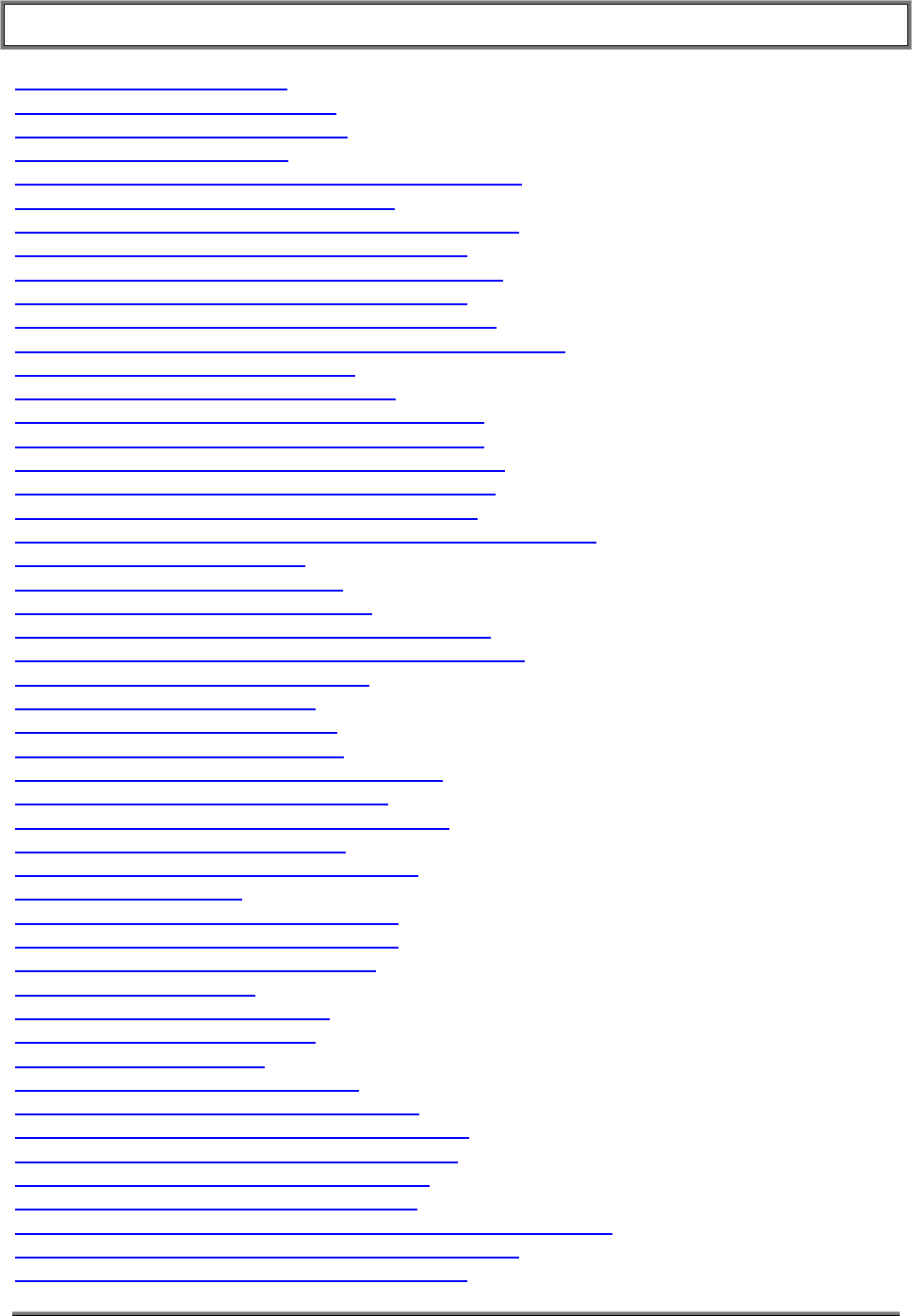
OpenCell Operations and Maintenance Manual Doc. No. XXXXXXX -
Page v
TRANSCEPT PROPRIETARY - DATA ON THIS PAGE SUBJECT TO RESTRICTIONS CITED ON COVER AND TITLE
FIGURE 8. RUC FRONT PANEL....................................................................................................... 17
FIGURE 9. C/MCPLR FRONT PANEL .............................................................................................. 18
FIGURE 10. C/MCPLR FRONT PANEL ............................................................................................ 19
FIGURE 11. PIC FRONT PANEL ...................................................................................................... 20
FIGURE 12. COMPACTPCI POWER SUPPLY FRONT PANEL ............................................................. 21
FIGURE 13. RAN RECTIFIER FRONT PANEL.................................................................................... 22
FIGURE 14. RAN RECTIFIER CONTROLLER FRONT PANEL.............................................................. 23
FIGURE 15. HUB DOWN CONVERTER FRONT PANEL....................................................................... 24
FIGURE 16. FORWARD SIMULCAST CARD FRONT PANEL ................................................................ 25
FIGURE 17. HUB DOWN CONVERTER FRONT PANEL....................................................................... 26
FIGURE 18. REVERSE SIMULCAST CARD FRONT PANEL.................................................................. 28
FIGURE 19. HUB COMPACTPCI POWER SUPPLY FRONT PANEL ..................................................... 29
FIGURE 20. DIGITAL I/O FRONT PANEL........................................................................................... 30
FIGURE 21. RF I/O MODULE FRONT PANEL ................................................................................... 31
FIGURE 22. HUB REFERENCE MODULE FRONT PANEL........................................................................I
FIGURE 23. HUB REFERENCE MODULE FRONT PANEL.................................................................... 32
FIGURE 24. ETHERNET HUB CONVERTER FRONT PANEL ................................................................ 33
FIGURE 25. POWER SUPPLY INTERFACE FRONT PANEL.................................................................. 34
FIGURE 26. BTS INTERFACE MODULE FRONT PANEL .........................................................................I
FIGURE 27. BTS INTERFACE RACK POWER SUPPLY FRONT PANEL ................................................ 36
FIGURE 28. MIB RELATIONSHIPS ................................................................................................... 37
FIGURE 29. HUB RAN MANAGEMENT ............................................................................................. 39
FIGURE 30. HUB MASTER MANAGEMENT........................................................................................ 40
FIGURE 31. SYSTEM MANAGEMENT – SINGLE SYSTEM................................................................... 41
FIGURE 32. SYSTEM MANAGEMENT – MULTIPLE SYSTEMS............................................................. 42
FIGURE 33. TENANT OAM INFO SELECT ........................................................................................ 51
FIGURE 34. SNMPC SET BUTTON.................................................................................................. 51
FIGURE 35. TENANT OAM INFO MIB.............................................................................................. 52
FIGURE 36. TENANT STATUS SELECT...........................................ERROR! BOOKMARK NOT DEFINED.
FIGURE 37. TENANT OAM INFO MIB, CHANNELS .........................ERROR! BOOKMARK NOT DEFINED.
FIGURE 38. TROUBLESHOOTING PROCESS...................................ERROR! BOOKMARK NOT DEFINED.
FIGURE 39. RAN COMPACTPCI SLOT POSITIONS ........................ERROR! BOOKMARK NOT DEFINED.
FIGURE 40. RAN FAN ACCESS DOOR ..........................................ERROR! BOOKMARK NOT DEFINED.
FIGURE 41. RAN FAN ACCESS DOOR – OPEN .............................ERROR! BOOKMARK NOT DEFINED.
FIGURE 42. FAN MODULE.............................................................ERROR! BOOKMARK NOT DEFINED.
FIGURE 43. PA PLACEMENT ON RAN DOOR.................................ERROR! BOOKMARK NOT DEFINED.
FIGURE 44. RAN PA FAN ACCESS CLOSED.................................ERROR! BOOKMARK NOT DEFINED.
FIGURE 45. RAN PA FAN ACCESS OPEN.....................................ERROR! BOOKMARK NOT DEFINED.
FIGURE 46. RAN PA FANS ..........................................................ERROR! BOOKMARK NOT DEFINED.
FIGURE 47. RAN PA FAN RELEASE .............................................ERROR! BOOKMARK NOT DEFINED.
FIGURE 48. RAN FUSE LOCATION................................................ERROR! BOOKMARK NOT DEFINED.
FIGURE 49. RAN FUSE BOX.........................................................ERROR! BOOKMARK NOT DEFINED.
FIGURE 50. RAN RECTIFIER MODULES........................................ERROR! BOOKMARK NOT DEFINED.
FIGURE 51. RAN RECTIFIER MODULE GUIDES .............................ERROR! BOOKMARK NOT DEFINED.
FIGURE 52. DIGITAL COMPACTPCI CHASSIS FRONT ....................ERROR! BOOKMARK NOT DEFINED.
FIGURE 53. DIGITAL COMPACTPCI CHASSIS REAR ......................ERROR! BOOKMARK NOT DEFINED.
FIGURE 54. RF COMPACTPCI CHASSIS FRONT ...........................ERROR! BOOKMARK NOT DEFINED.
FIGURE 55. RF COMPACTPCI CHASSIS REAR..............................ERROR! BOOKMARK NOT DEFINED.
FIGURE 56. HUB CPCI POWER SUPPLY WITH MODULE 2 EXTRACTEDERROR! BOOKMARK NOT DEFINED.
FIGURE 57. HUB COMPACTPCI POWER SUPPLY MODULE............ERROR! BOOKMARK NOT DEFINED.
FIGURE 58. HUB COMPACTPCI FAN ACCESS DOOR.....................ERROR! BOOKMARK NOT DEFINED.

OpenCell Operations and Maintenance Manual Doc. No. XXXXXXX -
Page vi
TRANSCEPT PROPRIETARY - DATA ON THIS PAGE SUBJECT TO RESTRICTIONS CITED ON COVER AND TITLE
FIGURE 59. HUB COMPACTPCI FAN ACCESS DOOR – OPEN........ERROR! BOOKMARK NOT DEFINED.
FIGURE 60. BIR POWER SUPPLY WITH MODULE EXTRACTED ........ERROR! BOOKMARK NOT DEFINED.
FIGURE 61. BIR POWER SUPPLY MODULE...................................ERROR! BOOKMARK NOT DEFINED.
FIGURE 62. FORWARD GAIN MANAGEMENT BALANCE...................ERROR! BOOKMARK NOT DEFINED.
FIGURE 63. REVERSE GAIN MANAGEMENT BALANCE....................ERROR! BOOKMARK NOT DEFINED.
LIST OF TABLES
Table Page
TABLE 1. UNUSED CHANNEL VALUES ............................................................................................. 52
TABLE 2. MAX. FORWARD GAIN SETTINGS AS FUNCTION OF #CHANNELS........................................ 54
TABLE 3. REVERSE GAIN SETTINGS ............................................................................................... 55
TABLE 4. SIF FAULTS ..................................................................ERROR! BOOKMARK NOT DEFINED.
TABLE 5. MULTICOUPLER FAULTS ................................................ERROR! BOOKMARK NOT DEFINED.
TABLE 6. RDC FAULTS ................................................................ERROR! BOOKMARK NOT DEFINED.
TABLE 7. RUC FAULTS ................................................................ERROR! BOOKMARK NOT DEFINED.
TABLE 8. PA FAULTS ...................................................................ERROR! BOOKMARK NOT DEFINED.
TABLE 9. PIC FAULTS ..................................................................ERROR! BOOKMARK NOT DEFINED.
TABLE 10. HDC FAULTS ..............................................................ERROR! BOOKMARK NOT DEFINED.
TABLE 11. HUC FAULTS ..............................................................ERROR! BOOKMARK NOT DEFINED.
TABLE 12. FSC FAULTS...............................................................ERROR! BOOKMARK NOT DEFINED.
TABLE 13. RSC FAULTS ..............................................................ERROR! BOOKMARK NOT DEFINED.
TABLE 14. FORWARD GAIN SPECIFICATIONS ................................ERROR! BOOKMARK NOT DEFINED.
TABLE 15. REVERSE GAIN SPECIFICATIONS .................................ERROR! BOOKMARK NOT DEFINED.
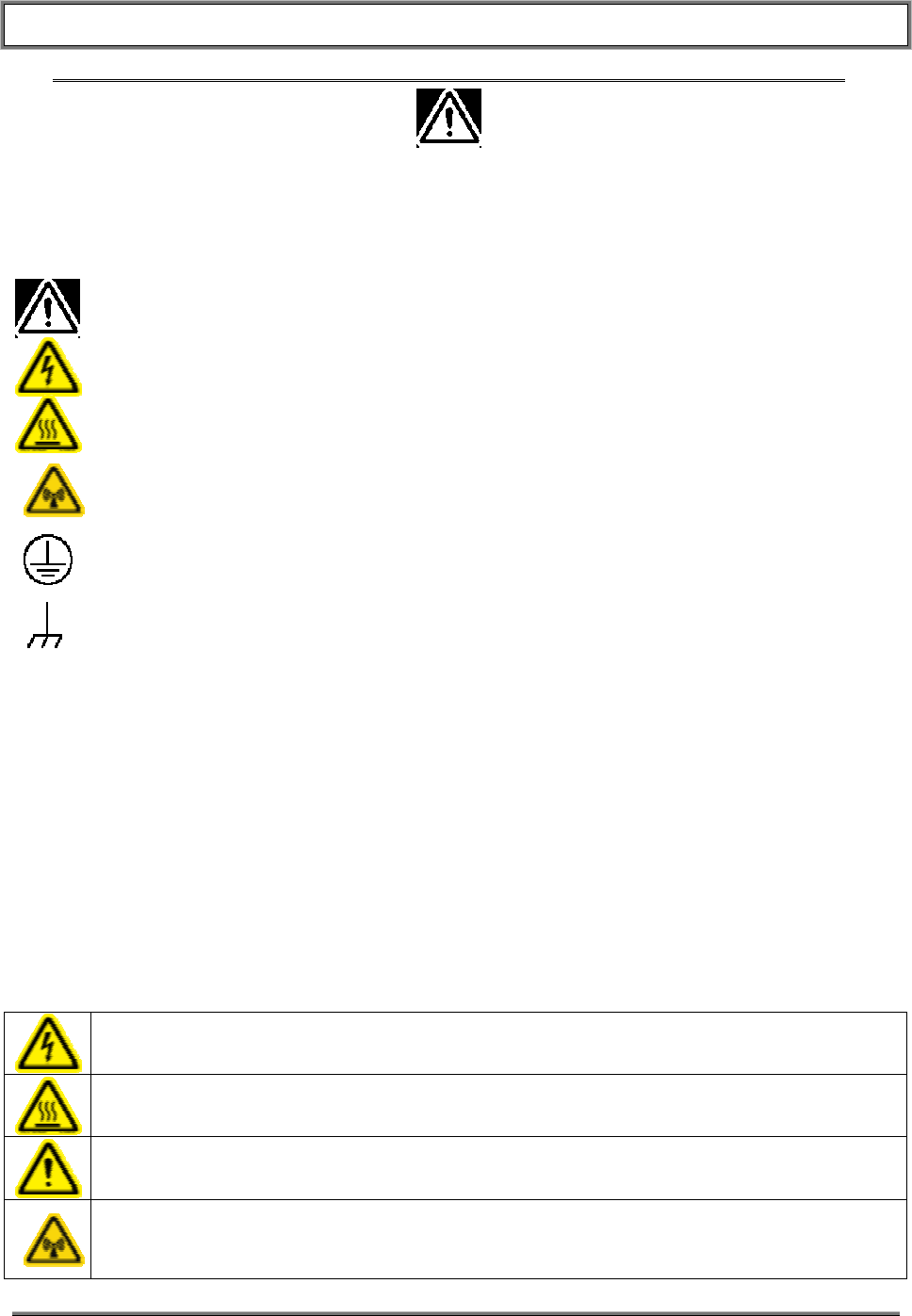
OpenCell Operations and Maintenance Manual Doc. No. XXXXXXX -
Page vii
TRANSCEPT PROPRIETARY - DATA ON THIS PAGE SUBJECT TO RESTRICTIONS CITED ON COVER AND TITLE
SAFETY CAUTIONS AND INSTRUCTIONS
Definitions of Symbols Used in this Manual
General Caution
Hazardous Voltage
Hot Surface
RF Hazard
Protective Earth Ground
Frame or Chassis Ground
RAN Installation
• Only trained and qualified personnel should install, replace, or service this equipment. This
includes service or replacement of cables and antennas.
• The RAN shall be installed and wired by licensed electricians in accordance with the National
Electrical Code and local building codes.
• Electrical service shall accommodate the RAN maximum load of 10 amps at 240 VAC, 60 Hz.
A readily accessible disconnect device must be incorporated near the point of power entry to
the main RAN enclosure.
• The RAN and antenna shall be bonded and grounded in accordance with National Electrical
Code requirements.
RAN Servicing Cautions
High voltages are present within the RAN enclosures. Use extreme caution when working
inside the equipment. Disconnect power to the equipment before servicing.
Exterior surface of the RAN may be hot. Use caution during servicing.
Do not work on the RAN or antenna or cables during lightning storms.
Caution This system is a RF transmitter and continuously emits RF energy. Maintain 3 foot
minimum clearance from the antenna while the system is operating. Wherever possible, shut
down the RAN before servicing.
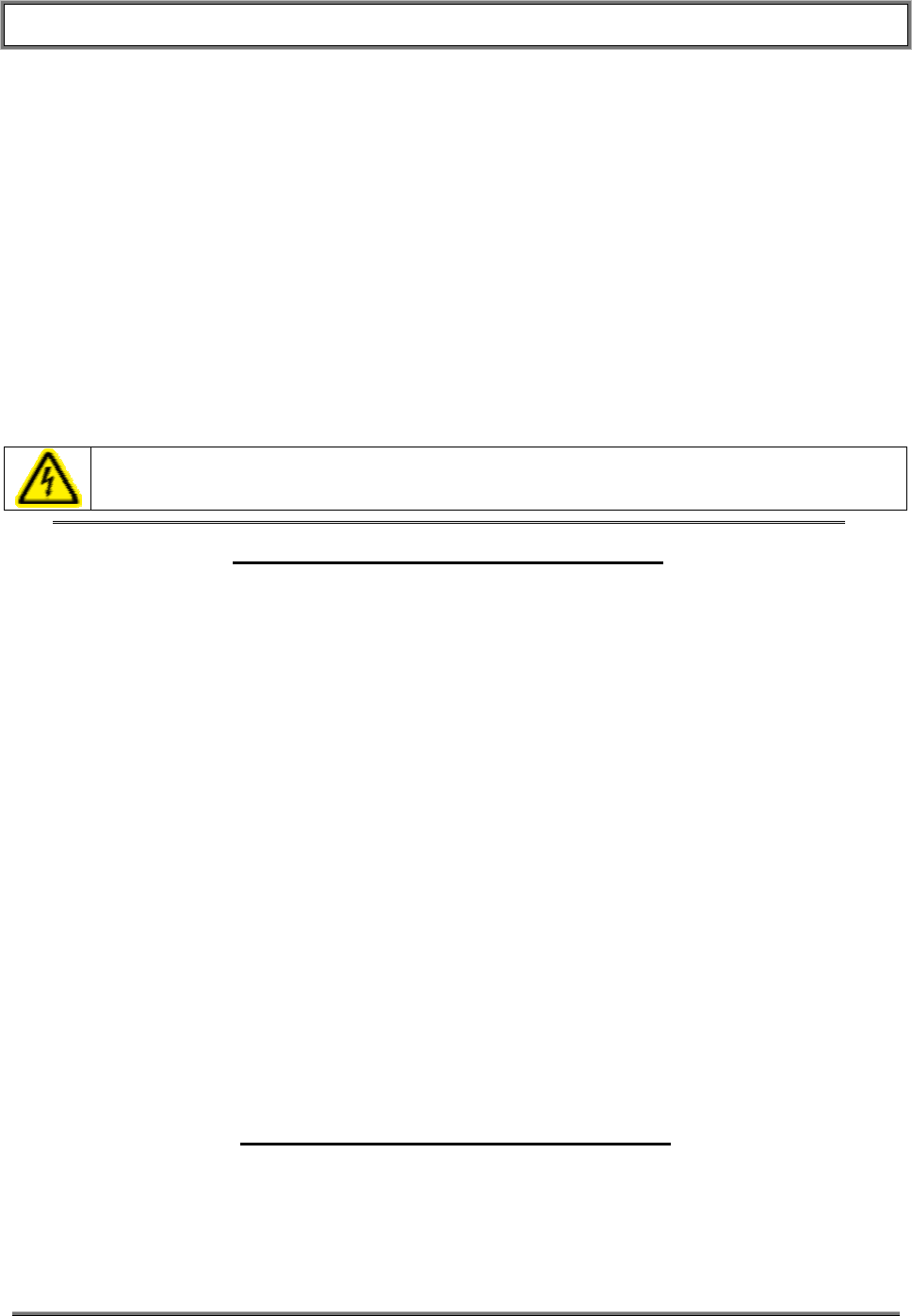
OpenCell Operations and Maintenance Manual Doc. No. XXXXXXX -
Page viii
TRANSCEPT PROPRIETARY - DATA ON THIS PAGE SUBJECT TO RESTRICTIONS CITED ON COVER AND TITLE
HUB Installation
• Only trained and qualified personnel should install, replace, or service this equipment.
• The OpenCell HUB shall be installed and wired by licensed electricians in accordance with the
National Electrical Code and local building codes.
• Electrical service shall accommodate the HUB FIR maximum load of 21(?) amps at –48 VDC,
and the HUB BIR maximum load of 7(?) amps at –48 VDC. A readily accessible disconnect
device must be incorporated near each point of power entry to each HUB rack.
• The HUB shall be bonded and grounded in accordance with National Electrical Code
requirements.
• The HUB grounding (earth) terminal provided is intended to connect the equipment frame
directly to local earth ground for personnel safety. To ensure proper operation of the
equipment, connect the earth terminal to the protective earth conductor only.
HUB Servicing Cautions
Hazardous voltages are present. The inverter located in the HUB FIR converts 12 volts to 120
VAC. Use caution when servicing the equipment.
FCC APPROVAL IN PROCESS
FCC License Data
The OpenCell RAN has been authorized for use as a RF device under parts 15, 22, and
24 of the FCC rules.
The OpenCell equipment complies with FCC rules when the antennas and cables having
characteristics and part numbers as specified in the instructions are used with the
system. The installer and operator are responsible for ensuring that only the specified
antennas and cables are used and properly installed.
Other than as specifically described in the product manuals, this product shall not be
changed or modified by the operator without the express approval of Transcept Inc.
Failure to do so may void the operator’s or provider’s authority to operate this
equipment.
NOTE: The OpenCell Hub has been tested and found to comply with the limits for a Class A
digital device, pursuant to Part 15 of the FCC Rules. These limits are designed to provide
reasonable protection against harmful interference when the equipment is operated in a
commercial environment. This equipment generates, uses, and can radiate radio frequency
energy and, if not installed and used in accordance with the instruction manual, may cause
harmful interference to radio communications. Operation of this equipment in a residential area
is likely to cause harmful interference in which case the user will be required to correct the
interference at his own expense.
FCC APPROVAL IN PROCESS

OpenCell Operations and Maintenance Manual Doc. No. XXXXXXX -
TRANSCEPT PROPRIETARY 1
1.0 INTRODUCTION
This manual contains the Operation and Maintenance procedures for the OpenCell
system.
1.1 ABOUT THIS MANUAL
1.1.1 Scope
1.1.2 Manual Organization
1.2 TERMINOLOGY, ACRONYMS AND ABBREVIATIONS
1.2.1 Notations Conventions
1.2.2 Acronyms and Abbreviations
Common Items (Hub or RAN)
CPU Central Processing Unit
NMS Network Management System
BTS Base Transceiver Station
BIF Backplane Interface
STF System Interface
SIF Synchronous Interface (Fiber Interface)
HUB Specific
FIR Fiber Interface Rack (formerly CompactPCI Rack)
BIR BTS Interface Rack
N/HDC Narrowband Hub Down Converter
W/HDC Wideband Hub Down Converter
FSC Forward Simulcast Card
RSC Reverse Simulcast Card
HUC Hub Up Converter
BIM Base Station Interface Module
HRM Hub Reference Module
RFIO RF Rear I/O
DIO Digital I/O
EHUB Ethernet Hub
PSI Power Supply Interface
BPS BIR Power Supply

OpenCell Operations and Maintenance Manual Doc. No. XXXXXXX -
TRANSCEPT PROPRIETARY 2
FPS FIR Power Supply
RAN Specific
RUC RAN Up Converter (Dual)
PA800 Power Amplifier(800 MHz)
PA1900 Power Amplifier(1900 MHz)
P/MCPLR PCS Multicoupler
C/MCPLR Cellular Multicoupler
RDC RAN Down Converter
PQP PCS Quadplexer
CTP Cellular Triplexer
CDP Cellular Diplexer
RECT Rectifier
GB Glitch Battery
RPS RAN CompactPCI Power Supply
LVD Low Voltage Disconnect
PIC Power Amplifier Interface Controller
ANT Multiband Antenna
BAT Battery Backup Batteries
RAN Basic Four Tenant RAN
ERAN Expansion Eight Tenant RAN
1.3 REFERENCE DOCUMENTATION
1.4 SYSTEM OVERVIEW
The Transcept OpenCell system is an open access network supporting multiple wireless
voice, data, video services and applications. Wireless Service Providers (WSP) and
Wireless Internet Service (WISP) Providers use Transcept OpenCell to either enhance
or replace existing networks, wired or wireless, or to develop new networks.
OpenCell is a multi-frequency, multi-protocol RF access network, providing microcellular
Cellular, PCS, and wireless data coverage via a distributed RF access system. The
OpenCell system is comprised of base station interfaces, located at hub locales,
connected via high speed datalinks to Radio Access Nodes, commonly referred to as
RANs, distributed over a geographical area of interest.
1.4.1 System Configuration
The following figure illustrates an OpenCell system with RANs distributed over a desired
geographical area, connected back to a group of WSP base stations at a Hub locale.
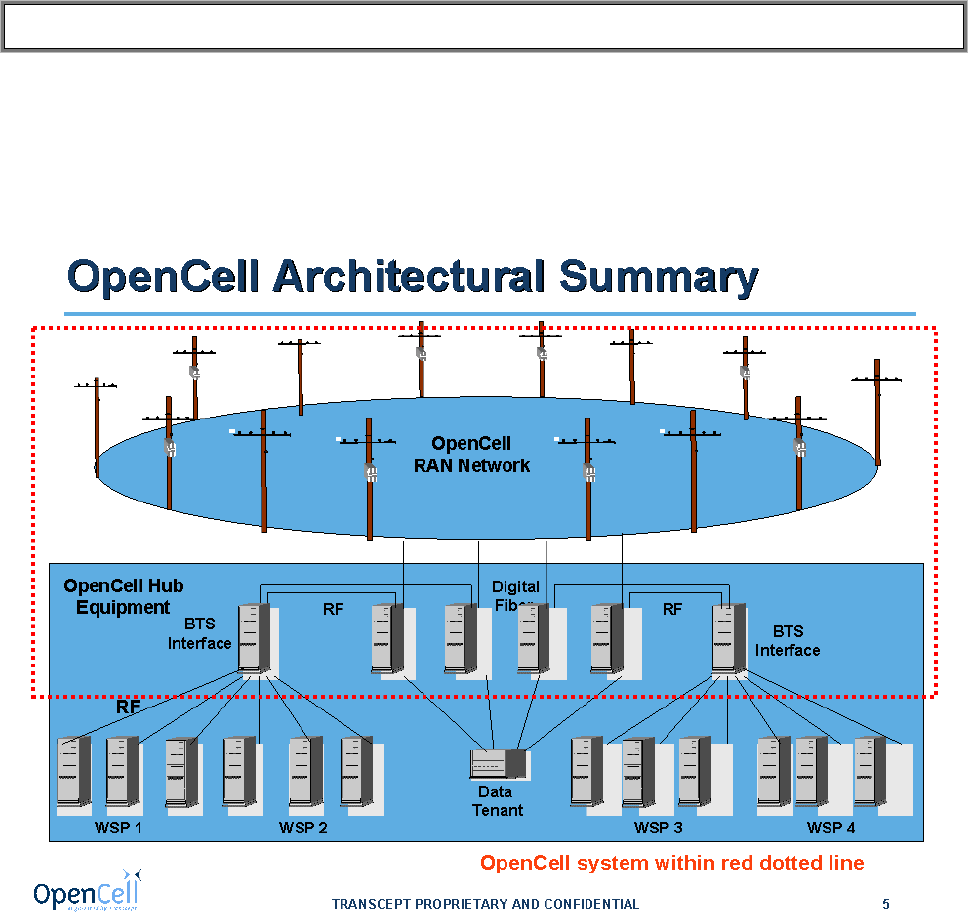
OpenCell Operations and Maintenance Manual Doc. No. XXXXXXX -
TRANSCEPT PROPRIETARY 3
The illustration shows utility pole mounted RANs, with pole top antennas. The OpenCell
Hub Equipment is comprised of a number of Base Station Interface Racks (BIR) and
Fiber Interface Racks (FIR) racks. The OpenCell Hub equipment provides the
interconnection between at the RF layer between the WSP base station sector(s) and
the OpenCell Radio Access Nodes.
Figure 1. OpenCell Architectural Summary Diagram
1.4.2 General Description
The OpenCell system can be implemented in a number of ways to address the RF
design objective of the WSP community. There are two classes of assemblies;
common system and WSP specific assemblies, in both the Hub and RAN locations.
This section of the document will describe what each assembly does and how it plays in
the system. The block diagram in Figure 2 shows the RF signal path through the
OpenCell system. The signal starts from the base station sector on the left flowing to the
right (arrows pointing right) and radiating out from the multi-band antenna to a mobile
subscriber. This is commonly referred to as the Forward Path. In the reverse direction,
or what is commonly referred to as the Reverse Path, the RF signal starts from a mobile
subscriber device, is received by the antenna and then flows from the RAN to the HUB
and to the base station sector receiver(s).
The following figure illustrates each of the major assemblies.
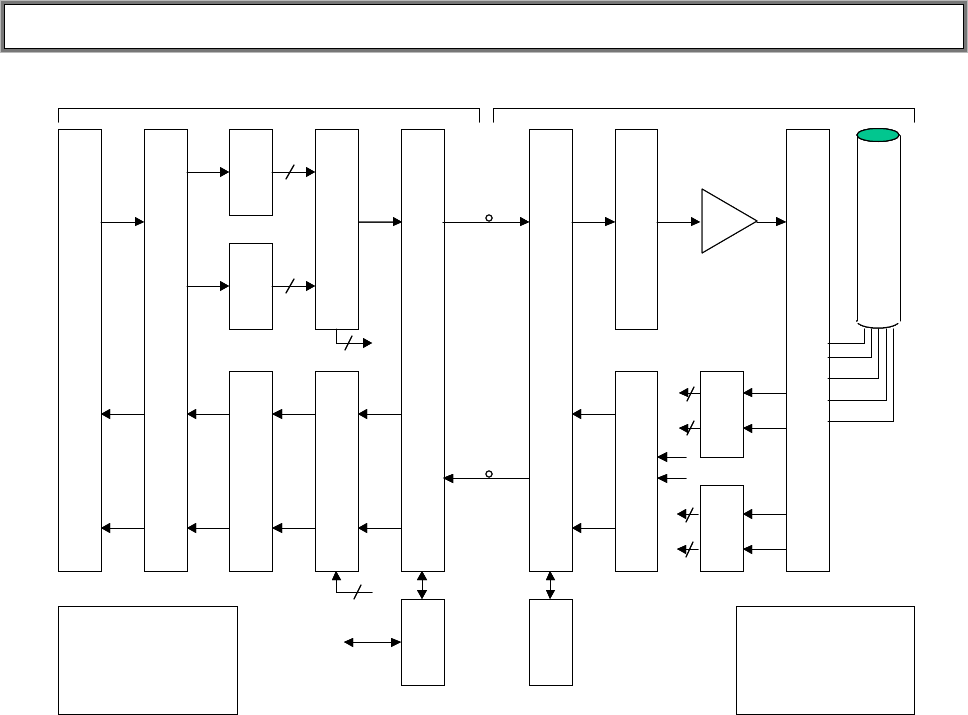
OpenCell Operations and Maintenance Manual Doc. No. XXXXXXX -
TRANSCEPT PROPRIETARY 4
BTS
Sector SIF SIF
HDC
BTS – Base Transceiver Station
HUB – Centralized Equipment Location
BIM – Base Station Interface Module
HDC – Hub Down Converter
FSC – Forward Simulcast Card
DIF – Digital Intermediate Frequency
SIF – Synchronous Interface
RSC – Reverse Simulcast Card
IF – Intermediate Frequency
HDC
FSC
BIM
RUC MCPA
HUB RAN
RAN – Remote Access Node
DIF – Digital Intermediate Frequency
SIF – Synchronous Interface
RUC – RAN Up Converter
MCPA –Multi-Carrier Power Amplifier
MPLX –Multi-plexer/combiner
MB ANT –Multi Band Antenna
MUL – Multi-coupler
RDC – RAN Down Converter
MPLX
MB
ANT
1900
MUL
800
MUL
RDCRSCHUC
4
4
6
6
CPU
Ethernet
CPU
Ethernet
3
3
Pri
Div
Pri
Div
GPS
1900-P
1900-D
800-P
800-D
Pri
Div
DIF DIF RF
IF
IF
RF
RF
Fwd
RF Fiber
Fiber
DIF
DIF
DIF
DIF
DIF
DIF
Ethernet
To NMS
RF
RF
Rev-P
RF
Rev-D
RF
7
DIF
6
DIF
RF
RF
BTS
Sector SIF SIF
HDC
BTS – Base Transceiver Station
HUB – Centralized Equipment Location
BIM – Base Station Interface Module
HDC – Hub Down Converter
FSC – Forward Simulcast Card
DIF – Digital Intermediate Frequency
SIF – Synchronous Interface
RSC – Reverse Simulcast Card
IF – Intermediate Frequency
HDC
FSC
BIM
RUC MCPA
HUB RAN
RAN – Remote Access Node
DIF – Digital Intermediate Frequency
SIF – Synchronous Interface
RUC – RAN Up Converter
MCPA –Multi-Carrier Power Amplifier
MPLX –Multi-plexer/combiner
MB ANT –Multi Band Antenna
MUL – Multi-coupler
RDC – RAN Down Converter
MPLX
MB
ANT
MB
ANT
1900
MUL
800
MUL
RDCRSCHUC
4
4
6
6
CPU
Ethernet
CPU
Ethernet
3
3
Pri
Div
Pri
Div
GPS
1900-P
1900-D
800-P
800-D
Pri
Div
DIF DIF RF
IF
IF
RF
RF
Fwd
RF Fiber
Fiber
DIF
DIF
DIF
DIF
DIF
DIF
Ethernet
To NMS
RF
RF
Rev-P
RF
Rev-D
RF
7
DIF
6
DIF
RF
RF
Figure 2. OpenCell Block Diagram
The Block diagram shows the functional flow and where each component of the
OpenCell system resides. The following paragraphs in section 1.4.3 and 1.4.4 will
describe each components function and contribution to the OpenCell system.
1.4.3 Hub Subsystem Assemblies
The Hub is comprised of two rack types. These include the Base Station Interface Rack,
referred to as the BIR and the Fiber Interface Rack, commonly referred to as the FIR.
The BIR is houses the following modules in varying quantities;
1) BIR Power Supply Module. This module provides the 12V necessary to
power the base station interface modules, referred to as a BIM. Each BIR
power supply module is comprised of a hot-swappable shelf design and two
(2) power modules.
One BIR Power Supply Module is required per 12 BIMs, or one rack
2) Base Station Interface Module, or BIM. The BIM is a multi-port transition
module used to interface with the WSP’s base station sector. The BIM
accepts either duplexed or simplexed RF from the base station sector and
provides the to the OpenCell RF section separate transmit and receive paths.
The BIM is unity gain, with a nominal noise figure of 5dB, contributing
negligible noise in the reverse path.

OpenCell Operations and Maintenance Manual Doc. No. XXXXXXX -
TRANSCEPT PROPRIETARY 5
The FIR is houses the RF signal processing and and data transport modules. There are
two primary chassises in the FIR, referred to as the Digital and RF chassis. The Digital
and RF chassis follow CompactPCI standards for form, size and functionality.
The Digital Chassis houses the following circuit cards;
1) The CPU
2) The System Interface card, STF
3) The Wideband Digital Optical Transport card, WBDOT
4) The Reverse Simulcast card, RSC
5) ‘CompactPCI Power Supply
The functionality of each of these card assemblies will be defined in the following
section.
The RF Chassis houses the following circuit cards;
1) The Hub DownConverter card, HDC
2) The Hub UpConverter card, HUC
3) The Forward Simulcast card, FSC
4) CompactPCI Power Supply
The functionality of each of these card assemblies will be defined in the following
section.
1.4.3.1 Base Station Interface Module (BIM)
The Base Station Interface Module provides the following BTS interface functionality:
1. Interface to a high power forward BTS path
2. Interface to a low power forward BTS path
3. Handles duplexed and non-duplexed signals
4. Added gain to adjust for different reverse path configurations
The BIM is controlled via an I2C connection from its CPU.
1.4.3.2 BIR Power Supply
The BIRPS provides +12VDC for all BTS Interface Modules.
1.4.3.3 Central Processing Unit (CPU)
The Hub CPU is a x86 machine with hard disk running LINUX. The Hub CPU performs
the following functions:
1. Master Hub Process controlling all Tenant specific functions
2. Manages a subset of Hub hardware including RF and Digital equipment
3. Manages RANs connected to it Hub managed hardware.

OpenCell Operations and Maintenance Manual Doc. No. XXXXXXX -
TRANSCEPT PROPRIETARY 6
1.4.3.4 System Interface (STF)
The System Interface (STF) module provides the ability to communicate between the
CPU and other modules (HDC, FSC, HUC, PSI, BMI & HRM) using four I2C busses.
The STF also communicates with the GPS module found in the Master Hub Reference
Module.
The four I2C busses are accessible via the CompactPCI backplane or via front panel
connectors.
1.4.3.5 Synchronous Interface (SIF)
The Synchronous Interface module provides the fiber interface between the Hub and
RANs. This interface includes:
1. RF Signal information
2. 10BaseT Ethernet for command and control between Hub and the RANs.
1.4.3.6 Hub Down Converter (HDC)
The HDC down converts the forward RF channel to an intermediate frequency (IF) that
can be digitized. Each HDC can support up to four separate RF channels. A second
HDC may be installed to support 8 RF channels.
1.4.3.7 Forward Simulcast Card (FSC)
The Forward Simulcast card converts the IF signals from the HDC to Digitized IF(DIF)
format. There are eight separate analog to digital conversion circuits on an FSC.
1.4.3.8 Reverse Simulcast Card (RSC)
The RSC sums the Digital IF (DIF) from up to eight RANs into a single DIF signal that is
sent to the HUC for conversion to RF.
1.4.3.9 Hub Up Converter (HUC)
The HUC accepts two Digital IF (DIF) signals from a SIF or RSC. The DIF signals are
digital to analog converted and translated to a pair of RF signals (diversity).
1.4.3.10 Hub Reference Module (HRM)
The HRM generates the RF reference and fiber clocking for distribution within a Fiber
Interface Rack. In addition, it contains a GPS that generates a 1PPS for distribution to
the Digital equipment for delay management.
1.4.3.11 Ethernet Hub
Each FIR rack is equipped with a 24 port Ethernet Hub, at the top of the rack, below the
HRM.
1.4.3.12 RF I/O Module (RFIO)
The RFIO provides the ability for a CPU to communicate with an I2C device in another
chassis. Each STF module and HUC has an RFIO installed in the rear of the chassis.
Cables connect the RFIO modules I2C connections. In addition, the RFIO is used to
provide clock and reference to all CompactPCI chassis for use by the boards.

OpenCell Operations and Maintenance Manual Doc. No. XXXXXXX -
TRANSCEPT PROPRIETARY 7
1.4.3.13 Digital I/O Module (DIO)
The DIO provides the ability for connecting DIF signals between multiple CompactPCI
chassis. Cables are used to connect the DIO modules DIF connections.
1.4.3.14 RF CompactPCI Chassis & Backplane
The CompactPCI RF Chassis houses the RF transceiver modules, HUC and HDC, and
the Forward Simulcast Module. The backplane provides the distribution for clock,
communication and control data and timing. RF and digital RF signals are
interconnected between modules using the appropriate cabling. The appropriate data
signal cabling is provided to interconnect the RF Chassis backplane to the STF in the
Digital Chassis.
1.4.3.15 Digital CompactPCI Chassis & Backplane
The CompactPCI RF Chassis houses the CPU, System Interface Module, and Reverse
Simulcast Module. The backplane provides the distribution for clock, communication
and control data and timing. The digital RF signal from the RSC is interconnected to the
HUC in the RF Chassis using the appropriate cabling.
1.4.3.16 FIR CompactPCI Power Supply
Each CompactPCI chassis has its own power supply. Eech supply has modules that
support N+1 redundancy. The supply provides +/-12V, 5V and 3.3V DC.
1.4.3.17 Power Supply Interface (PSI)
The PSI is used to monitor the discrete outputs from the BIR anf FIR power supplies.
The CPU communicates with this module using an I2C interface.
1.4.3.18 Ethernet Hub Power Inverter (EHPI)
The EHPI provides 120VAC for the Ethernet Hub in each Fiber Interface Rack. The
input is 12VDC.
1.4.4 RAN Subsystem Assemblies
1.4.4.1 Central Processing Unit (CPU)
The RAN CPU is a x86 machine with hard disk running LINUX. The RAN CPU performs
the following functions:
1. Manages all RAN hardware including RF and Digital equipment
1.4.4.2 System Interface (STF)
The System Interface (STF) module provides the ability to communicate between the
CPU and other modules (RDC, RUC, PIC) using four I2C busses. The STF also
contains the GPS module.
1.4.4.3 Synchronous Interface (SIF)
The Synchronous Interface module provides the fiber interface between the Hub and
RANs. This interface includes:
1. RF Signal information
2. 10BaseT Ethernet for command and control between Hub and the RANs.

OpenCell Operations and Maintenance Manual Doc. No. XXXXXXX -
TRANSCEPT PROPRIETARY 8
1.4.4.4 RAN Down Converter (RDC)
The RDC is a dual-diversity wideband receiver that converts PCS, Cellular and SMR800
signals to digitized IF. It also includes a CW test tone used in reverse continuity testing.
1.4.4.5 RAN Up Converter (RUC)
The RAN Up Converter converts digitized IF into PCS, Cellular and SMR frequency
bands. Each RUC supports two simultaneous wideband outputs.
1.4.4.6 RAN Chassis & Backplane
The RAN chassis is a standard CompactPCI unit. The backplane supports the basic
CompactPCI functions and has been extended to allow the routing of DIF, reference
clocks and I2C signals between CompactPCI modules.
1.4.4.7 CompactPCI Power Supply (RPS)
The CompactPCI Power Supplies provide +/-12V, 5V and 3.3 V DC power to the
CompactPCI backplane for use by CompactPCI modules. These units are redundant
and hot swappable.
1.4.4.8 RAN Rectifier (RCT)
The RAN rectifier converts 240 VAC prime power into –48VDC for use with the RAN. It
also manages the batteries (glitch or 2hr).
1.4.4.9 Power Amplifier (PA)
The Power Amplifiers are multi-carrier and can provide up to 10 watts (total) for a given
Tenant. Different units are used for PCs, Cellular and SMR800.
1.4.4.10 PA Interface Controller (PIC)
The PA Interface Controller is managed by the CPU over an I2C connection. The PIC
interfaces to the discrete signals of the Power Amplifier. The PIC also converts from -
48VDC to +12VDC or +28VDC depending upon which PA is being used. Each PA has
its own PIC module.
1.4.4.11 Multiplexers
The multiplexers consist of four units that interface the antenna to the RAN PAs and
multicouplers. There are four types found in every RAN:
1. Quadplexer Primary (PCS Bands A, B, F), interfaces to PCS primary antenna
2. Quadplexer Diversity (PCS Bands D, E, C), interfaces to PCS diversity antenna
3. Triplexer Primary (Cellular Band B, SMR800 band), interfaces to 800 MHz
primary antenna
4. Diplexer Diversity (Cellular Band A), interfaces to 800 MHz diversity antenna
1.4.4.12 PA Fans
These fans are mounted in the RAN door shroud and provide the cooling of the PAs
mounted on the door by blowing external air across heatsink. They are controlled by a
thermistor mounted to the door heatsink. The STF module monitors the TAC outputs of
the fans.

OpenCell Operations and Maintenance Manual Doc. No. XXXXXXX -
TRANSCEPT PROPRIETARY 9
1.4.4.13 Fuses
There are 6 fuses in the RAN that protect the –48VDC distribution:
1. Four 15 amp fuses for the PA/PICs
2. 1 15 amp fuse for the CompactPCI chassis
3. 1 5 amp fuse for the fans
1.4.4.14 Battery Backup (BB)
The battery backup system consists of a –48VDC battery string (4 batteries) contained in
a separate enclosure that provides up to 2 hours of backed up power for the RAN.
1.4.4.15 Glitch Batteries (GB)
The glitch battery system consists of –48VDC battery string contained within the RAN
and can provide 5 minutes of backed up power for the RAN.
1.4.4.16 Multicoupler (PCS and Cell)
The multicouplers interface to the multiplexer system and contain the front end low noise
amplifiers for the reverse path. They are dual-diversity receive for the PCS and 800
MHZ bands. The PCS band has 12 outputs (bands A-F, with diversity). The 800 MHz
has 6 outputs (Cell bands A,B and SMR800, with diversity).
1.4.4.17 Antenna (ANT)
The multiband antenna is designed reside on the top of a utility. It will interface with the
PCS and Cellular/SMR bands and contains diversity receive paths. Also included is the
GPS antenna used by the RAN.
1.4.5 Communication Interfaces
1.4.5.1 I2C
I2C is a two-wire, bidirectional serials bus that provide a simple, efficient method of data
exchange between devices. It is primarily used in the consumer and telecom market
sector and as a board level communications protocol.
I2C interfaces are used for communication to the following modules:
1. Hub - HDC, FSC, HUC, BIM, PSI
2. RAN - RDC, RUC, PIC
1.4.5.2 Network Interface
The Hub CPUs are able to communicate to any other CPU in the Hub over an Ethernet
LAN. Ethernet connections are aggregated with each rack via an Ethernet Hub. Intra-
rack communication is possible by connecting the Ethernet Hubs between racks.
Each SIF has an 10BaseT Ethernet connection. The Hub CPUs are able to
communicate with the RANs over this Ethernet connection.
1.4.5.3 SNMP/IP
SNMP/IP is the primary interface to the OpenCell equipment for performing OA&M
functions.
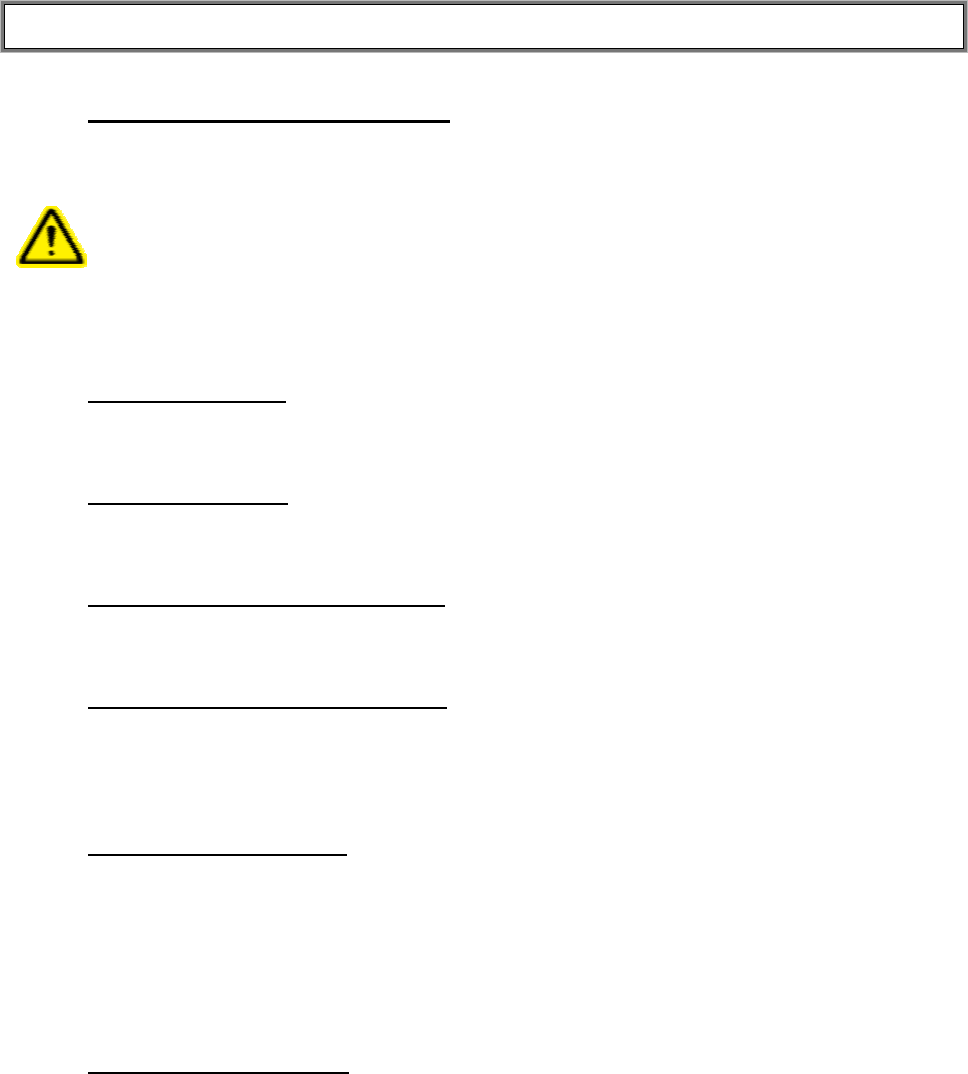
OpenCell Operations and Maintenance Manual Doc. No. XXXXXXX -
TRANSCEPT PROPRIETARY 10
2.0 POWER ON/OFF PROCEDURES
This section contains the procedures for powering on and off OpenCell equipment.
Warning
The CPU is not Hot Swappable. Damage can occur if attempted. Insure tbat the CPU
is installed before applying power to system
2.1 HUB POWER-ON/OFF
Hub Rack Power On
1. Power to the Hub racks (BIR or FIR) is enabled at the Power Distribution Unit
(PDU).
Hub Rack Power Off
1. Power to the Hub racks (BIR or FIR) is disabled at the Power Distribution Unit
(PDU).
Hub CompactPCI Chassis Power On
1. Power to a CompactPCI chassis enabled by inserting the modules within the
power supply below the chassis
Hub CompactPCI Chassis Power Off
1. Power to a CompactPCI chassis disabled by extracting the modules within the
power supply below the chassis
2.2 RAN POWER ON/OFF
RAN Equipment Power On
1. Turn circuit breaker on at the load center located near the bottom of the utility
pole AND switch the rectifiers AC switch, located in the top section of the RAN, to
the ON position
2. The DC power, from either the glitch battery or the two hour battery must also be
connected. Connecting the “molex” type connector at the contactor does this.
See picture below.
RAN Equipment Power Off
1. Turn the circuit breaker off at the load center located near the bottom of the utility
pole OR switch the rectifiers AC switch, located in the top section of the RAN, to
the OFF position
2. The DC power, from either the glitch battery or the two hour battery must also be
disconnected. Disconnecting the “molex” type connector at the contactor does
this. See picture below.
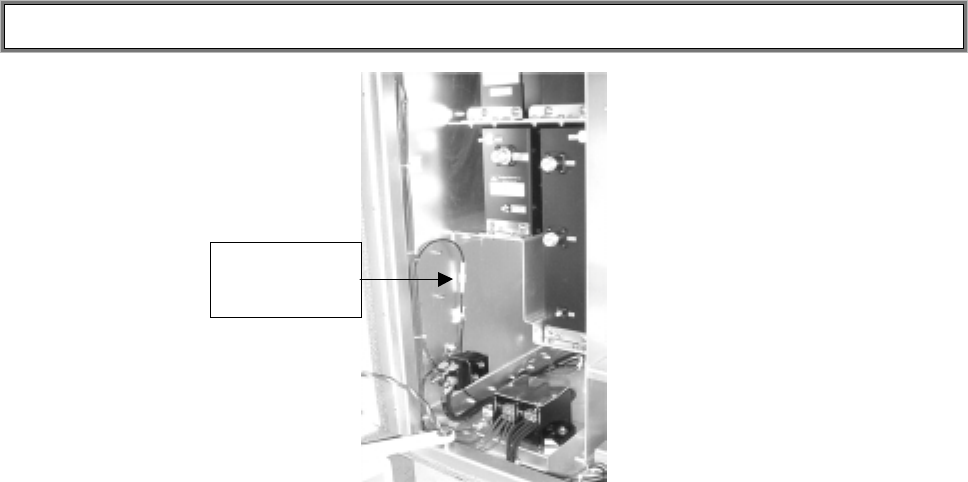
OpenCell Operations and Maintenance Manual Doc. No. XXXXXXX -
TRANSCEPT PROPRIETARY 11
Figure 3. Battery LVD Disconnect Plug
Disconnect
Plug
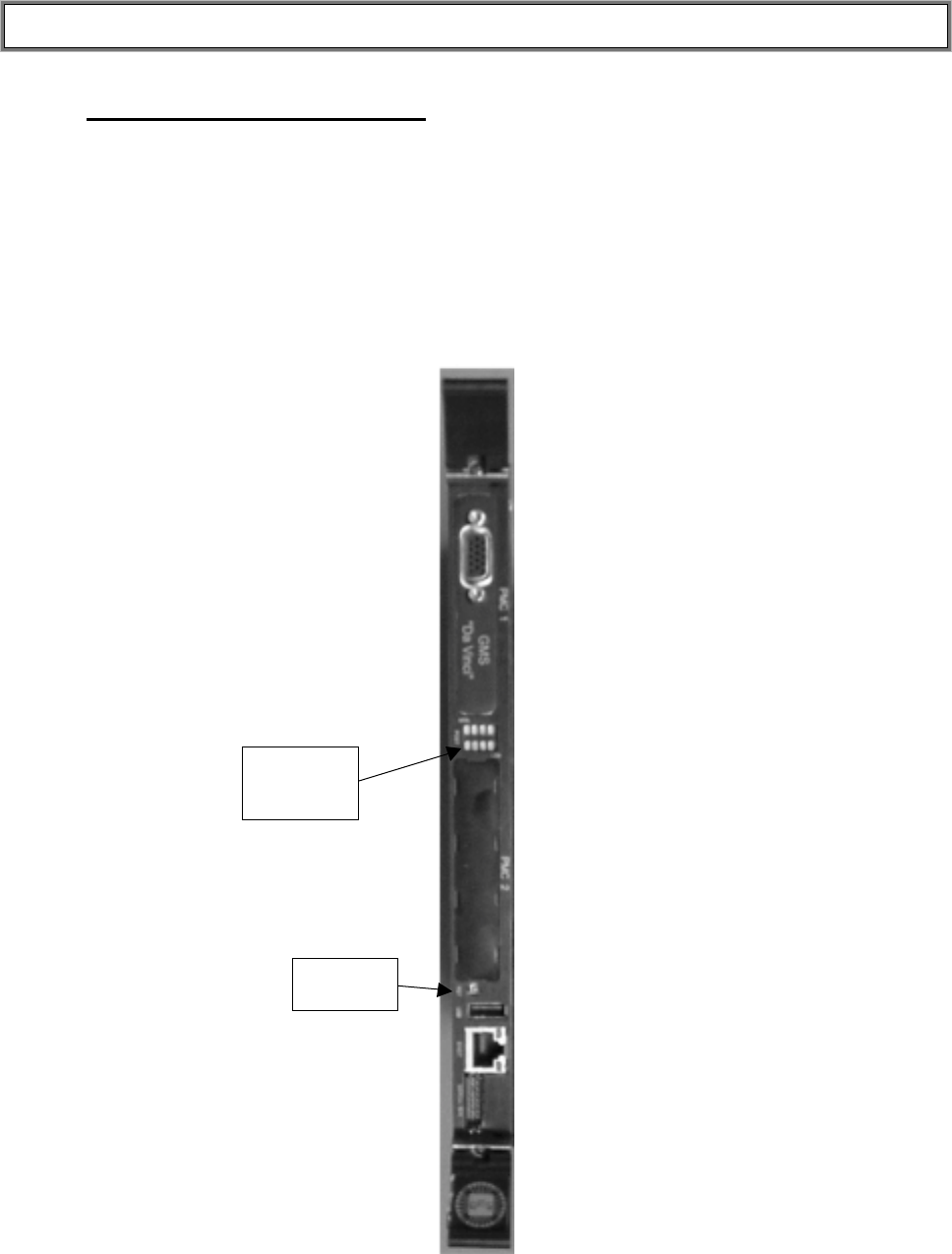
OpenCell Operations and Maintenance Manual Doc. No. XXXXXXX -
TRANSCEPT PROPRIETARY 12
3.0 CONTROLS AND INDICATORS
3.1 COMMON TO HUB AND RAN
3.1.1 CPU
The front panel controls for the CPU are:
• Reset – Recessed reset button
The front panel indicators for the CPU are:
• Activity LEDs – 8 Yellow LEDs flashing when the OS is operating
Figure 4. CPU Front Panel
Activity
LEDs
Reset
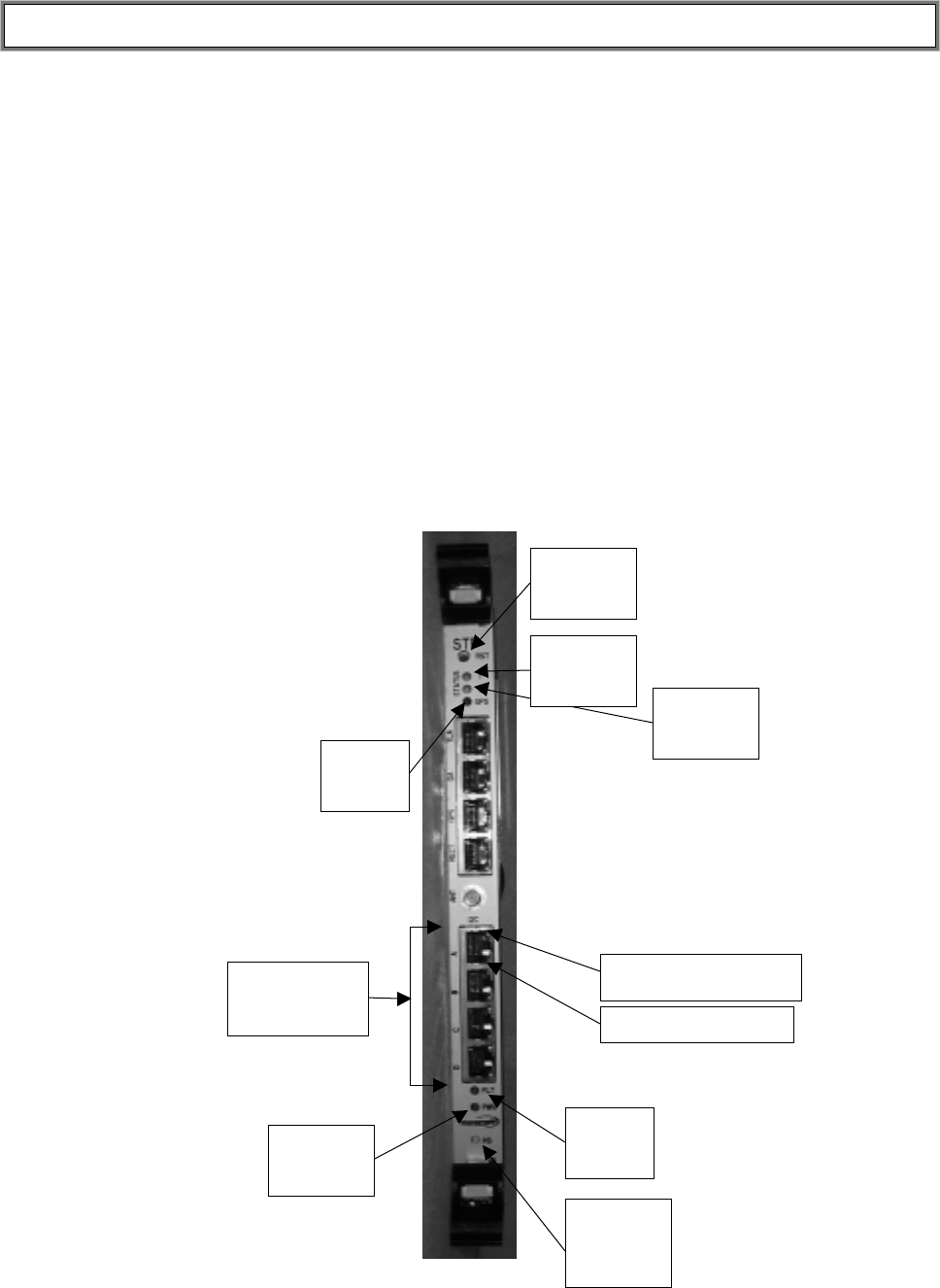
OpenCell Operations and Maintenance Manual Doc. No. XXXXXXX -
TRANSCEPT PROPRIETARY 13
3.1.2 STF
The front panel controls for the System Interface are:
• RST – Reset switch, recessed button
The front panel indicators for the System Interface are:
• Status LED 1/2 – Yellow LED. Reserved for future use.
• GPS LED – Green LED indicating 1PPS (Ran only)
• FLT LED – Red LED lighted when module is failed
• PWR LED – Green LED lighted when module has power
• I2C Comm LED – On each I2C RJ-45 connector. Green LED lighted when I2C
message sent, red LED when no response on interface
• I2C Error LED – On each I2C RJ-45 connector. Red LED when no response on
interface
• HS LED – Blue LED, turns blue when board can be hot swap extracted
Figure 5. STF Front Panel
I2C
Connectors
I2C Comm LED
I2C Error LED
Power
LED
Fault
LED
Hot
Swap
LED
GPS
LED
Status
LED 2
Status
LED 1
Reset
Switch

OpenCell Operations and Maintenance Manual Doc. No. XXXXXXX -
TRANSCEPT PROPRIETARY 14
3.1.3 SIF
The front panel indicators for the Synchronous Interface are:
• In 1-4 LED – DIF Input Tri-color LED
o Off = Interface not enabled
o Green = good
o Yellow = bad
o Red = bad
o Flashing = Interface is in and out of lock
• Out 1-4 LED – DIF Output Tri-color LED
o Off = Interface not enabled
o Green = good
o Yellow = N/A
o Red = bad data on DIF input caused by Alarm Indication Signal (AIS)
• OP IN LED – Optical Input Tri-color LED
o Green = good
o Yellow = N/A
o Red = bad, bad framing, bad parity, no signal
• OP OUT LED – Optical Output Tri-color LED
o Green = good
o Yellow = N/A
o Red = bad output
• FLT LED – Red fault LED lighted when module is failed
• PWR LED – Green Power LED lighted when module has power
• HS LED – Hot Swap Blue LED, turns blue when board can be hot swap extracted
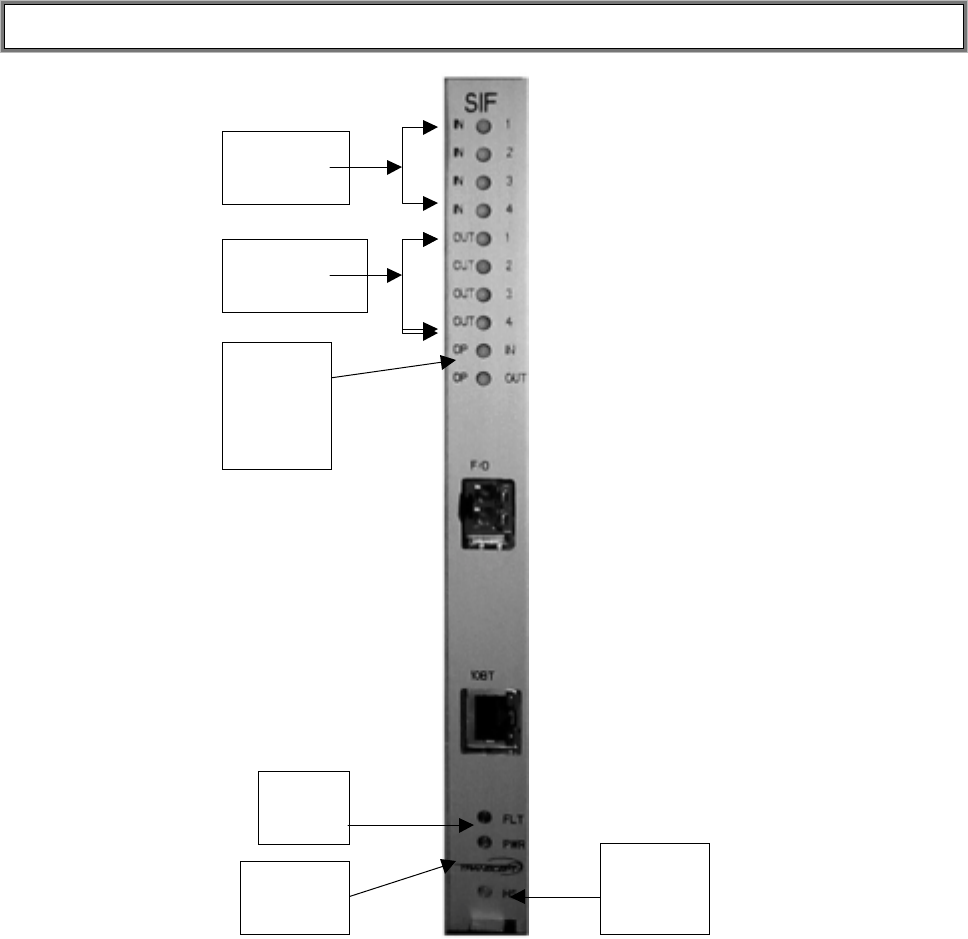
OpenCell Operations and Maintenance Manual Doc. No. XXXXXXX -
TRANSCEPT PROPRIETARY 15
Figure 6. SIF Front Panel
Optical
Input/
Output
LEDs
DIF Output
LED 1-4
DIF Input
LED 1-4
Hot
Swap
LED
Power
LED
Fault
LED
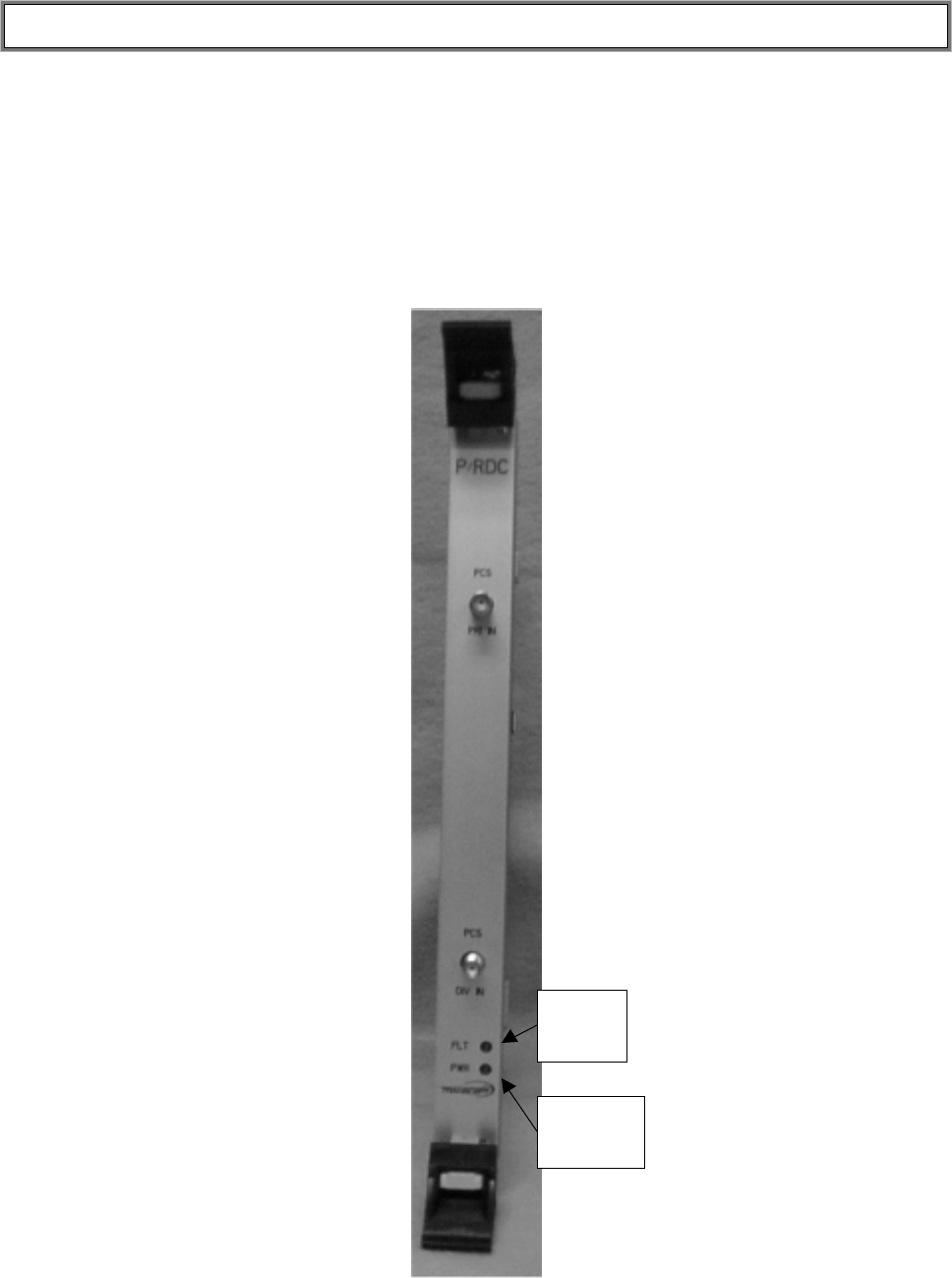
OpenCell Operations and Maintenance Manual Doc. No. XXXXXXX -
TRANSCEPT PROPRIETARY 16
3.2 RAN
This section describes the various controls and indicators for RAN specific modules.
3.2.1 RDC
The front panel indicators for the RAN Down Converter are:
• FLT LED – Red LED lighted when module is failed
• PWR LED – Green LED lighted when module has power
Figure 7. RDC Front Panel
Power
LED
Fault
LED

OpenCell Operations and Maintenance Manual Doc. No. XXXXXXX -
TRANSCEPT PROPRIETARY 17
3.2.2 RUC
The front panel indicators for the RAN Up Converter are:
• COM 1/3 – Yellow LED indicting I2C communications to PICs 1/3
• COM 2/4 – Yellow LED indicting I2C communications to PICs 2/4
• FLT LED – Red LED lighted when module is failed
• PWR LED – Green LED lighted when module has power
Figure 8. RUC Front Panel
Power
LED
Fault
LED
COM 2/4
LED
COM 1/3
LED
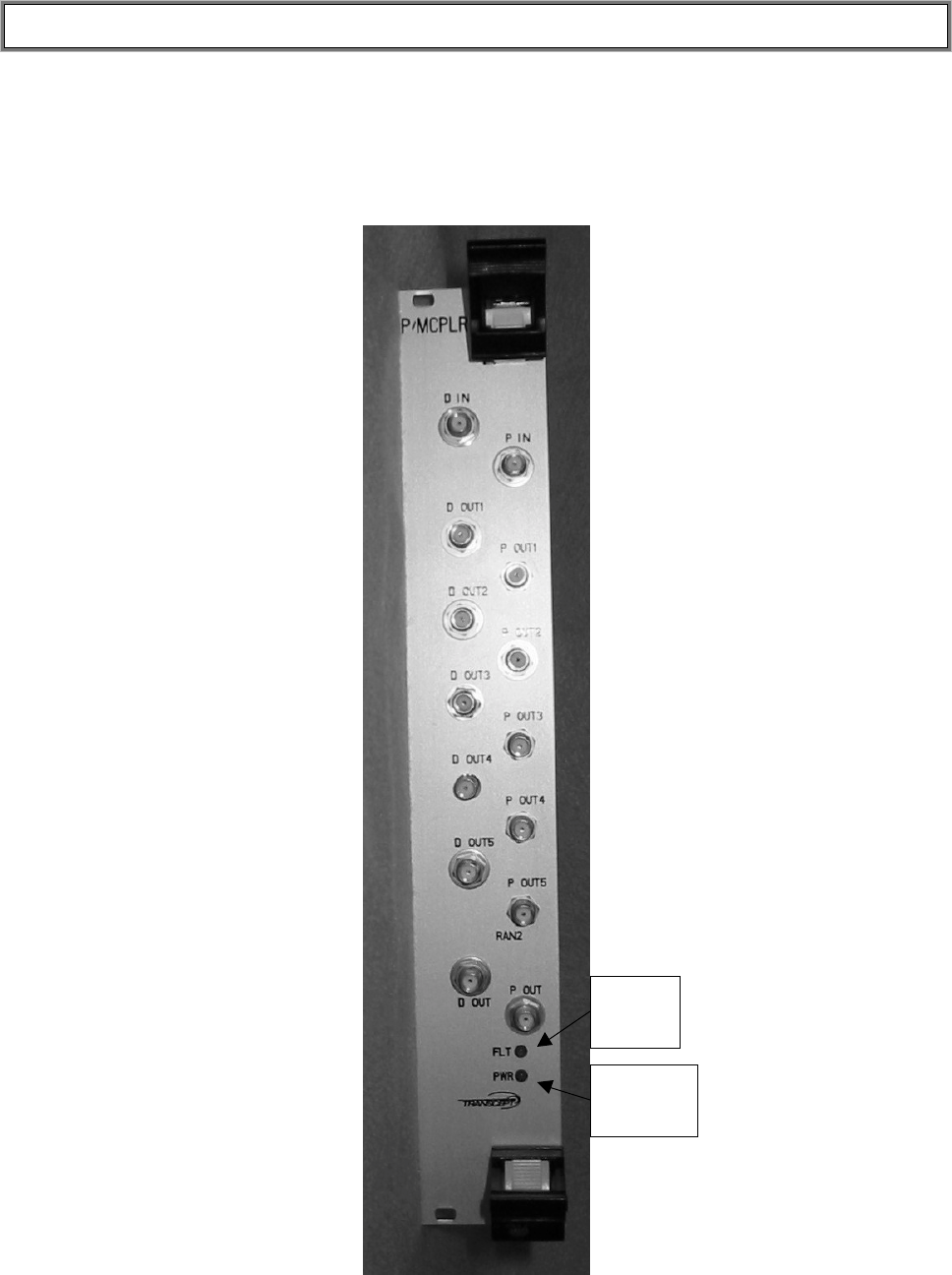
OpenCell Operations and Maintenance Manual Doc. No. XXXXXXX -
TRANSCEPT PROPRIETARY 18
3.2.3 P/MCPLR
The front panel indicators for the PCS Multicoupler are:
• FLT LED – Red Fault LED lighted when module is failed
• PWR LED – Green Power LED lighted when module has power
Figure 9. C/MCPLR Front Panel
Power
LED
Fault
LED
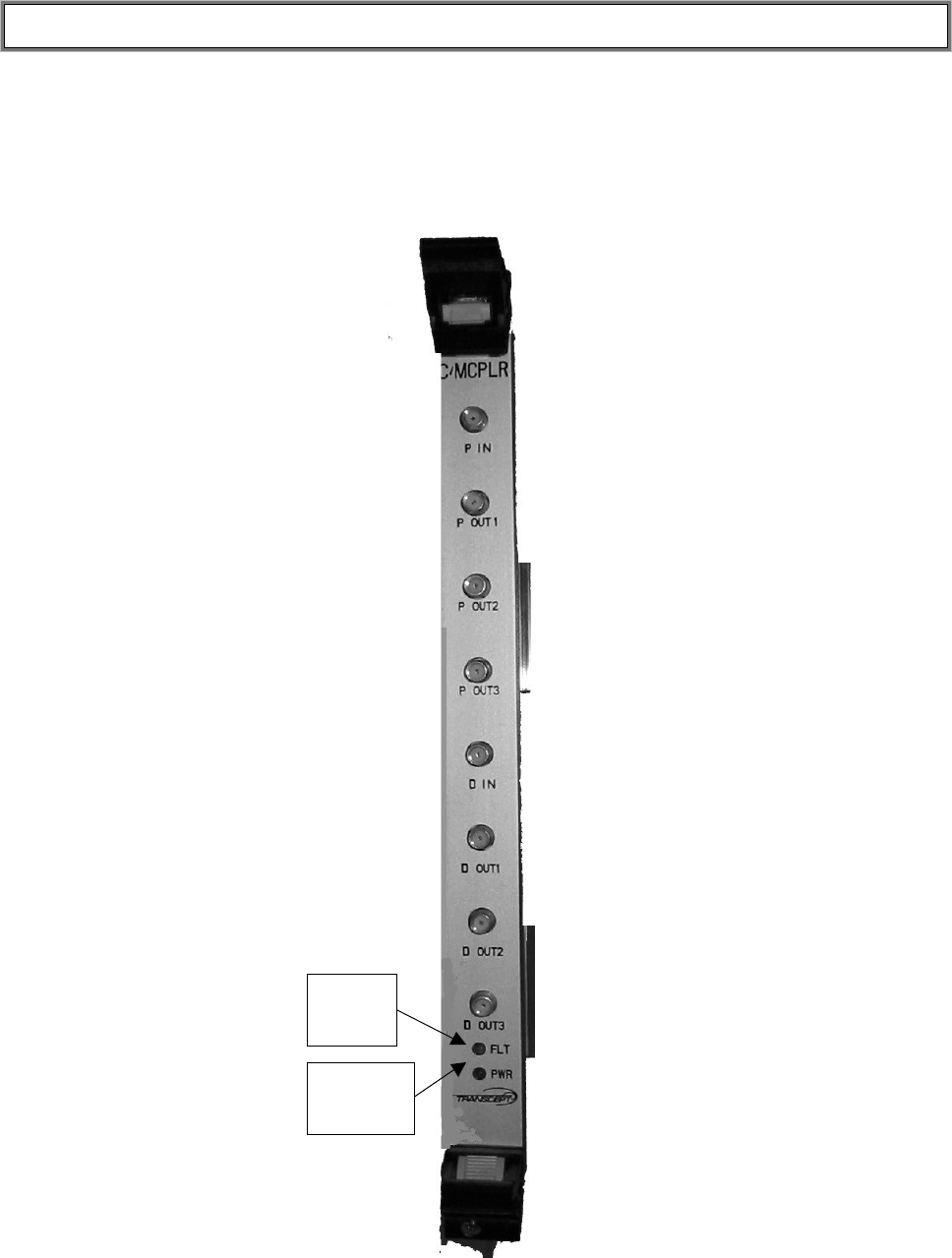
OpenCell Operations and Maintenance Manual Doc. No. XXXXXXX -
TRANSCEPT PROPRIETARY 19
3.2.4 C/MCPLR
The front panel indicators for the Cellular Multicoupler are:
• FLT LED – Red LED lighted when module is failed
• PWR LED – Green LED lighted when module has power
Figure 10. C/MCPLR Front Panel
Fault
LED
Power
LED
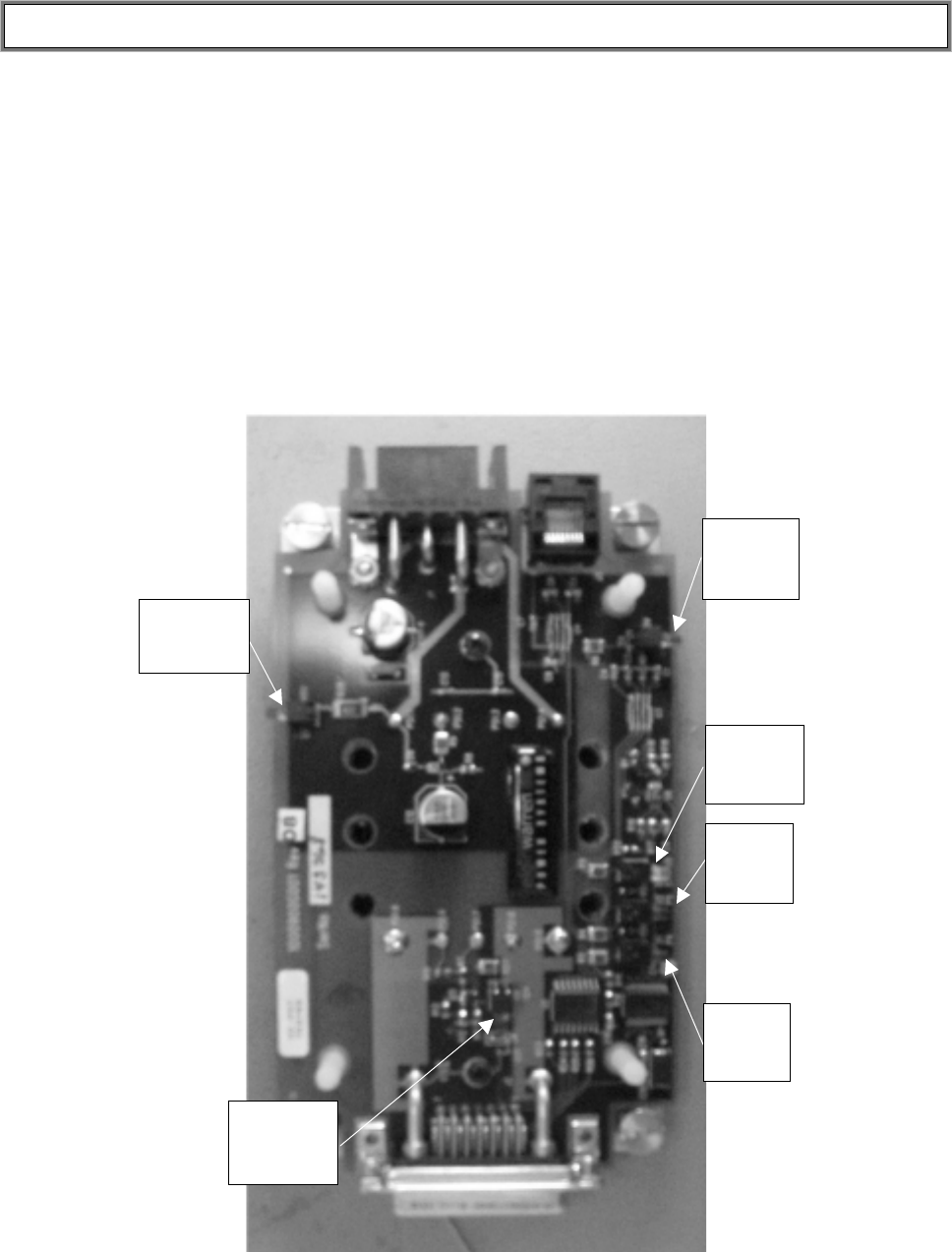
OpenCell Operations and Maintenance Manual Doc. No. XXXXXXX -
TRANSCEPT PROPRIETARY 20
3.2.5 PIC
The front panel indicators for the PA Interface Controller are:
• -48VDC LED – Green LED lighted when module has –48VDC input
• 5VDC LED – Green LED lighted when module has 5VDC power
• 12VDC LED – Green LED lighted when module has 12VDC power
• RF ON LED – Yellow LED, lighted when RF is present on input to PA
• PS LED – Red LED lighted when power supply has failed
• PA LED – Red LED lighted when PA has failed (not currently supported)
Figure 11. PIC Front Panel
12VDC
LED
PA
LED
PS
LED
RF ON
LED
5VDC
LED
-48VDC
LED
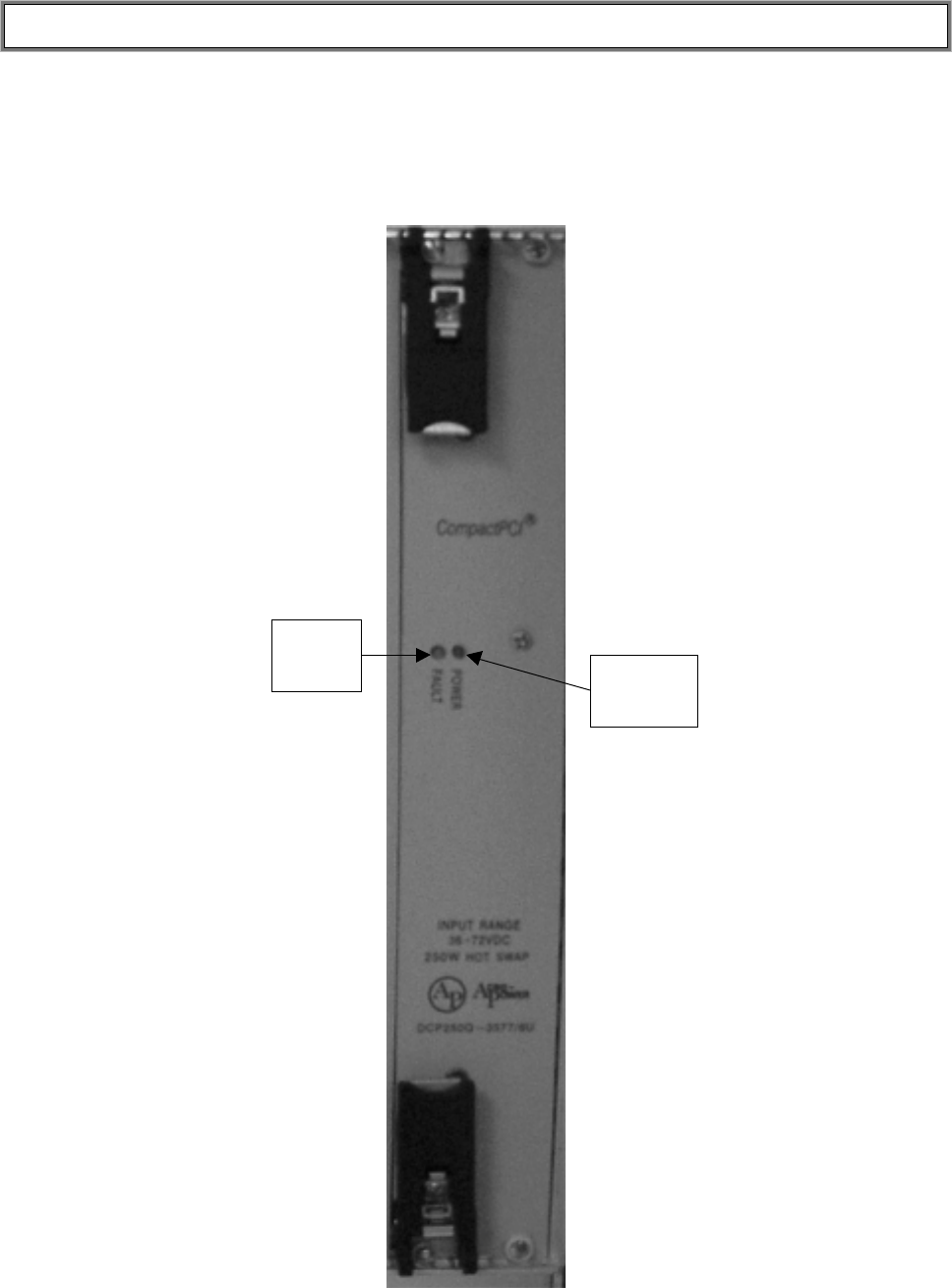
OpenCell Operations and Maintenance Manual Doc. No. XXXXXXX -
TRANSCEPT PROPRIETARY 21
3.2.6 CompactPCI Power Supply
The front panel indicators for the RAN CompactPCI power supplies are:
• Fault LED – Yellow LED lighted when module is failed
• Power Good LED – Green LED lighted when module has power
Figure 12. CompactPCI Power Supply Front Panel
Power
LED
Fault
LED
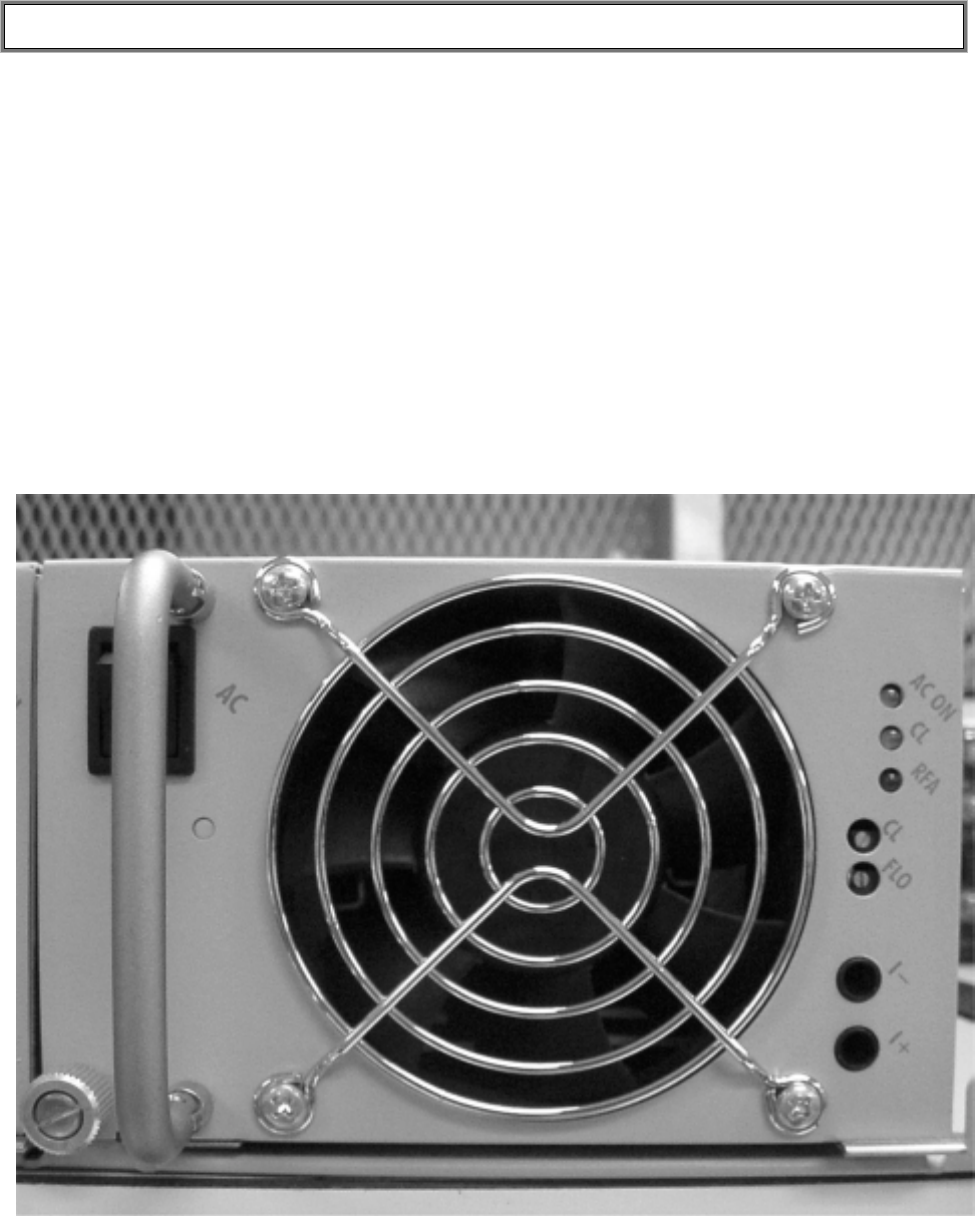
OpenCell Operations and Maintenance Manual Doc. No. XXXXXXX -
TRANSCEPT PROPRIETARY 22
3.2.7 Rectifier Front Panel
The front panel indicators for the RAN rectifier are:
• AC ON (Green) - Lighted when AC is present
• CL (Yellow) – Lighted when unit is current limiting
• RFA (Red) – Lighted when rectifier has failed
The front panel controls are:
• AC on/off toggle switch
• CL adjustment screw - Current limit adjustment. Factory set.
• FLO adjustment screw – Float voltage adjustment. Factory set.
The front panel test points are:
• I-/I+ - Current draw adjustment. Factory set.
Figure 13. RAN Rectifier Front Panel
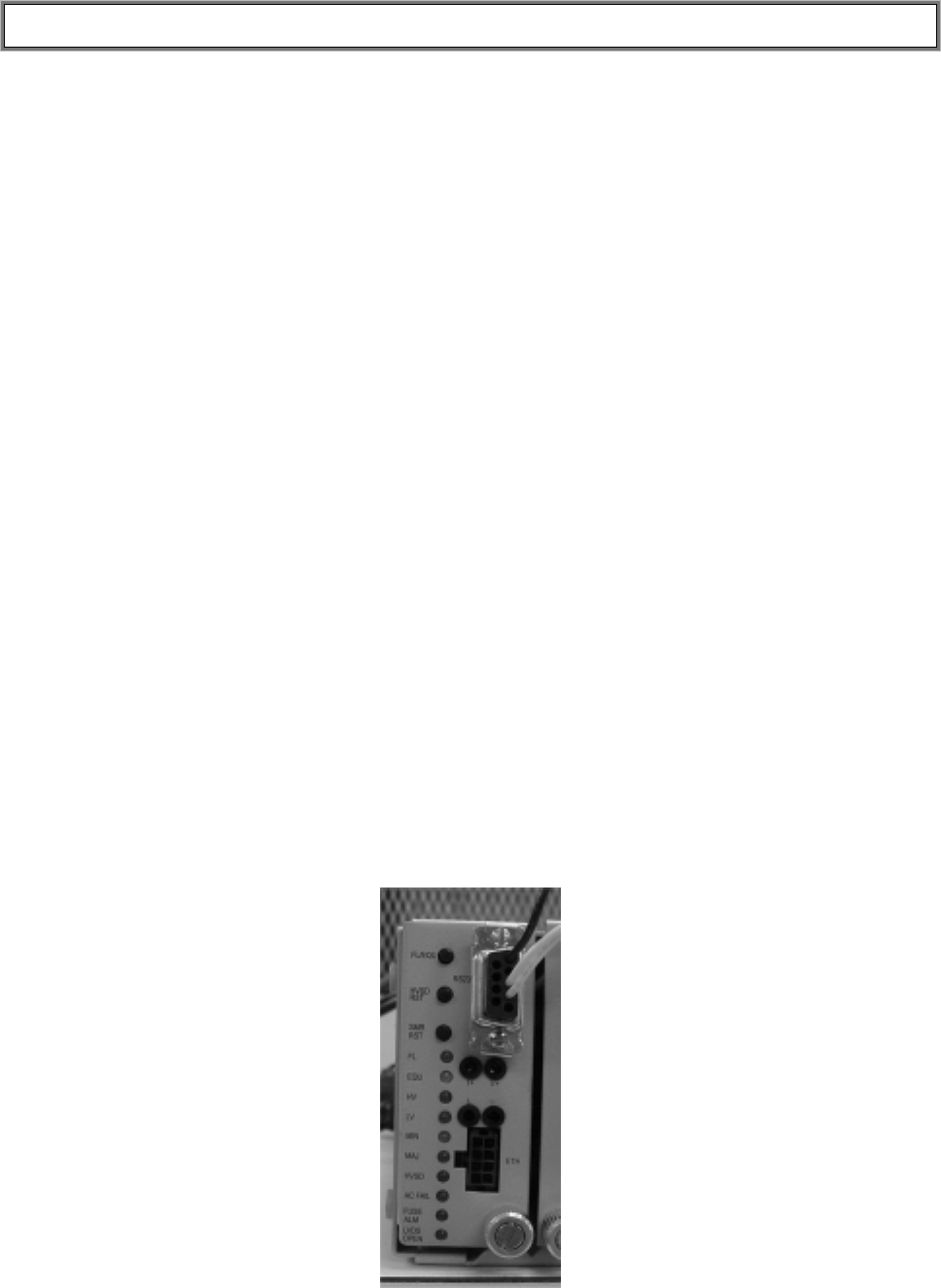
OpenCell Operations and Maintenance Manual Doc. No. XXXXXXX -
TRANSCEPT PROPRIETARY 23
3.2.8 RAN Rectifier Chassis Front Panel Controls and Indicators
The front panel indicators for the RAN rectifier chassis are:
• FL (Green) – Float voltage indicator
• EQU (Yellow) – Equalizer charge voltage
• HV (Red) – High Voltage Condition
• LV (Red) – Low Voltage Condition
• MN (Org) – Minor Alarm
• MJ (Red) – Major Alarm
• HVSD (Red) – High Voltage Shutdown
• AC Fail (Red) – AC Missing
• Fuse Alm – Not Used
• LVDS Open – LVDS in open state
The front panel controls are:
• FL/EQU – Float voltage equalizer alarm reset button
• HVSD RST – High Voltage Disconnect alarm reset button
• SMR RST – SMR Reset Button
The front panel connectors are:
• 9-pin RS-232 connector – Interface to STF module
• ETH – Ethernet connection, Not Used
The front panel test points are:
• I-/I+ - Current draw adjustment. Factory set.
• V-/V+ - Current draw adjustment. Factory set.
Figure 14. RAN Rectifier Controller Front Panel
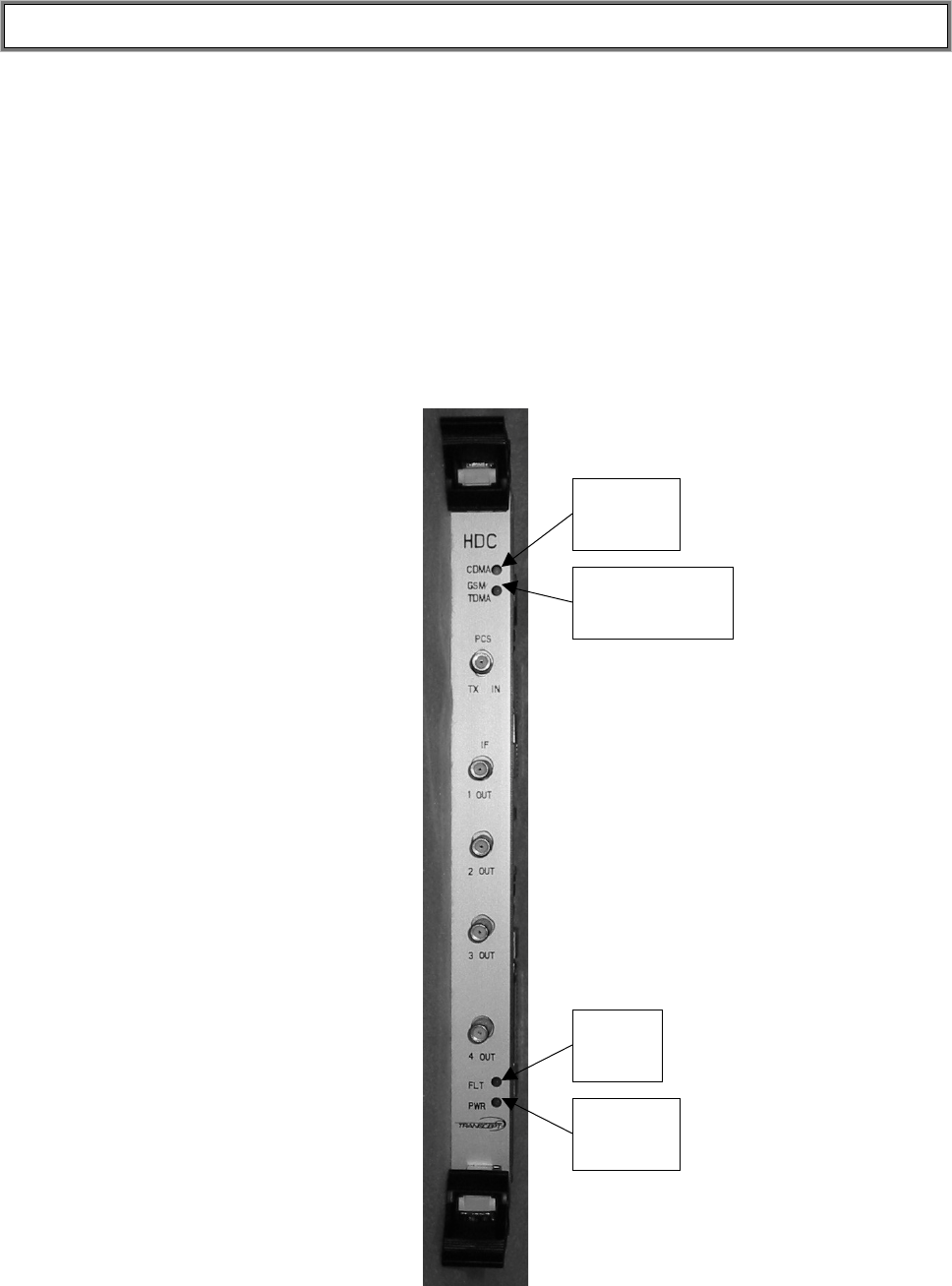
OpenCell Operations and Maintenance Manual Doc. No. XXXXXXX -
TRANSCEPT PROPRIETARY 24
3.3 HUB
This section describes the various controls and indicators for RAN specific modules.
3.3.1 HDC
The front panel indicators for the Cellular Multicoupler are:
• FLT LED – Red LED lighted when module is failed
• PWR LED – Green LED lighted when module has power
• CDMA LED – Yellow LED indicating Wideband HDC
• GSM/TDMA LED – Yellow LED indicating Narrowband HDC
Figure 15. Hub Down Converter Front Panel
GSM/TDMA
LED
CDMA
LED
Fault
LED
Power
LED
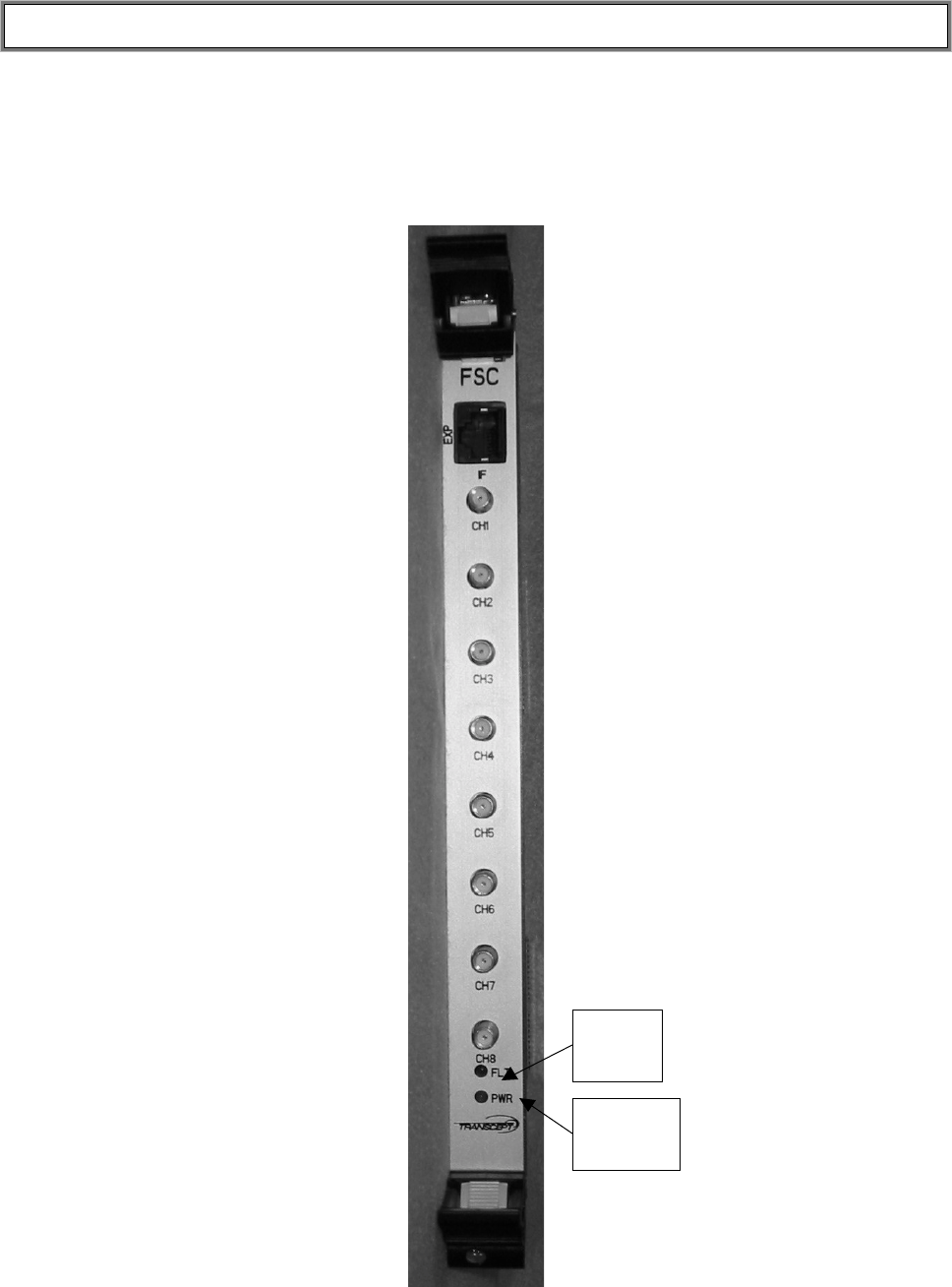
OpenCell Operations and Maintenance Manual Doc. No. XXXXXXX -
TRANSCEPT PROPRIETARY 25
3.3.2 FSC
The front panel indicators for the Forward Simulcast Card are:
• FLT LED – Red LED lighted when module is failed
• PWR LED – Green LED lighted when module has power
Figure 16. Forward Simulcast Card Front Panel
Power
LED
Fault
LED
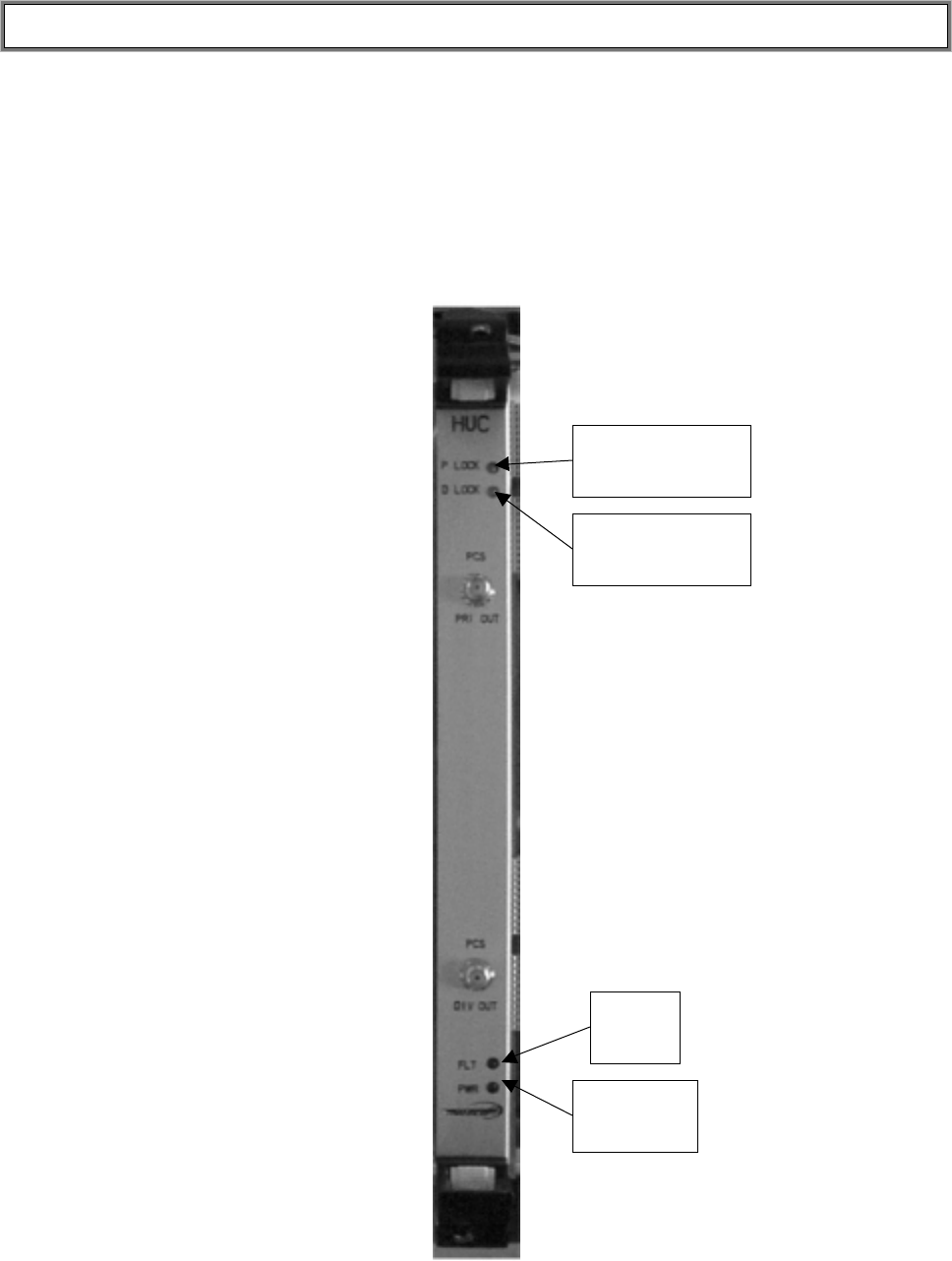
OpenCell Operations and Maintenance Manual Doc. No. XXXXXXX -
TRANSCEPT PROPRIETARY 26
3.3.3 HUC
The front panel indicators for the Forward Simulcast Card are:
• FLT LED – Red LED lighted when module is failed
• PWR LED – Green LED lighted when module has power
• P/Lock LED – Yellow LED lighted when Primary path is locked
• D/Lock LED – Yellow LED lighted when Diversity path is locked
Figure 17. Hub Down Converter Front Panel
Diversity Path
Locked LED
Primary Path
Locked LED
Fault
LED
Power
LED

OpenCell Operations and Maintenance Manual Doc. No. XXXXXXX -
TRANSCEPT PROPRIETARY 27
3.3.4 RSC
The front panel indicators for the Cellular Multicoupler are:
• IN 1-4 LEDs – DIF Input Tri-color LEDs
o Off = No input signal
o Green = Good
o Yellow or Red = Bad
• OUT 1-4 LEDs – DIF Output Tri-color LEDs
o Off = No input signal
o Green = Good
o Yellow or Red = Bad
• FLT LED – Red LED lighted when module is failed
• PWR LED – Green LED lighted when module has power
• HS LED – Hot Swap Blue LED, turns blue when board can be hot swap extracted
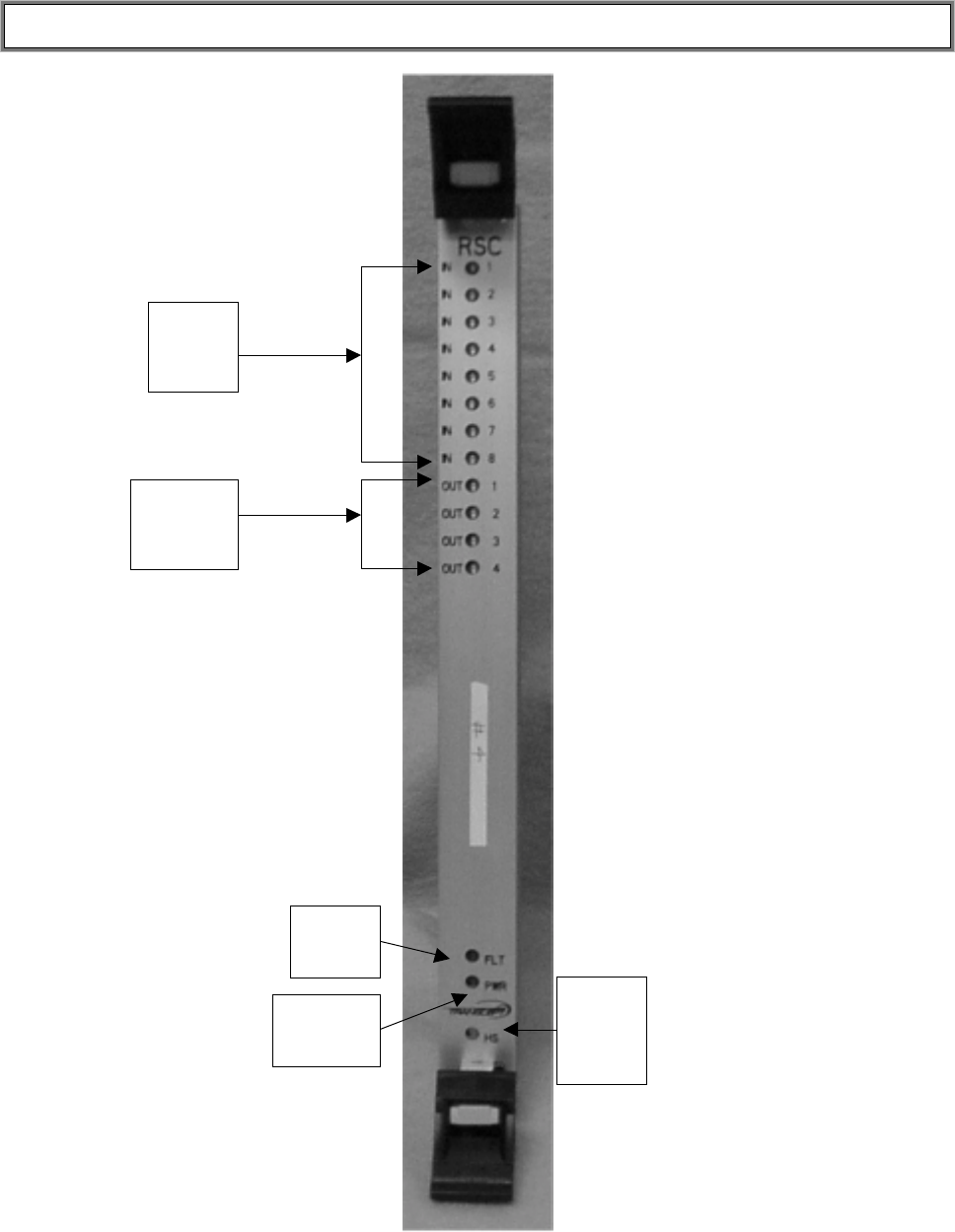
OpenCell Operations and Maintenance Manual Doc. No. XXXXXXX -
TRANSCEPT PROPRIETARY 28
Figure 18. Reverse Simulcast Card Front Panel
DIF
Output
LEDs
DIF
Input
LEDs
Hot
Swap
LED
Power
LED
Fault
LED
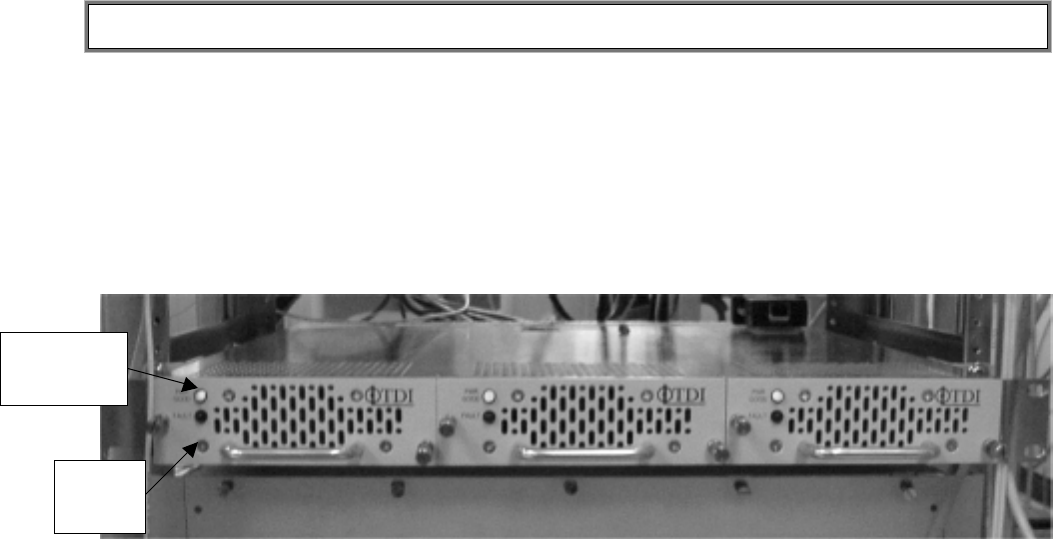
OpenCell Operations and Maintenance Manual Doc. No. XXXXXXX -
TRANSCEPT PROPRIETARY 29
3.3.5 COMPACTPCI PS
The front panel indicators for the Hub CompactPCI Power Supply are:
• Fail Good LED – Green Power LED, lighted when good
• Fault LED – Yellow LED, lighted when module has failed
Each module has its own set of LEDs. There are up to three modules per CompactPCI
power supply.
Figure 19. Hub CompactPCI Power Supply Front Panel
Fail Good
LED
Fault
LED
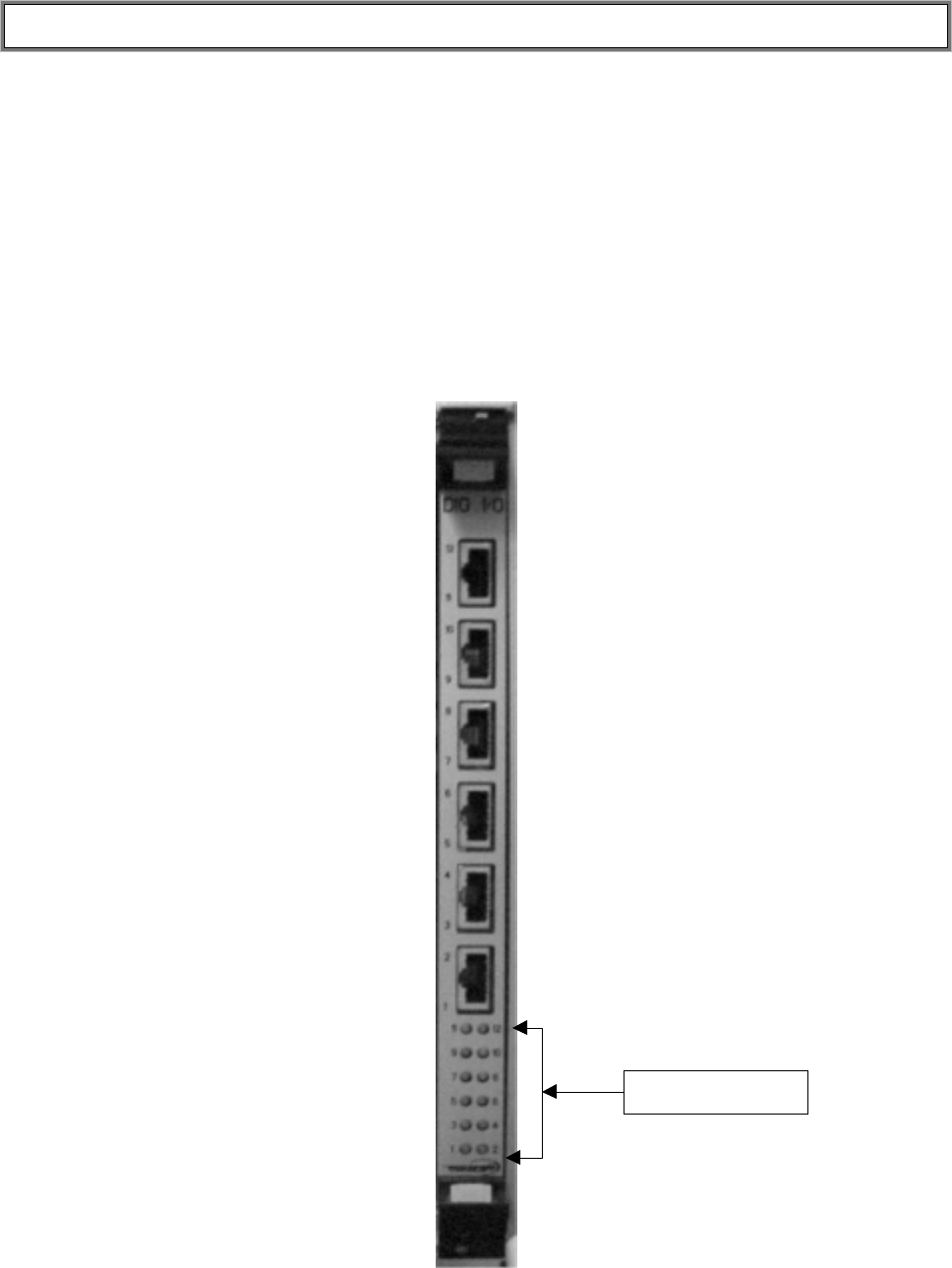
OpenCell Operations and Maintenance Manual Doc. No. XXXXXXX -
TRANSCEPT PROPRIETARY 30
3.3.6 DIO
The front panel indicators for the Forward Simulcast Card are:
• REF LED – Green LED lighted when 9.6 MHz reference is present
• CLK LED – Green LED lighted when 42.912 MHz clock is present
• DIF LED 1-12 – Tri-color LEDs. Operational when used behind SIF (1-8) or
RSC(1-12). Not used when behind HUC or FSC.
o Off = No input signal
o Green = Good
o Yellow or Red = Bad
Figure 20. Digital I/O Front Panel
DIF LEDs 1-12
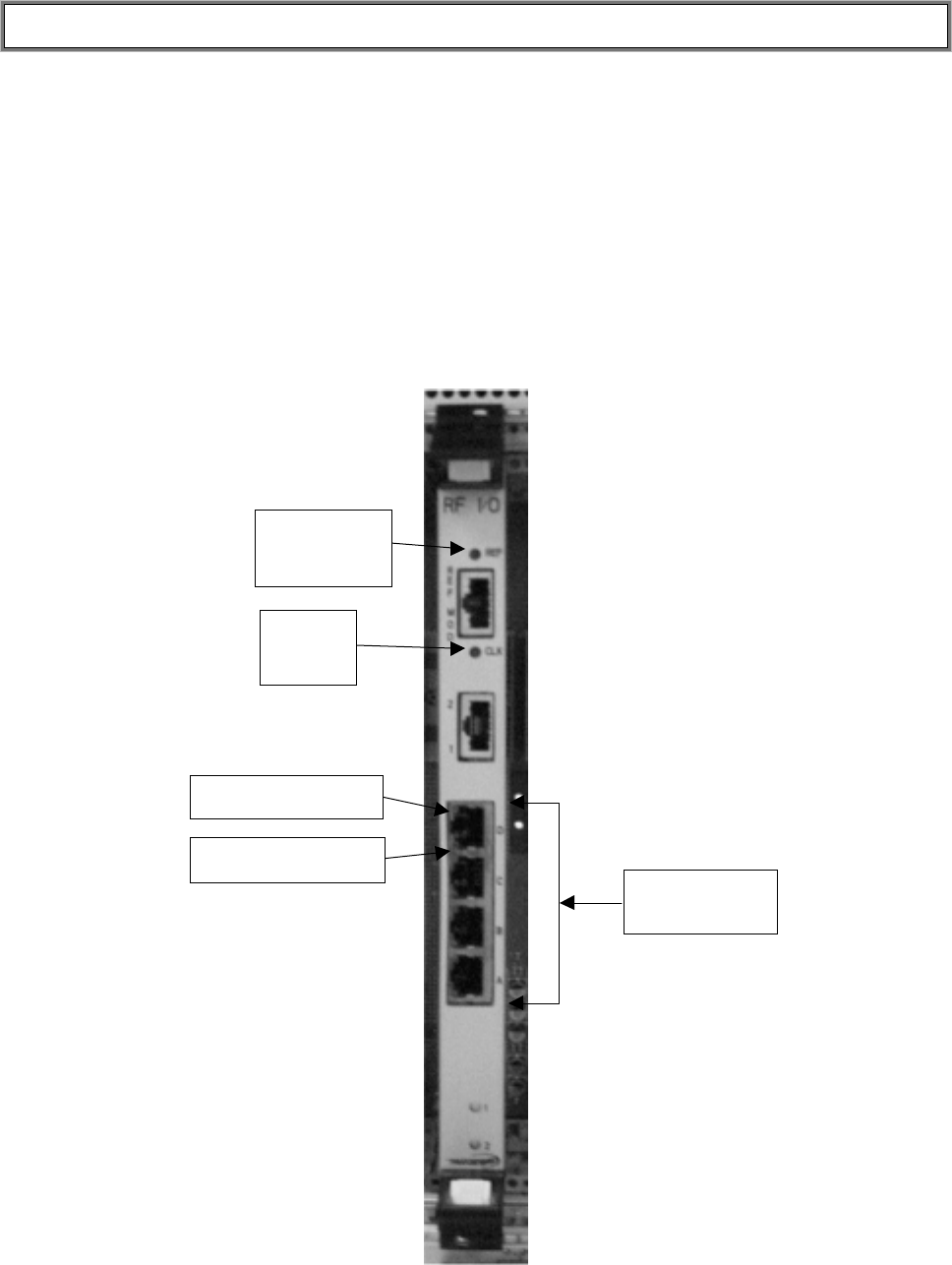
OpenCell Operations and Maintenance Manual Doc. No. XXXXXXX -
TRANSCEPT PROPRIETARY 31
3.3.7 RFIO
The front panel indicators for the Forward Simulcast Card are:
• REF LED – Green LED lighted when 9.6 MHz reference is present
• CLK LED – Green LED lighted when 42.912 MHz clock is present
• I2C Comm LED – On each I2C RJ-45 connector. Green LED lighted when I2C
message sent
• I2C Error LED – On each I2C RJ-45 connector. Red LED when no response on
interface
• LED 1 & 2 – Tri-color LEDs. Reserved for future use.
Figure 21. RF I/O Module Front Panel
I2C
Connectors
I2C Status LED
I2C Comm LED
Clock
LED
Reference
LED
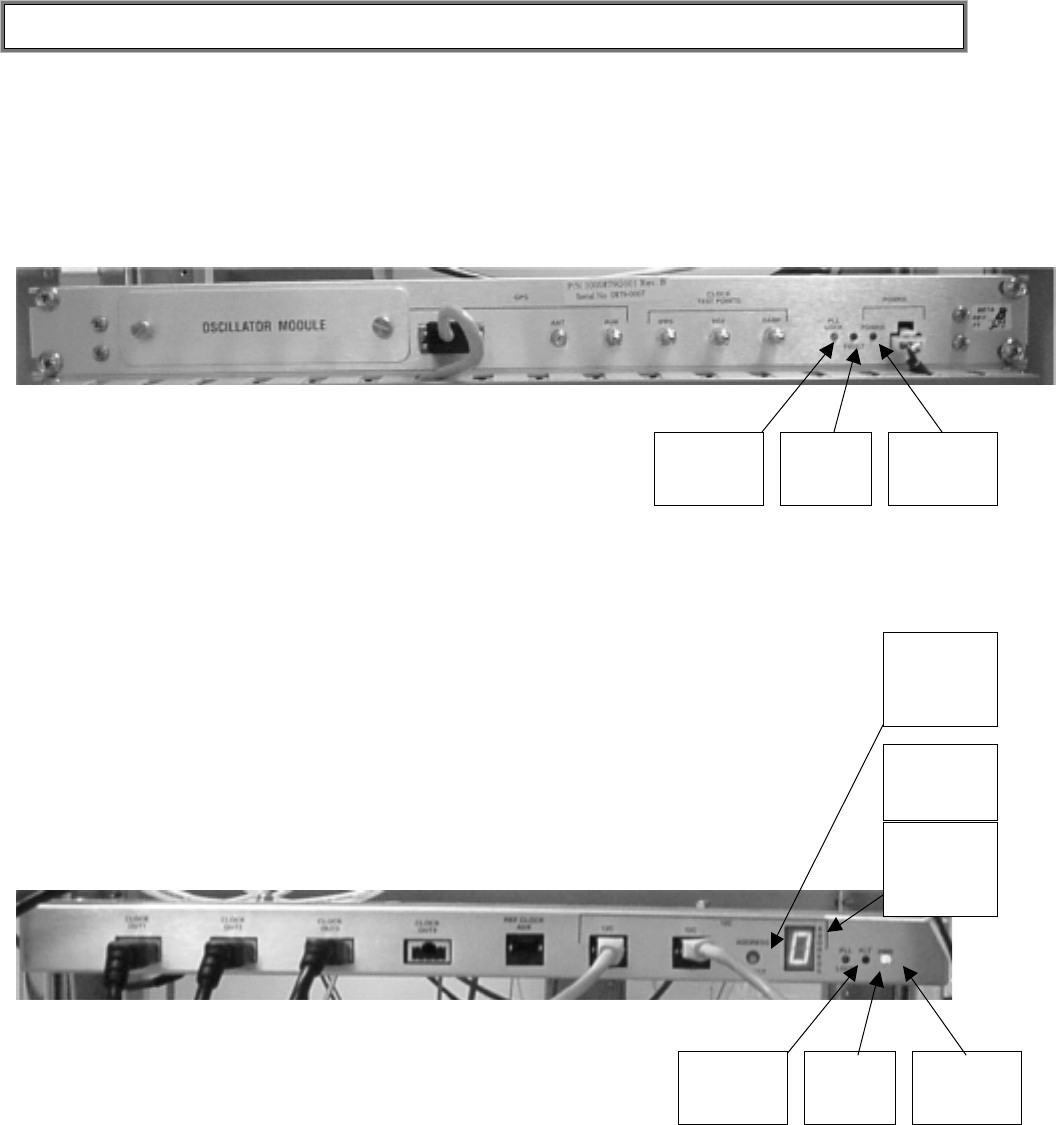
OpenCell Operations and Maintenance Manual Doc. No. XXXXXXX -
TRANSCEPT PROPRIETARY 32
3.3.8 HRM
The front panel indicators for the Hub Reference Module are:
• FLT LED – Red LED lighted when module is failed
• PWR LED – Green LED lighted when module has power
• PLL Lock LED – Yellow LED lighted when Phase Locked Loop is locked
Figure 22. Hub Reference Module Front Panel
The rear panel indicators for the Hub Reference Module are:
• FLT LED – Red LED lighted when module is failed
• PWR LED – Green LED lighted when module has power
• PLL Lock LED – Yellow LED lighted when Phase Locked Loop is locked
• I2C Address Display – 7 segment display showing I2C Address(0-7)
The rear panel controls for the Hub Reference Module are:
• I2C Address Selector – Rotary switch selecting I2C address 0-7
Figure 23. Hub Reference Module Front Panel
Power
LED
Fault
LED
PLL
Locked
I2C
Address
selector
I2C
Address
I2C
Address
selector
Power
LED
Fault
LED
PLL
Locked
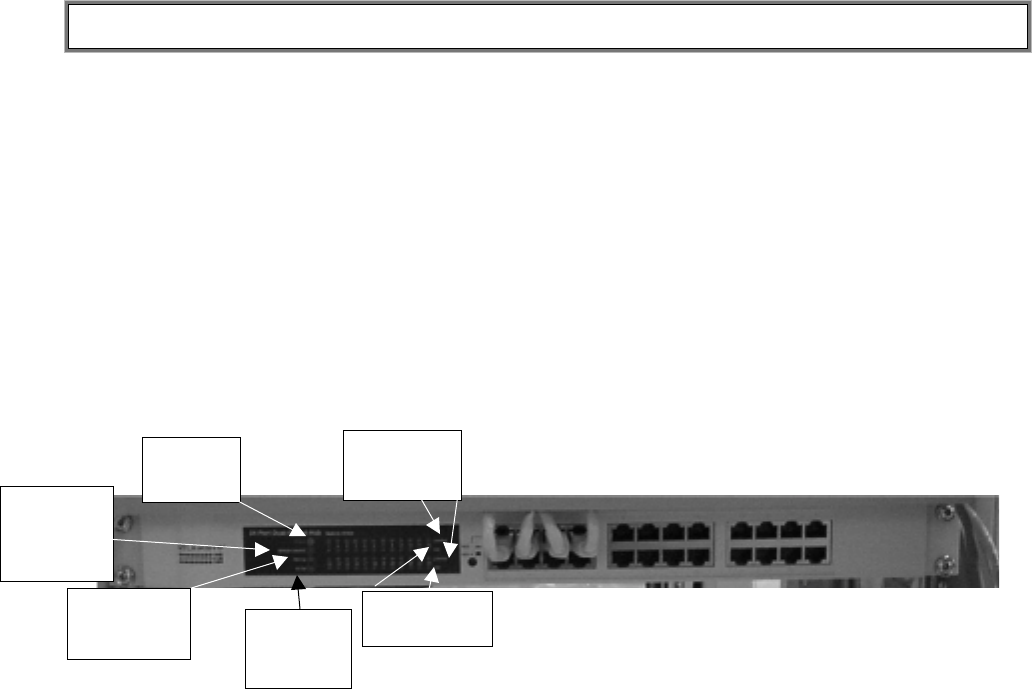
OpenCell Operations and Maintenance Manual Doc. No. XXXXXXX -
TRANSCEPT PROPRIETARY 33
3.3.9 Ethernet Hub
The front panel indicators for the hub Reference Module are:
• Power LED – Lit when unit has power
• Module Link/Act LED – Flickering when receiving or transmitting data
• 100 Col LED – Lit when 100 Mbps collisions are occurring
• 10 Col LED –Lit when 10 Mbps collisions are occurring
• Link/Act LEDs –Lit when port is transmitting or receiving data
• 100 LEDs – Lit when operating at 100 Mbps
Figure 24. Ethernet Hub Converter Front Panel
Link/Act
LEDs
Power
LED
Module
Link/Act
LED
100
LEDs
10 Col
LED
100 Col
LED
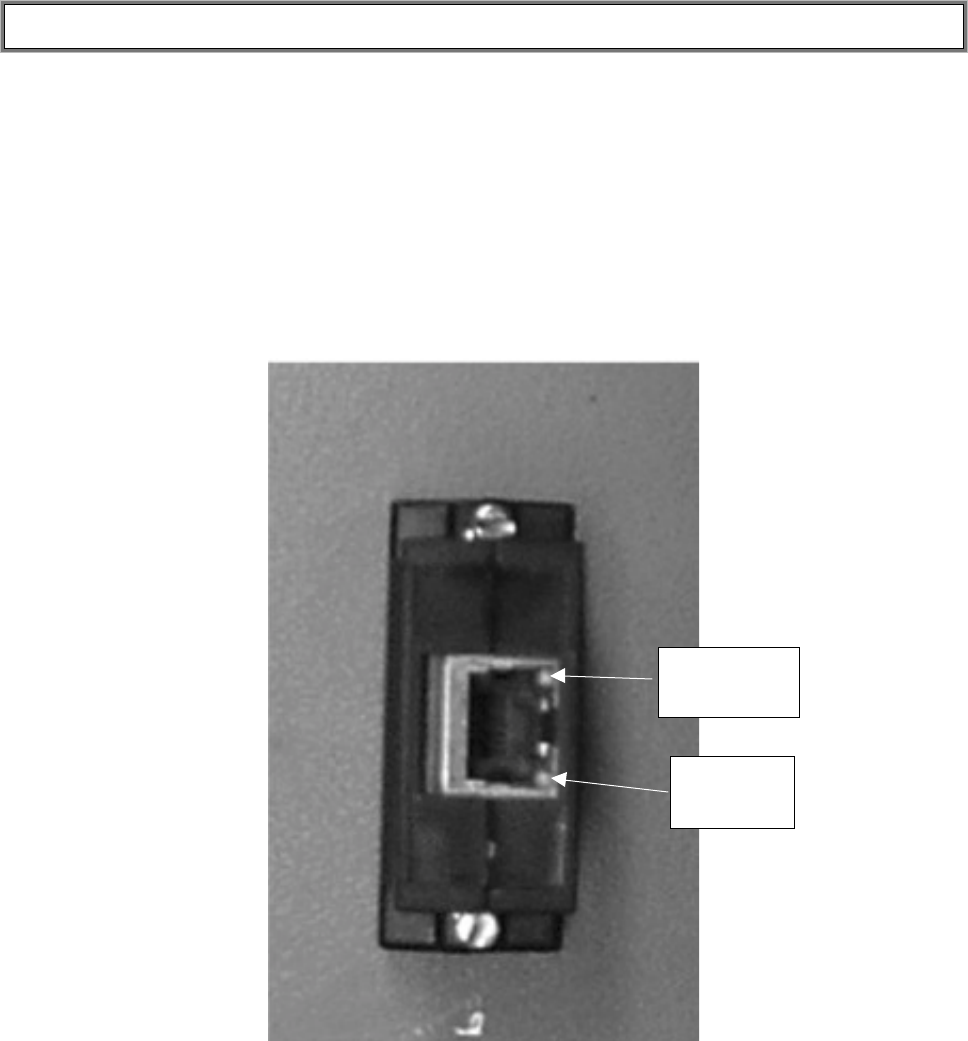
OpenCell Operations and Maintenance Manual Doc. No. XXXXXXX -
TRANSCEPT PROPRIETARY 34
3.3.10 PSI
The front panel controls for the Power Supply Interface are:
• Internal I2C address select. The default can be set to the following addresses.
The front panel indicators for the Power Supply Interface are:
• I2C Comm LED – On each I2C RJ-45 connector. Green LED lighted when I2C
message sent, red LED when no response on interface
• I2C Error LED – On each I2C RJ-45 connector. Red LED when no response on
interface
Figure 25. Power Supply Interface Front Panel
I2C Error
LED
I2C Comm
LED
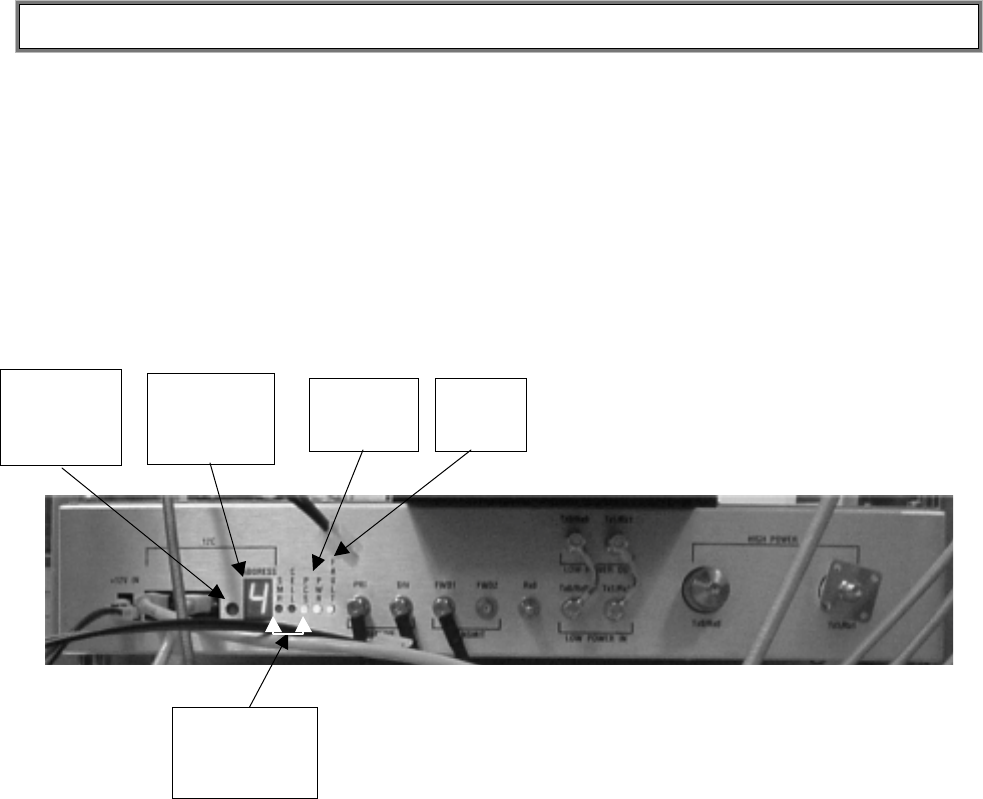
OpenCell Operations and Maintenance Manual Doc. No. XXXXXXX -
TRANSCEPT PROPRIETARY 35
3.3.11 BIM
The front panel controls for the BTS Interface Module are:
• I2C Address selector – Turn dial to select I2C address (0-7)
The front panel indicators for the hub Reference Module are:
• FLT LED – Red LED lighted when module is failed
• PWR LED – Green LED lighted when module has power
• SMR/CELL/PCS LED – Yellow LED lighted indicating BIM band configuration
• Address display – Displays I2C address, 0-7
Figure 26. BTS Interface Module Front Panel
I2C
Address
Selector
I2C
Address
Dis
p
la
y
Power
LED Fault
LED
SMR/CELL
/PCS Band
LED
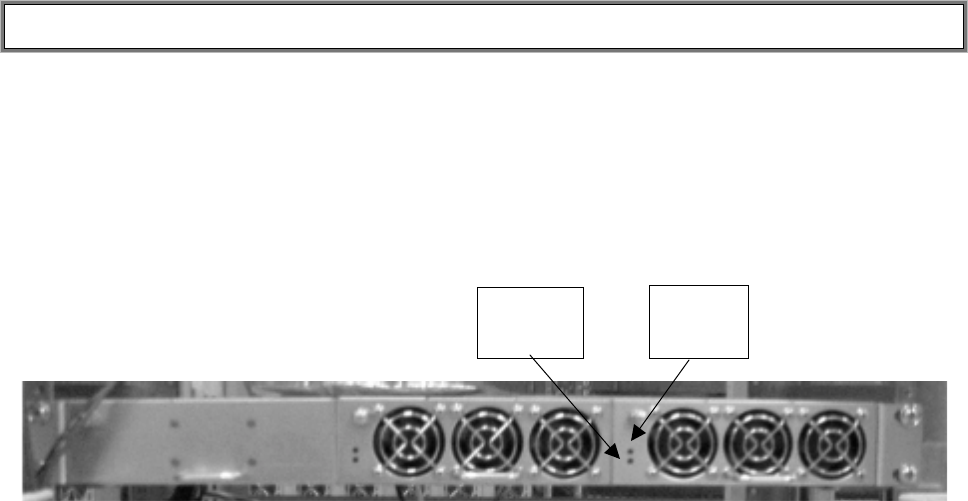
OpenCell Operations and Maintenance Manual Doc. No. XXXXXXX -
TRANSCEPT PROPRIETARY 36
3.3.12 BIR PS
The front panel indicators for the BIR Power Supply are:
• INPUT LED – Green LED lighted when module has –48VDC input
• OUTPUT LED – Green LED lighted when module has 12VDC output
Each module (up to 3) has its own set of LEDs
Figure 27. BTS Interface Rack Power Supply Front Panel
Input
LED
Output
LED
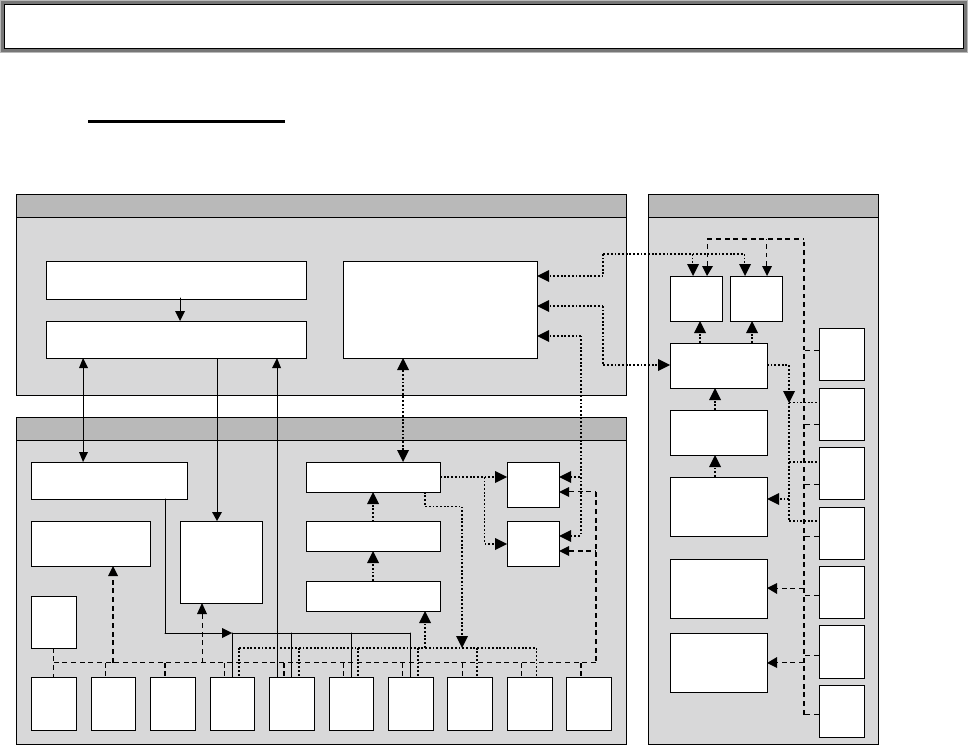
OpenCell Operations and Maintenance Manual Doc. No. XXXXXXX -
TRANSCEPT PROPRIETARY 37
4.0 MIB STRUCTURE
The following shows the MIBs in the OpenCell System. These MIBs contain the
interface for Monitoring and control of the OpenCell System.
Figure 28. MIB Relationships
There are three relationship types above, represented by three line types:
• Solid lines represent the Hub Connection relationship
• Dashed lines represent the node-level hardware relationship
• Dotted lines represent the Tenant relationship
Hardware Relationships:
• The Bus Scanner MIB contains the hardware discovered at that node by the bus
scanner software.
• The Network Node MIB contains status information retrieved from one or more of the
HCP MIBs.
• The Network Node MIB indicates what type of node this is (Hub, RAN, or Hub
Master).
• There is nothing preventing a single node (CPU) from being both a Hub Master and
a “regular” Hub Node.
Hub Connection Relationships:
• The rack and chassis from the Hub Node MIB is pulled into the BTS Connection MIB
by the Hub Config process.
HUB MASTER
HUB NODE
RAN NODE
RDC
MIB
RUC
MIB
MUC
MIB
SIF
MIB
SIF
MIB
RSC
MIB
FSC
MIB
HUC
MIB
BIM
MIB
HDC
MIB
PSI
MIB
STF
MIB
STF
MIB
BUS SCANNER
MIB
PATHTRACE MIB
EQUIPMENT MIB
HUB RF CONN MIB
NODE PATH MIB
BUS
SCANNER
MIB
PATHTRACE
MIB
NODE PATH
MIB
EQUIPMENT
MIB
NETWORK
NODE
MIB NETWORK
NODE
MIB
BTS CONNECTION MIB
TENANT
OAM
MIB WD
MIB
WD
MIB
HUB NODE MIB
GPS
MIB
GPS
MIB
HRM
MIB
FGC
MIB
RGC
MIB
FGC
MIB RGC
MIB

OpenCell Operations and Maintenance Manual Doc. No. XXXXXXX -
TRANSCEPT PROPRIETARY 38
• The Hub Config process pushes the rack and chassis information the Hub node’s
Network Node MIB.
• The BIM I2C Address is pulled by the Hub Config process from the BIM MIB at each
Hub node into the BTS Connection MIB.
• After manual configuration in the BTS Connection MIB, the Hub Config process
pushes the connection information to the Hub node’s Hub RF Connection MIB.
Tenant Relationships:
• The Pathtrace process on each node pulls the pathtrace information from the
relevant HCP MIBs and puts it into the Pathtrace MIB.
• Node-level Tenant processing cleans up the Pathtrace MIB information and puts it
into the Node Path MIB to simplify tenant processing.
• Tenant processing in the Hub Master polls the Node Path MIB on nodes in the
network for newly discovered tenants, based on new pathtrace discovery.
• Node-level tenant processing fills in the Equipment MIB based on all locally
discovered hardware belonging to known tenants.
• Tenant processing in the Hub Master pushes down Tenant OAM MIB information to
the Equipment MIBs on each node. The node-level Tenant processing determines if this
information affects any of its hardware and makes the appropriate changes.
• Tenant processing in the Hub Master pushes down gain control information from the
Tenant OAM MIB to the Forward/Reverse Gain MIBs.
• Forward and Reverse Gain processing at each node pulls from the Equipment MIB
the location of its required tenant hardware modules.
• Forward and Reverse Gain processing pulls from the relevant HCP MIBs the values
needed to do gain control.
• Forward and Reverse Gain processing use their own MIB (FGC and RGC)
parameters, filled in by Tenant processing at the Hub Master, to determine how to
operate.
• Forward and Reverse Gain processing reports results into the FGC/RGC MIB for use
by Tenant processing in the Hub Master.
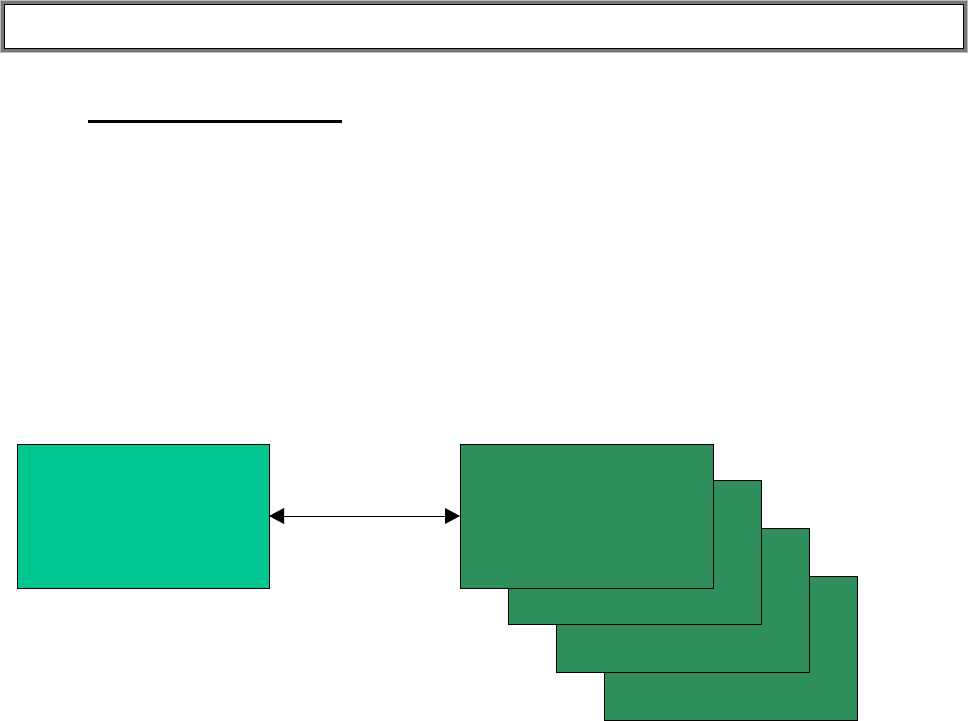
OpenCell Operations and Maintenance Manual Doc. No. XXXXXXX -
TRANSCEPT PROPRIETARY 39
5.0 SETUP PROCEDURES
This section contains the information needed for setting up the hardware once the
hardware has been installed and cabled.
5.1 NETWORKING
The Opencell system is a collection of network devices not unlike any other computer or
printer on a network.
The Hub and Ran are the two basic network devices in the system. These devices need
certain things to function in our network.
•IP address
•User Accounts
Figure 29. Hub RAN Management
IP Address:OpenCell is set up so that the Hub/Ran gets its IP through a DHCP (
Dynamic Host Configuration Protocol ) server. Whether Opencell provided or customer
provided it does not matter where the DHCP server resides.
User Accounts:User accounts will be kept to a very small number. A root level account
and a user level account. If the customer wants to create more accounts on a node for
accounting purposes that will be acceptable.One problem with not having a NIS (
Network Information Service ) is that all account passwords are stored on the local
machines. So if the customer wants to change the root password or delete a user from
the system it must be done on all machines. The benefit of this system is that the
machine does not need to have contact with the NIS master to validate, which makes
remote operation of the machines very difficult.
Hub Fiber
Ran
Ran
Ran
Ran

OpenCell Operations and Maintenance Manual Doc. No. XXXXXXX -
TRANSCEPT PROPRIETARY 40
Figure 30. Hub Master Management
The HubMaster has the ability to function as a regular Hub with a few extra abilities.
• DNS ( Domain Name System )
• DHCP ( Dynamic Host Configuration Protocol )
• Dial
• NTP ( Network Time Protocol )
On top of these the HubMaster need certain information to function
• IP Address
• User Accounts
DNS ( Domain Name System ): The DNS is a system that must be manually
configured for each Opencell system. DNS maps the node name to an IP Address. Most
importantly the HubMaster name to its IP. In order for the nodes on the system to
contact and connect to the HubMaster this must be done.
DHCP ( Dynamic Host Configuration Protocol ): Because every node on the system
needs to get an IP we have provided a DHCP server on the HubMaster. If the customer
has a DHCP server already in use they can use that one and disable the one that
resides on the HubMaster. Two DHCP servers can not reside on the same network
without being routed appropriately. If the customers DHCP is used it must be
configured to broadcast the HubMaster DNS to all nodes on that Opencell system. This
allows the nodes to have access to the HubMaster.
DIAL: The Dial Utility, created at Transcept, allows the nodes to contact the HubMaster
and report all vital information, namely the IP Address and Hostname of the node. Post
beta Dial will dynamically update the DNS database with this information. Right now the
DNS node information must be manually configured.
NTP (Network Time Protocol ):
The NTP server will sync all of the nodes in its Opencell system to the
HubMaster current time.
HubMaster Hub Fiber
Ran
Ran
Ran
Ran
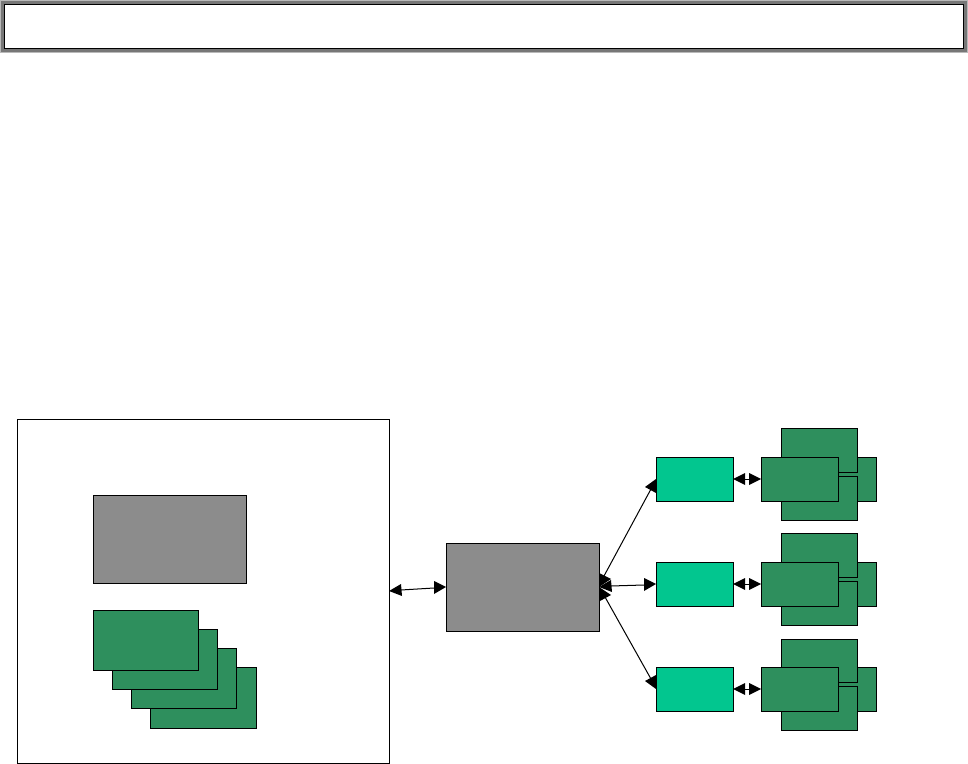
OpenCell Operations and Maintenance Manual Doc. No. XXXXXXX -
TRANSCEPT PROPRIETARY 41
IP Address: For the HubMaster the IP Address must be statically allocated. This IP
must be static because of the services it provides. It also allows us to be certain that the
DNS information will always be accurate with regards to the HubMaster.
User Accounts: User accounts will be kept to a very small number. A root level
account and a user level account. If the customer wants to create more accounts on a
node for accounting purposes that will be acceptable. One problem with not having
a NIS ( Network Information Service ) is that all account passwords are stored on the
local machines. So if the customer wants to change the root password or delete a user
from the system it must be done on all machines. The benefit of this system is that the
machine does not need to have contact with the NIS master to validate, which makes
remote operation of the machines very difficult.
Figure 31. System Management – Single System
In the simple case of the single Opencell system the customer has several options on
how to set up the system.
• If the customer has a DHCP server and wishes to not use the one provided then the
DHCP on the HubMaster just needs to be disabled.
• If the customer does not have a DHCP server then the one provided will be
necessary, all the customer has to do is provide a static IP for the HubMaster and a
range of IP addresses for the DHCP to serve.
These are the simple cases but in each one the DHCP server must be configured to
broadcast the DNS that is on the HubMaster.
• If the customer has a DHCP server already but wants to use the one that is provided
by the HubMaster than a router must be brought in to separate the two DHCP servers.
Hub Ran
Ran
Ran
Ran
Hub Ran
Ran
Ran
Ran
Hub Ran
Ran
Ran
Ran
HubMaster
NOC
Comp
Comp
Comp
Comp
Customer Network
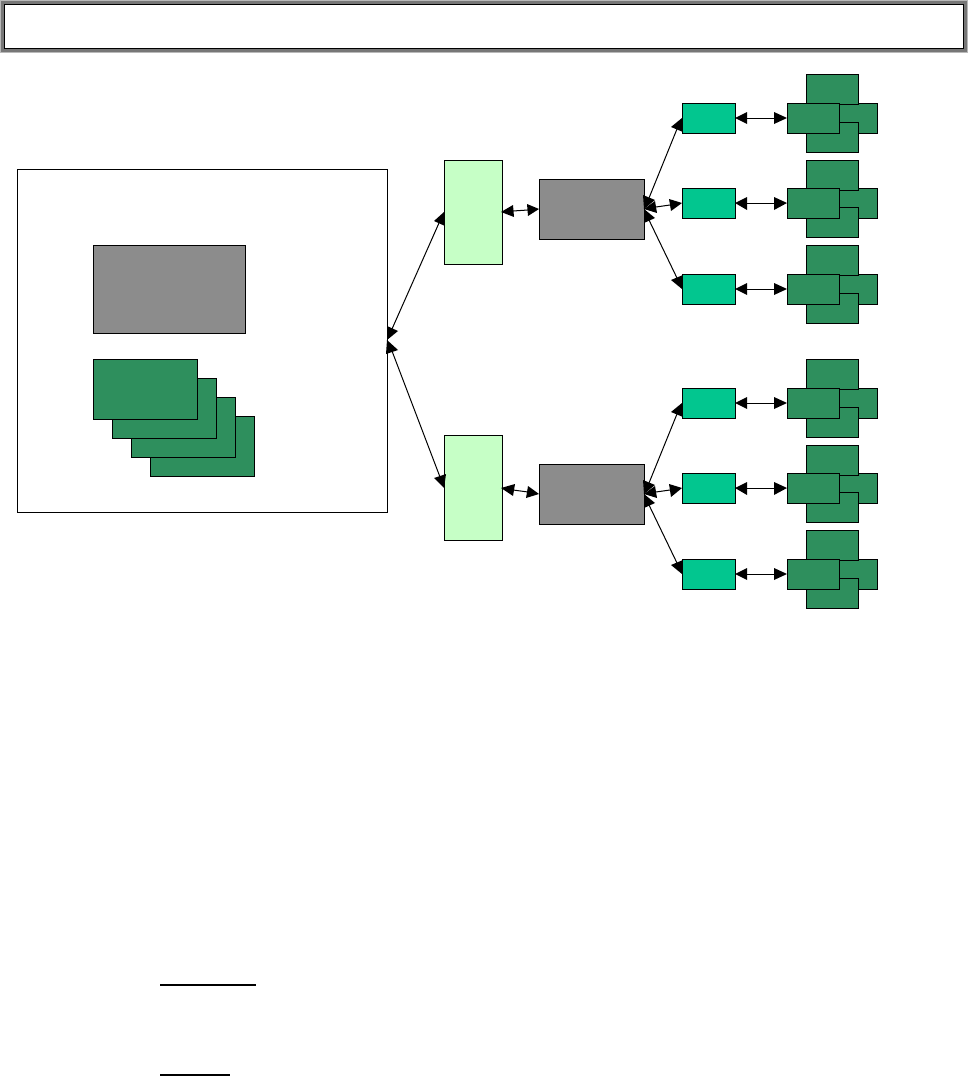
OpenCell Operations and Maintenance Manual Doc. No. XXXXXXX -
TRANSCEPT PROPRIETARY 42
Figure 32. System Management – Multiple Systems
There can be only one HubMaster in a Opencell system. If there were two then the
nodes on the system would be confused as to whom to report to. For this reason we
must break the network apart into zones using routers. Configured properly the routers
can be told to pass DHCP offers through which would allow the customer to use their
DHCP although it would be much easier, wiser, to use the one on the HubMaster.
5.2 RAN NETWORK CONFIGURE
Identification
There are two alternatives that can be used to identify a RAN in the OpenCell network:
• Automatic: When a RAN is installed, it can be identified by its GPS coordinates.
The NMS would have the responsibility of detecting the new node and naming it
based on GPS coordinates.
• Manual: The installer can manually correlate the RAN MAC address with its
physical pole ID. This would be done by manually updating the DNS lookup table
and having the NMS correlate the pole ID with a given RAN.
The two approaches for identifying a RAN have pros and cons. Obviously, not requiring
any manual configuration is attractive. However, an installer (who still needs to configure
some other information) may not know the GPS coordinates of the RAN. In addition, if
GPS is not available, then the lat/long coordinates would need to be manually entered.
• Each pole can support two 4-tenant RAN boxes, which need to be distinguished
from one another. A convention needs to be adopted to automatically identify
them. Suggestion:
Hub Ran
Ran
Ran
Ran
Hub Ran
Ran
Ran
Ran
Hub Ran
Ran
Ran
Ran
HubMaster
NOC
Comp
Comp
Comp
Comp
Customer Network
Hub Ran
Ran
Ran
Ran
Hub Ran
Ran
Ran
Ran
Hub Ran
Ran
Ran
Ran
HubMaster
Router Router

OpenCell Operations and Maintenance Manual Doc. No. XXXXXXX -
TRANSCEPT PROPRIETARY 43
• The first installed RAN box will be designated RAN Box A.
• The second installed RAN box will be designated RAN Box B.
When a box is installed on the pole, it must be tagged/labeled with its appropriate Box ID
or installed in such a way that it can be identified without a label (using a known
convention like top = A, bottom = B or similar).
As each RAN comes online and is detected by the NMS (by recognition of the new
network node/IP address), it will be compared to see if another RAN has the same
Location ID. If not it will be designated RAN Box A, and if so it will be designated RAN
Box B.
If the NMS identifies a new RAN IP address at a location where in the past two RANs
have already been identified, the NMS must determine which of RANs is no longer
present and then assign the new RAN node the RAN Box ID of the removed RAN. This
will cover the case of RAN CPUs being swapped.
The NMS will have the responsibility of creating new network node icons that correspond
to each RAN CPU. The DNS name (based on location information) can be used to name
these icons.
The NMS will have the addition responsibility of setting the Hub/RAN state in the
Network Node MIB of the CPU to be a "RAN".
In addition, the NMS has the option of updating a RAN identification text field with some
alternative location information such as street address or other customizable description.
Number of Tenants in a RAN
The RAN needs to be configured with the number of tenants to be supported. This is
done by updating the appropriate parameter in the Network Node MIB of that CPU. This
is required to allow certain RAN hardware to operate in the proper manner.
Please re-write or elaborate on this. Confusing as to why there is a question here.
Will an installer know this information after that RAN is installed? If not, then this
information will need to be configured ahead of time using a script that can be executed
via a local Ethernet console session.
RF-Antenna Connections
This is really the RF PA to Multiplexer connections, more than it is the Antenna
connections. Please re-write to be clearer.
The RFAntenna connections in a given RAN box need to be configured so that validation
checks can be performed to be sure that signals are being properly routed. Ideally this
will be configured at the customer test site or in the factory, though it could be configured
after the fact by the installer via the NMS. If a pre-install method is to be supported, then
the CPU will need to be locally accessed via an Ethernet console session and a script
will need to be executed that will prompt the user for the connection information.

OpenCell Operations and Maintenance Manual Doc. No. XXXXXXX -
TRANSCEPT PROPRIETARY 44
5.3 NETWORK CONFIGURE
Hub Master
• One CPU in the Hub will be designated as the Hub Master. It will run special
software that does not run on all other CPUs in the OpenCell network.
• The Hub Master will be designated as such by doing a special installation of Hub
Master software. The installation of this software will take care of all configuration
necessary to let the CPU in question be used as a Hub Master. This includes setting
a read-only state flag in the Network Node MIB of that CPU to let the NMS recognize
it as a Hub Master.
• It is
absolutely critical that only one CPU in the network be configured as a Hub
Master. If the installation of Hub Master software detects that there is already a Hub
Master CPU in the network, the installation will exit and indicate that the other Hub
Master CPU has to have its Hub Master software uninstalled firstThe Hub Master
CPU will request its IP address from the DHCP server at startup.
• The NMS will display the Hub Master network node in an easily identifiable manner
(icon in the network map) so that installers can access it to aid in the configuration of
other network nodes.
• The Hub Master software will periodically scan the network for the presence of all
nodes (CPUs) in its own subnet (mask = 255.255.255.0) and take action as needed.
CPU Installation
• The Hub in the OpenCell network consists of several racks and chassis, which
translate to several CPUs per Hub. Since these CPUs all reside at a single
geographical location, it is necessary to establish a relationship of each CPU to its
rack and chassis location such that field service personnel can be deployed to the
correct location within the Hub when the need arises.
• There can be many CPUs at a single Hub Site within the many racks and chassis,
but there is no way to correlate an IP address to its physical rack/chassis location
automatically. Therefore, a convention for identifying racks and chassis needs to be
established.
• Hub Racks must be given unique identifiers. This can be as simple as numbering
Hub Racks from 1...N or coming up with some other naming convention. Another
alternative is to come up with some sort of discrete control mechanism to let the rack
IDs be set up. In any event, when a new rack is installed in the Hub, it must be
labeled/tagged so a field service technician can easily identify it.
• Chassis within in a rack also need to be uniquely identifiable. The convention used
should probably just be as simple as a numbering scheme where chasses are
numbered from top-bottom.
• Each CPU used in the OpenCell network can be uniquely identified by the MAC
address of its Ethernet controller. This MAC address should be clearly identified with
a permanently fixed label on the front of the CPU module.
• The MAC-Rack/Chassis relationship will need to be manually configured. This can
be done by manually editing the DNS lookup table and providing the MAC address

OpenCell Operations and Maintenance Manual Doc. No. XXXXXXX -
TRANSCEPT PROPRIETARY 45
with a symbolic name based on rack/chassis ID. A convention should be established
so that the rack/chassis can be easily parsed out by the NMS software.
• The NMS will have the responsibility of creating new network node icons that
correspond to each Hub CPU. The DNS name (based on rack/chassis) can be used
to name these icons.
• The NMS will need to set the Rack/Chassis ID fields of the Hub Network Node MIBs.
This can be accomplished by parsing out the DNS name and doing SNMP sets to
the appropriate nodes.
• The NMS will have the addition responsibility of setting the Hub/RAN state in the
Network Node MIB of the CPU to be a "Hub". This is important for hardware that
needs to operate differently (i.e. Sonet) depending on its node type. The NMS may
do this based on the GPS coordinates of the Hub itself.
BTS-BIM Connections
• When installing Hub RF hardware, connections among the BIM, HDC, FSC, and
HUC boards, as well as their association with a given tenant, need to be manually
configured because there is no way for software to automatically deduce this
information.
• The BTS will interface to the OpenCell network via racks containing only the BTS
Interface Modules (BIMs) and their power supplies. Changes to the connections
between the BTS, the BIM, and the CPU controlling the BIM will require configuration
change.
• BIM modules reside in their own racks - these racks need to have a convention
established to identify the BIMs within the racks. This may be as simple as
numbering the BIMs from 1…M inside the rack from top to bottom and referring to
the rack locations as shelves.
• When BTS-BIM-CPU connections change (because of new equipment being
installed or otherwise), these changes need to be captured in a MIB that is used in
the Hub Master. This MIB will establish the relationships between the BTS owners
(tenant), the physical BIM locations (rack/shelf), the controlling CPU location
(rack/chassis), and the BIM I2C address. The following is the proposed structure of
this BIM Configuration MIB:
Tenant
Name BTS # BTS
Sector Tenant
Band BIM
Rack
ID
BIM
Shelf
ID
BIM
CPU
Rack
ID
BIM
CPU
Chassi
s
ID
BIM
I2C
Bus
BIM
I2C
Slot
• The above MIB will be used on the Hub Master CPU. When an installer or field
service technician changes the BTS-BIM-CPU configuration, that installer will access
the Hub Master CPU via the NMS and update the above MIB table.
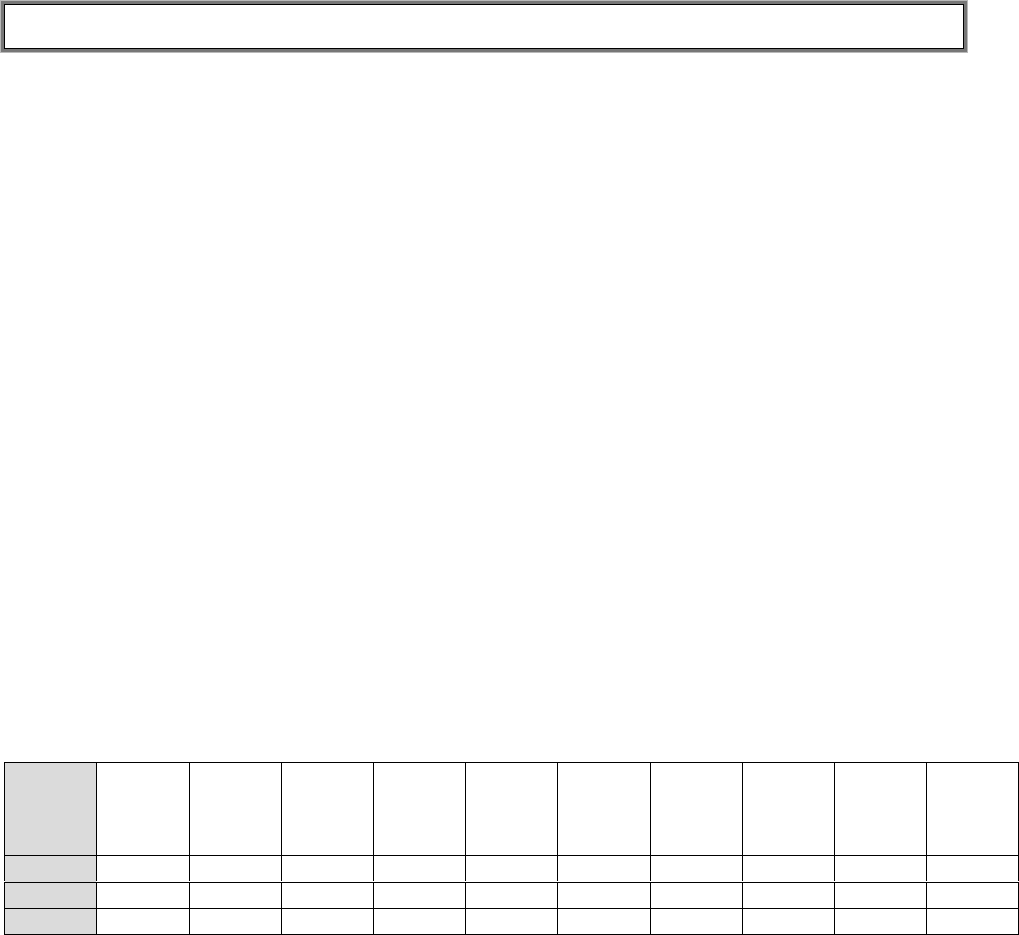
OpenCell Operations and Maintenance Manual Doc. No. XXXXXXX -
TRANSCEPT PROPRIETARY 46
• Software that resides on the Hub Master will utilize the information in the above table
to update the appropriate Network Node CPU, based on its Rack/Chassis IDs. This
implies that the Hub Master software will need to determine and track the IP
addresses of each Hub node and its Rack/Chassis ID.
• The Hub Master software will perform several operations:
o Combine the Tenant Info into a single Tenant ID String using the following
format: <Name><:><BTS#><:><Sector><:><Band>
o Pass the newly formed Tenant ID string to the Hub RF Connection MIB (see
next section) of the associated Hub CPU. The entry in the Hub RF
Connection MIB will be determined using the BIM I2C bus/slot as the table
key.
o Ensure that the Hub RF Connection MIB tenant information stays
synchronized with the above table.
Hub RF Connections
• When a new Hub RF board (BIM, HDC, FSC, HUC) is installed or the connections
among these boards are changed, the installer will make the appropriate connections
and then access the appropriate node via the NMS.
• The installer will then configure the connections among the Hub RF modules in this node
by updating the Hub RF Connection MIB, which will have the following format:
Tenant
Info BIM
I2C
Bus
BIM
I2C
Slot
HDC
#1
I2C
Bus
HDC
#1
I2C
Slot
HDC
#2
I2C
Bus
HDC
#2
I2C
Slot
FSC
I2C
Bus
FSC
I2C
Slot
HUC
I2C
Bus
HUC
I2C
Slot
• The tenant field in the above table will be automatically set by the Hub Master
software based on the BIM I2C bus/slot, which acts as the key between the two
tables.
• The table captures the connections among all of the Hub RF hardware for a given
tenant sector. A configuration limitation exists which dictates that all of the RF
hardware for a given tenant sector must be under the control of a single CPU. This
limitation allows a maximum of 5 tenant sectors worth of RF equipment on a single
CPU (a single 20 card chassis can hold 10 HDCs, 5 FSCs, and 5 HUCs in addition to
the 5 BIMs needed that reside in their own rack). Once this number of tenant sectors
is exceeded, a new chassis is required.
• If the above configuration limitation is seen as a problem, then the fallback solution
will be to maintain a single Hub RF Connection table in the Hub Master CPU that
would span all RF racks/chassis. This table would take on the same format as the
one above, but would have additional fields to identify the CPU that controls each

OpenCell Operations and Maintenance Manual Doc. No. XXXXXXX -
TRANSCEPT PROPRIETARY 47
module. This solution has pros and cons: the primary benefit would be that since all
of the connection information would be on one CPU, the field service technician
could access a single network node (Hub Master) to set up the entire Hub. However,
doing this would make the supporting software much more complex because there
would need to be many more SNMP transactions between the Hub Master software
and the software within the various Hub CPUs. I would like to avoid this approach -
everything from this point forward assumes that we will NOT use this solution.
RSC/SIF Configuration
• When an RSC/SIF card is installed in the Hub and/or when the cabling configuration
of the RSC/SIF is changed, the RSC/SIF ports need to be enabled/disabled
according to which ones have cables connected to them. The installer will access the
appropriate network node (via the NMS) corresponding to the RSC/SIF rack/chassis,
go to the appropriate HCP MIB, and set each of the 8 inputs to either “on” (cable
connected) or “off” (no cable connected).
HRM Configuration
• No special configuration is necessary when installing HRM modules. However, the NMS
may need to correlate HRM faults to the rack in which it is contained. The HRM-rack
relationship can be deduced by evaluating the Rack ID of the CPU that the HRM is
controlled by. This Rack ID will be contained in the Network Node MIB.
Software Operation
• The HCPs that manage the Hub Forward RF cards (BIM, HDC, FSC) will map to the
above MIB table and use the tenant information to form path-trace strings that will be
reported in their respective HCP MIBs. The Path Trace and Tenant HLPs will use these
path-trace strings for their own specific functionality.
• The path-trace strings will take on the following format:
<Tenant Info><,><IP Address>
where "Tenant Info" is a formatted string created in the Hub Master (see BTS-BIM
section above):
<Name><:><BTS#><:><Sector><:><Band>
• The FSC is the starting point of the transmission of the path-trace string through the
forward and reverse signal paths for the associated tenant sector. Each RF card in the
chain will receive the path-trace string, report the path-trace string in its HCP MIB, and
pass the path-trace string along to the next hardware module in the chain.
• The final board in the chain is the HUC, who has the added responsibility of verifying
that the tenant information contained in its input path-trace string matches the tenant
information in the MIB table defined above. If it does not, then the configuration is invalid
and the HUC will disable its output to the BIM.
In addition, each HCP along the path-trace chain has the responsibility of verifying that its
hardware module is configured to the tenant band that it receives in the path-trace string. If not,
that HCP will flag a configuration error that will get reported in the Network Node MIB.

OpenCell Operations and Maintenance Manual Doc. No. XXXXXXX -
TRANSCEPT PROPRIETARY 48
5.4 PATHTRACE
This chapter outlines the concept and usage of pathtrace within the OpenCell system.
This chapter breaks these topics down into three (3) areas:
• Concept;
• Description of how pathtrace information is populated in the OpenCell MIB structure;
• Detection of a configuratio n fault using pathtrace;
5.4.1 Pathtrace Concept
Pathtrace is the term used to describe the method by which configuration thread
information is stored and monitored in the OpenCell system. A properly configured
OpenCell product requires that the system be aware of the specific modules that
constitute each and every complete thread (both forward and reverse). Such an
awareness is necessary for the following two reasons:
! Forward gain management – the system makes gain adjustments. As a
consequence, the system needs to know which specific modules make up the
particular forward gain thread for that tenant;
! Forward and reverse path continuity – the system needs to detect and isolate
(where possible) faults in the system. As a consequence, the system needs to
know which specific sequence of cascaded modules make up the forward path
and the reverse path for a particular tenant;
A complete thread is composed by the serial cascaded connection of the following
modules:
HUB side: BIM, HDC, FSC, NIF, SIF (Forward path)
SIF, NIF, RSC, HUC, BIM (Reverse path)
RAN side: SIF, NIF, RUC, PA (Forward path)
MCPL, RDC, NIF, SIF (Reverse path)
All modules must be functioning for the complete thread to be operational.
INSERT DIAGRAM SHOWING THE CASCADE OF MODULES HERE
5.4.2 Pathtrace MIB Information
The configuration of a particular thread is established at installation and is accomplished
using the following steps:
a) Define the tenant by providing the required information to the BTS-CONNECTION-
MIB;
b) View the HUB-RF-CONNECTION-MIB to ensure that all Bus/Slot information is
filled in;
c) View the HUC MIB - an Invalid Configuration Fault will be set if the pathtrace
algorithm detects a lack of continuity.

OpenCell Operations and Maintenance Manual Doc. No. XXXXXXX -
TRANSCEPT PROPRIETARY 49
More information on each of the above three (3) steps is given below:
5.4.3 TRANSCEPT-OPENCELL-BTS-CONNECTION-MIB
The BTS Connection MIB is table-based, with 96 entries to account for the maximum
amount of tenant sectors supported in the system. This MIB contains the following fields
(each set per tenant sector). The four (4) fields which are highlighted below must be
defined in order for the tenant to be defined.
• Tenant Info - a read-only string comprised of the tenant info from this MIB.
• Tenant Name - the name of the tenant
• BTS ID - the ID of this tenant's basestation
• BTS Sector - the sector of this tenant's basestation
• Tenant Band - the band that this tenant's basestation sector uses.
• Tenant Protocol - the protocol that this tenant's basestation sector uses.
• BIM Rack - the physical rack identification of the BIM
• BIM Shelf - the physical shelf identification of the BIM
• CPU Rack - the physical rack identification of the CPU controlling the RF equipment
• CPU Chassis - the physical chassis location of the CPU in its rack
• RF Rack - the physical rack location of the RF equipment
• RF Chassis - the physical chassis location of the RF equipment in its rack
• BIM I2C Bus/Slot - the I2C address of the BIM
• HDC1 I2C Bus/Slot - the I2C address of the first HDC
• HDC2 I2C Bus/Slot - the I2C address of the second HDC
• FSC I2C Bus/Slot - the I2C address of the FSC
• HUC I2C Bus/Slot - the I2C address of the HUC
The TRANSCEPT-OPENCELL-BTS-CONNECTION-MIB holds all of the vital
configuration information about a tenant. This MIB is the link between the BTS and the
rest of the system. This is accomplished by specifying the BTS information, BIM
information, information about the CPU that controls this tenant's RF equipment, and the
I2C addresses of this tenant's RF equipment. Since the link between the BTS, BIM and
CPU cannot be auto-detected, this MIB provides the interface for setting up these
relationships..
When a BIM comes online it places vital process information in the TRANSCEPT-
OPENCELL-BIM-MIB. The HubConfig software continually scans for new BIMs in this
MIB for each CPU. When a new BIM is discovered the HubConfig software checks to
see if the BIM information and CPU information are already in the TRANSCEPT-
OPENCELL-BTS-CONNECTION-MIB. The CPU information is critical since it ties us
directly to the TRANSCEPT-OPENCELL-HUB-NODE-MIB and the actual physical
location of the CPU and the IP address

OpenCell Operations and Maintenance Manual Doc. No. XXXXXXX -
TRANSCEPT PROPRIETARY 50
Another key element to the TRANSCEPT-OPENCELL-BTS-CONNECTION-MIB is the
HUB-RF-CONNECTION-MIB information (I2C addresses of RF equipment). Once all of
this info is manually configured into the MIB, the HubConfig software pushes it all to the
Hub node level based on the BIM bus/slot. This is also true for all other manually
configured parameters. The BIM info is pushed down to the BIM-MIB and the tenant info
is pushed down to the HUB-RF-CONNECTION-MIB.
5.4.4 TRANSCEPT-OPENCELL-HUB-RF-CONNECTION-MIB
Tenant
Info
BIM
I2C
Bus
BIM
I2C
Slot
HDC
#1
I2C
Bus
HDC
#1
I2C
Slot
HDC
#2
I2C
Bus
HDC
#2
I2C
Slot
FSC
I2C
Bus
FSC
I2C
Slot
HUC
I2C
Bus
HUC
I2C
Slot
This MIB contains data critical to the successful implementation of pathtrace information.
The Tenant Info string, which is a component of the pathtrace string used in the system,
is coupled with the bus and slot locations of every board that requires that data.
On startup, the BIM, HDC and FSC HCPs look into this MIB to see if their particular bus
and slot has been registered with any tenant. If this is the case, then these HCPs take
the tenant info, form the pathtrace string from it, and transmit it through the system.
The tenant process uses these pathtrace stings to locate all hardware belonging to a
particular tenant, Along with the IP, Hostname, CPU rack and CPU chassis IDs we can
verify the physical locations of every board in our system through the NMS.
5.4.5 PATHTRACE FAULT DETECTION
The HUC HCP searches the MIB in much the same way to find its tenant info. It
compares the tenant IDs from its primary and diversity pathtrace strings against this
string to verify the path. If the HUC detects a mismatch, an "invalid configuration" fault is
generated.
5.5 TENANT CONFIGURE
To configure a sector for a WSP, access the Tenant OAM MIB on the Master Hub. Via
SNMPc this is accessible by right clicking on the Hub Master Node icon and selecting,
Hub Master Info
Tenant OAM Info
Tenant OAM Info
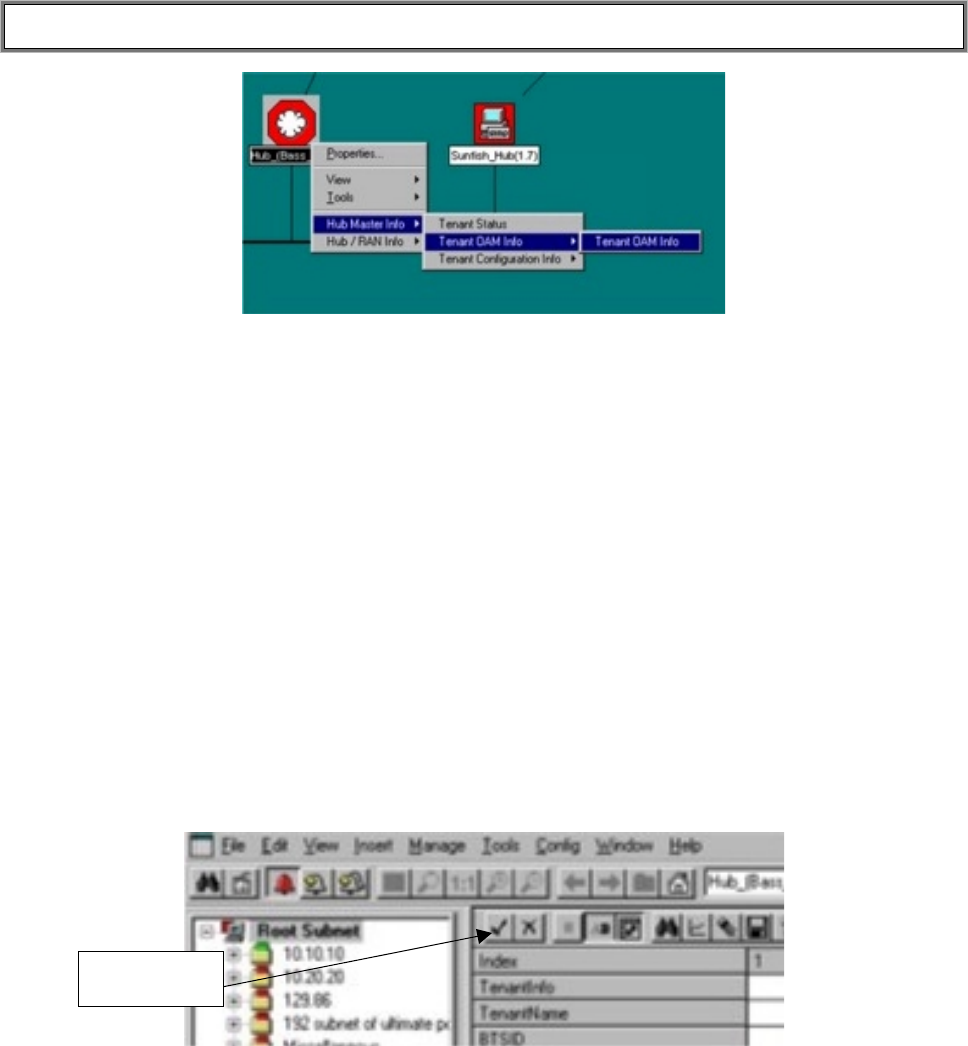
OpenCell Operations and Maintenance Manual Doc. No. XXXXXXX -
TRANSCEPT PROPRIETARY 51
Figure 33. Tenant OAM Info Select
This MIB allows an operator to configure the following parameters:
• Channel #s
• Forward Gain
• Reverse Gain
• BTS to OpenCell cable losses
• Auto function enable/disables
o Forward Autogain/Continuity
o Reverse Autogain/Continuity
o AutoDelay Compensation
Flip the display so that the sector numbers go across the top. Scroll to the desired
sector number (Sectors go from 1-96).
Once changes are made the values change from blue to red. The set button must be
selected for the changes to be accepted.
Figure 34. SNMPc Set Button
Set Button
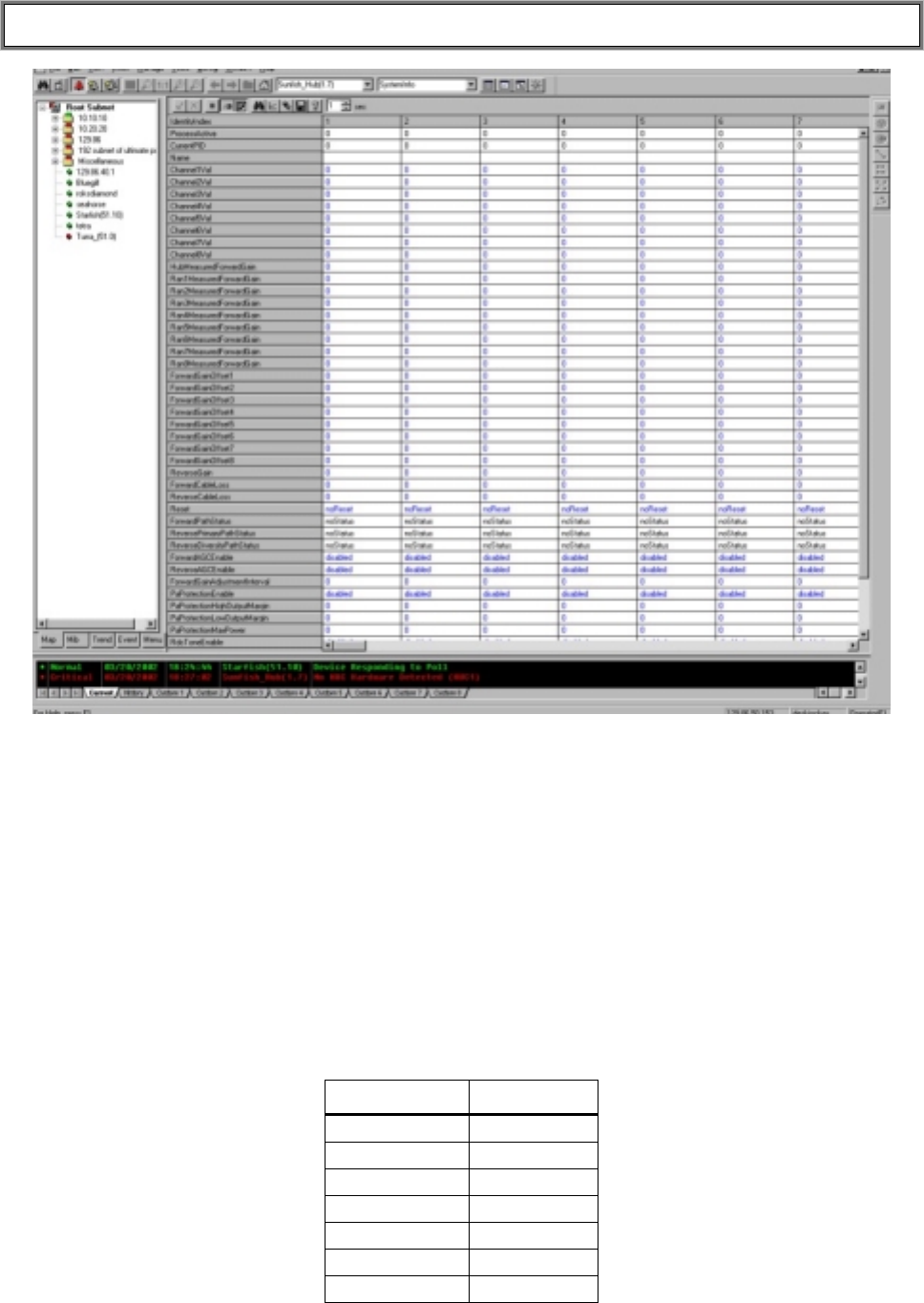
OpenCell Operations and Maintenance Manual Doc. No. XXXXXXX -
TRANSCEPT PROPRIETARY 52
Figure 35. Tenant OAM Info MIB
Scroll to the desired sector number (Sectors go from 1-96) for entering the following
information.
5.5.1 SET Channels
Enter the channel numbers in the Channel1Val-Channel8Val fields.
Channels numbers follow the standard FCC conventions for frequencies and protocols.
Note: If only a single HDC is used by this WSP, then channels 1-4 are valid. If there are
two HDC’s then channels 1-8 are valid.
Note: Unused channels should be set per the following table.
Table 1. Unused Channel Values
Channel Value
1-1
2-2
3-3
4-4
5-5
6-6
7-7

OpenCell Operations and Maintenance Manual Doc. No. XXXXXXX -
TRANSCEPT PROPRIETARY 53
Channel Value
8-8
5.5.2 SET Forward Gain
Enter the desired gain in the ForwardGainOffset1 to ForwardGainOffset8 fields.
The gain is against the baseline OpenCell power levels. 0 dB of gain (the default) will
give the nominal power per channel by protocol and frequency (first entry in each table
row). The gain can be adjusted up from 0 to +8 if a WSP is using less than the baseline
number of carriers and they desire more power at a selected RAN site.
Gain can also be set from –12 to 0 dB if a WSP desires less output power at selected
RAN locations. The baseline powers are shown in the table below.
Typically the gains will be set to zero for all Tenants since that is when the link budgets
match. Optimization a given location may require adjustment from the zero dB gain
settings.

OpenCell Operations and Maintenance Manual Doc. No. XXXXXXX -
TRANSCEPT PROPRIETARY 54
Table 2. Max. Forward Gain Settings as function of #channels
Frequency and Protocol Output (dBm) Max. Gains
Transmitter output power
CDMA (PCS)
3 carriers
1 carrier
6 carriers
30.5
35.0
27.5
0
4.5
-3.0
Transmitter output power
GSM (PCS)
4 carriers
2 carriers
8 carriers
30.5
33.5
27.5
0
3.0
-3.0
Transmitter output power
TDMA (PCS)
6 carriers
4 carriers
2 carriers
8 carriers
28.0
30.0
33.0
27.0
0
2.0
3.0
-1.0
Transmitter output power
CDMA (Cellular/SMR)
3 carriers
1 carrier
6 carrier
29.5
34.0
26.5
0
4.5
-3.0
Transmitter output power
GSM (Cellular/SMR)
4 carriers
2 carriers
8 carriers
29.5
32.5
26.5
0
3.0
-3.0
Transmitter output power
TDMA (Cellular/SMR)
6 carriers
4 carriers
2 carriers
8 carriers
27.0
29.0
32.0
26.0
0
2.0
5.0
-1.0
Transmitter output power
IDEN (Cellular/SMR)
6 carriers
4 carriers
2 carriers
8 carriers
27.0
29.0
32.0
26.0
0
2.0
5.0
-1.0
Note: There is 3.5 dB of loss from PA output to output of RAN for PCS, 2.5 dB in
Cellular and 3.0 dB in SMR. The above output powers are denoted at the output of the
RAN. The PA measured power will be higher.
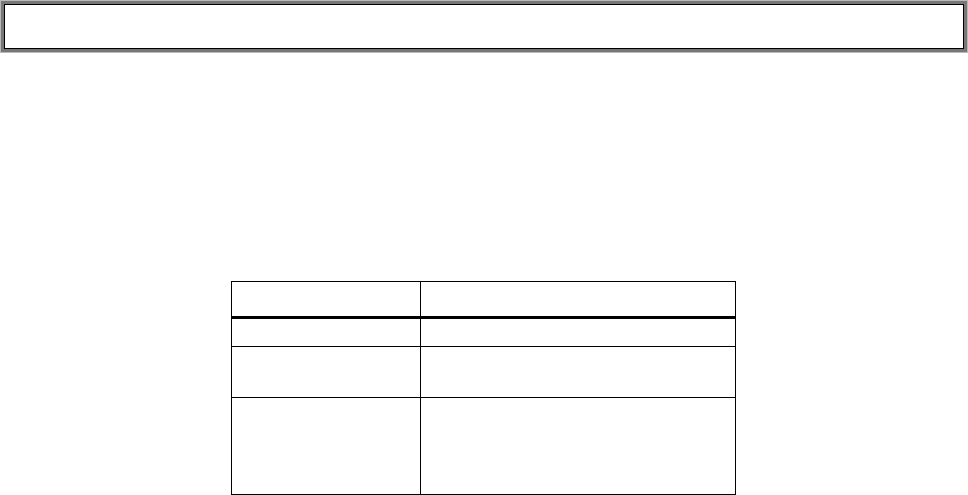
OpenCell Operations and Maintenance Manual Doc. No. XXXXXXX -
TRANSCEPT PROPRIETARY 55
5.5.3 SET Reverse Gain
Enter the desired reverse gain in the ReverseGain field.
Reverse gain indicates how much gain OpenCell will give to a reverse path signal before
presenting it to the BTS (e.g. a –100 dBm signal at the RAN input will be –90 at the input
to the BTS when Reverse Gain is set to 10 dB).
Table 3. Reverse Gain Settings
Reverse Gain (dB) Comment
+10 Normal setting
0 Shared BTS tower sector, 3dB
impact on BTS tower coverage
-10 Shared BTS tower sector, no
impact on BTS tower coverage,
3dB impact on OpenCell
coverage
5.5.4 SET Forward/Reverse Cable losses
Enter the cable loss for the forward connection cable into the ForwardCableLoss field.
Enter the cable loss for the reverse connection cable into the ReverseCableLoss field.
The cables should be swept to insure that their cable loss is correct. This allows
OpenCell to accurately manage the gains in the forward and reverse directions.
5.5.5 SET Auto Functions
The following MIB values should be enabled:
• ForwardAGCEnable – Enables forward gain management
• ReverseAGCEnable – Enables reverse gain management
• DelayCompensationEnable – Enables automatic delay compensation

OpenCell Operations and Maintenance Manual Doc. No. XXXXXXX -
TRANSCEPT PROPRIETARY 56
6.0 INTEGRATION PROCEDURES
6.1 HUB/RAN INTEGRATION
6.1.1 Forward Path Balance
In order to balance the forward path the following procedure is followed:
• Disable PA
• Inject tone into BIM at level to be received from BTS
• Measure power in OpenCell FSC on control channel
• Adjust HDC attenuator to achieve desired power level (0 dBm)
• Enable PA
• Measure output power on PA
• Adjust RUC attenuator to achieve desired output power (24-34 dBm)
• Repeat on all channels
6.1.2 Reverse Path Balance
In order to balance the reverse path the following procedure is followed:
• Measure or calculate cable loss from BIM Output to BTS input
• Enter value into Tenant MIB
• Enter reverse gain setting (-10 to +10 dB, typically +10 dBm)

OpenCell Operations and Maintenance Manual Doc. No. XXXXXXX -
TRANSCEPT PROPRIETARY 57
7.0 BTS INTEGRATION
7.1.1 BTS Parameter Changes – TDMA
BTS/SCCS Parameter Modifications.
Manufacturer Required
Change
Parameter Performance
Problem
Req’d for
OpenCell
Ericsson
Disable DC Bias on BTS Rx Ports BTS Bias Alarm Yes
Increase 10 dB SSB Level (channel sealing
level) Unable to place call
on sealed channel Yes
Increase 8 dB
over BTS-only
settings
SSI (Power Increase) level Repeater/Tower
handoff unbalanced Yes
Increase 8 dB
over BTS-only
settings
SSD (Power Decrease) level Repeater/Tower
handoff unbalanced Yes
Lucent
Enable Shortened Burst Mode No calls initiated Yes
Change from 0
to 2. Page 5 of FCI form, field 94 No calls initiated Yes
Set to 2. (Max
delay setting) If Page 5 is full, go to page 6
of FCI form, field 118 No calls initiated Yes
Disable Hobbit Intracell handoff
occur Yes
Nortel Change from
normal to
ABBREV
DCCHDATA datafill
FIELD 6 No calls initiated Yes
Disable TLR (TDMA Locate
Receiver) No hand ins Yes
Change from
enable to
DISABLE for
each sector pair,
i.e. Z into X as
well as X into Z.
HOPAIR datafill NBHO
field No handoffs or hand
ins Yes
7.1.2 Neighbor List Updates
During initial OpenCell installation, failed mobile hand-offs may be due to outdated or
incorrect neighbor list. Because the OpenCell system has the ability to change the RF
footprint of its donor base station on a sector by sector basis, the neighbor list of the
donor BTS and of each adjacent BTS (based on RF footprint) will require review and
updating where applicable. Without this modification, mobile handoff functionality could
be degraded or even rendered inoperable. For a quick cross-check of the RAN
neighbors, note DCCH channel numbers seen by a mobile as it is moved out radially

OpenCell Operations and Maintenance Manual Doc. No. XXXXXXX -
TRANSCEPT PROPRIETARY 58
from the center of the site. This list should match a network planning list of DCCH
channels and sectors for adjacent BTS/SCCS installations. During this test, if the call
drops due to a low DCCH level in the presence of a large alternate DCCH level, the
neighbor list needs to be reviewed and where applicable updated.
There are other reasons for failed hand-offs, timers, insufficient neighbor signal quality,
interference
7.1.3 BTS Validation
Prior to connecting the base station to the OpenCell Hub a full suite of BTS tests should
be run to assure the BTS is operating per manufacturers specification.
7.1.4 Forward RF Path Balance
This RF path balance is from the Hub input to the RAN output.
In order to balance the forward path the following procedure is followed:
• Disable PA
• Enable channel from BTS (place call to get voice channels, certain channels may
need to be blocked in order to have forward signal)
• Measure power in OpenCell FSC on control channel
• Adjust HDC attenuator to achieve desired power level (0 dBm)
• Enable PA
• Measure output power on PA
• Adjust RUC attenuator to achieve desired output power (24-34 dBm)
• Repeat on all channels
7.1.5 Reverse Path Balance
In order to balance the reverse path the following procedure is followed:
• Measure or calculate cable loss from BIM Output to BTS input
• Enter value into Tenant MIB
• Enter reverse gain setting (-10 to +10 dB, typically +10 dBm)
7.1.6 RAN Call verification
In order to balance the reverse path the following procedure is followed
• Deploy technician to RAN sites
• Place calls on all RF channels